Impacts of Sustainable Development Initiatives on Customer Purchasing: A Study on Waitrose & Partners UK
VerifiedAdded on 2023/05/29
|54
|14907
|75
AI Summary
In this discussion we will discuss about investigation into the impacts of sustainable development and below are the summaries point:-
Investigation into the impacts of sustainable development initiatives on purchasing decisions among customers.
Waitrose & Partners UK chosen as the subject for the research.
Findings indicate a strong influence of sustainable development initiatives on customer buying intentions.
Contribute Materials
Your contribution can guide someone’s learning journey. Share your
documents today.
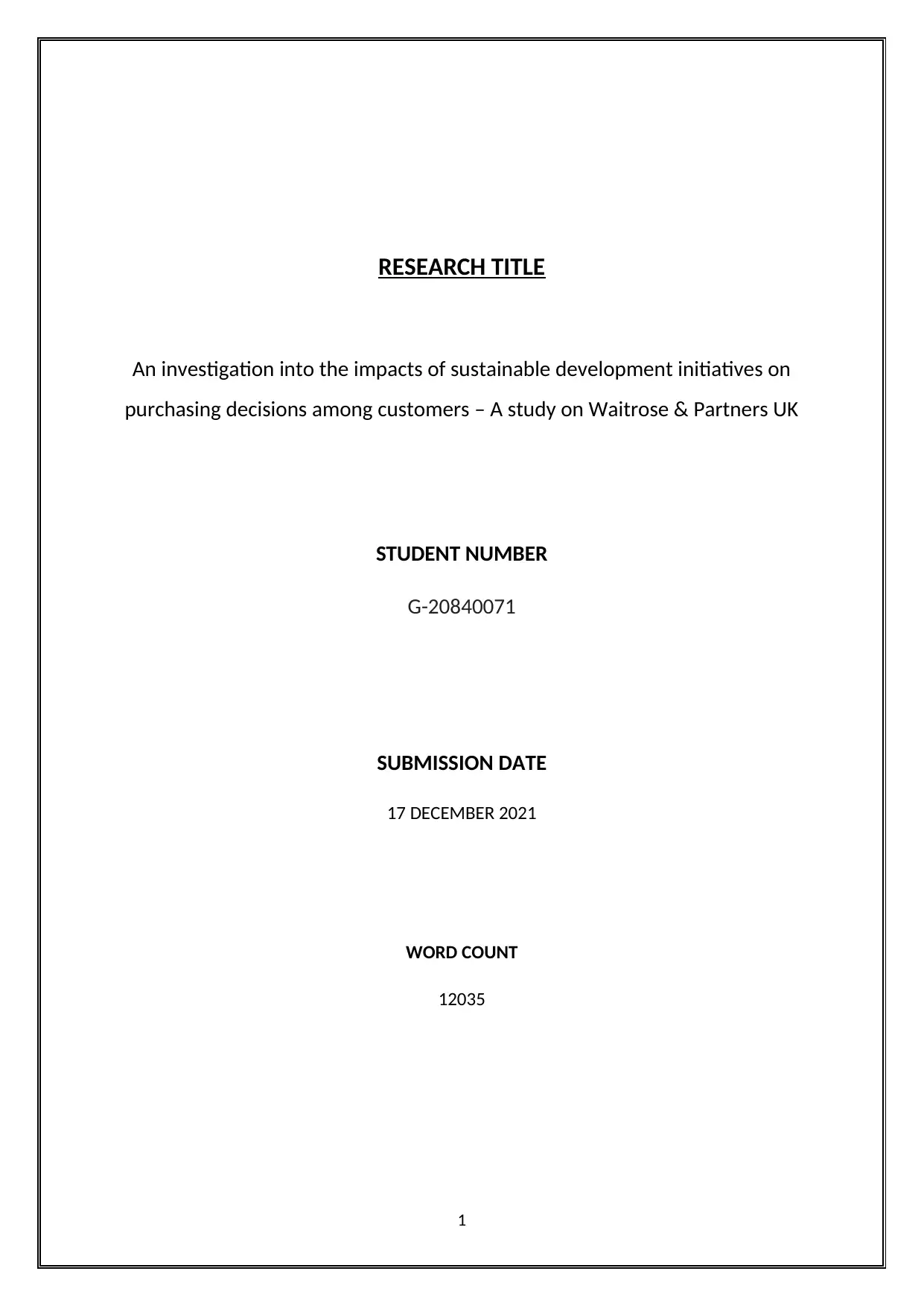
RESEARCH TITLE
An investigation into the impacts of sustainable development initiatives on
purchasing decisions among customers – A study on Waitrose & Partners UK
STUDENT NUMBER
G-20840071
SUBMISSION DATE
17 DECEMBER 2021
WORD COUNT
12035
1
An investigation into the impacts of sustainable development initiatives on
purchasing decisions among customers – A study on Waitrose & Partners UK
STUDENT NUMBER
G-20840071
SUBMISSION DATE
17 DECEMBER 2021
WORD COUNT
12035
1
Secure Best Marks with AI Grader
Need help grading? Try our AI Grader for instant feedback on your assignments.
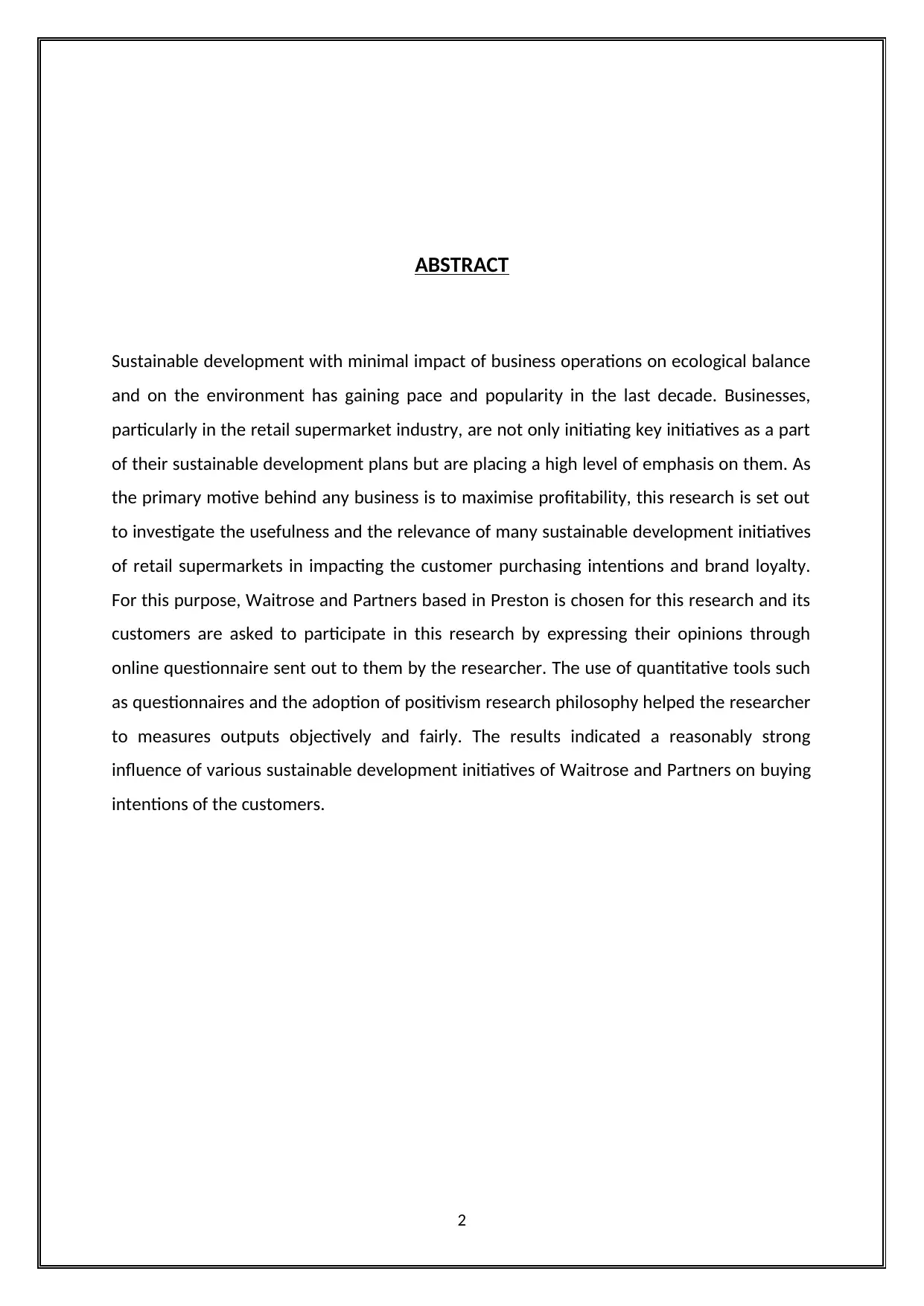
ABSTRACT
Sustainable development with minimal impact of business operations on ecological balance
and on the environment has gaining pace and popularity in the last decade. Businesses,
particularly in the retail supermarket industry, are not only initiating key initiatives as a part
of their sustainable development plans but are placing a high level of emphasis on them. As
the primary motive behind any business is to maximise profitability, this research is set out
to investigate the usefulness and the relevance of many sustainable development initiatives
of retail supermarkets in impacting the customer purchasing intentions and brand loyalty.
For this purpose, Waitrose and Partners based in Preston is chosen for this research and its
customers are asked to participate in this research by expressing their opinions through
online questionnaire sent out to them by the researcher. The use of quantitative tools such
as questionnaires and the adoption of positivism research philosophy helped the researcher
to measures outputs objectively and fairly. The results indicated a reasonably strong
influence of various sustainable development initiatives of Waitrose and Partners on buying
intentions of the customers.
2
Sustainable development with minimal impact of business operations on ecological balance
and on the environment has gaining pace and popularity in the last decade. Businesses,
particularly in the retail supermarket industry, are not only initiating key initiatives as a part
of their sustainable development plans but are placing a high level of emphasis on them. As
the primary motive behind any business is to maximise profitability, this research is set out
to investigate the usefulness and the relevance of many sustainable development initiatives
of retail supermarkets in impacting the customer purchasing intentions and brand loyalty.
For this purpose, Waitrose and Partners based in Preston is chosen for this research and its
customers are asked to participate in this research by expressing their opinions through
online questionnaire sent out to them by the researcher. The use of quantitative tools such
as questionnaires and the adoption of positivism research philosophy helped the researcher
to measures outputs objectively and fairly. The results indicated a reasonably strong
influence of various sustainable development initiatives of Waitrose and Partners on buying
intentions of the customers.
2
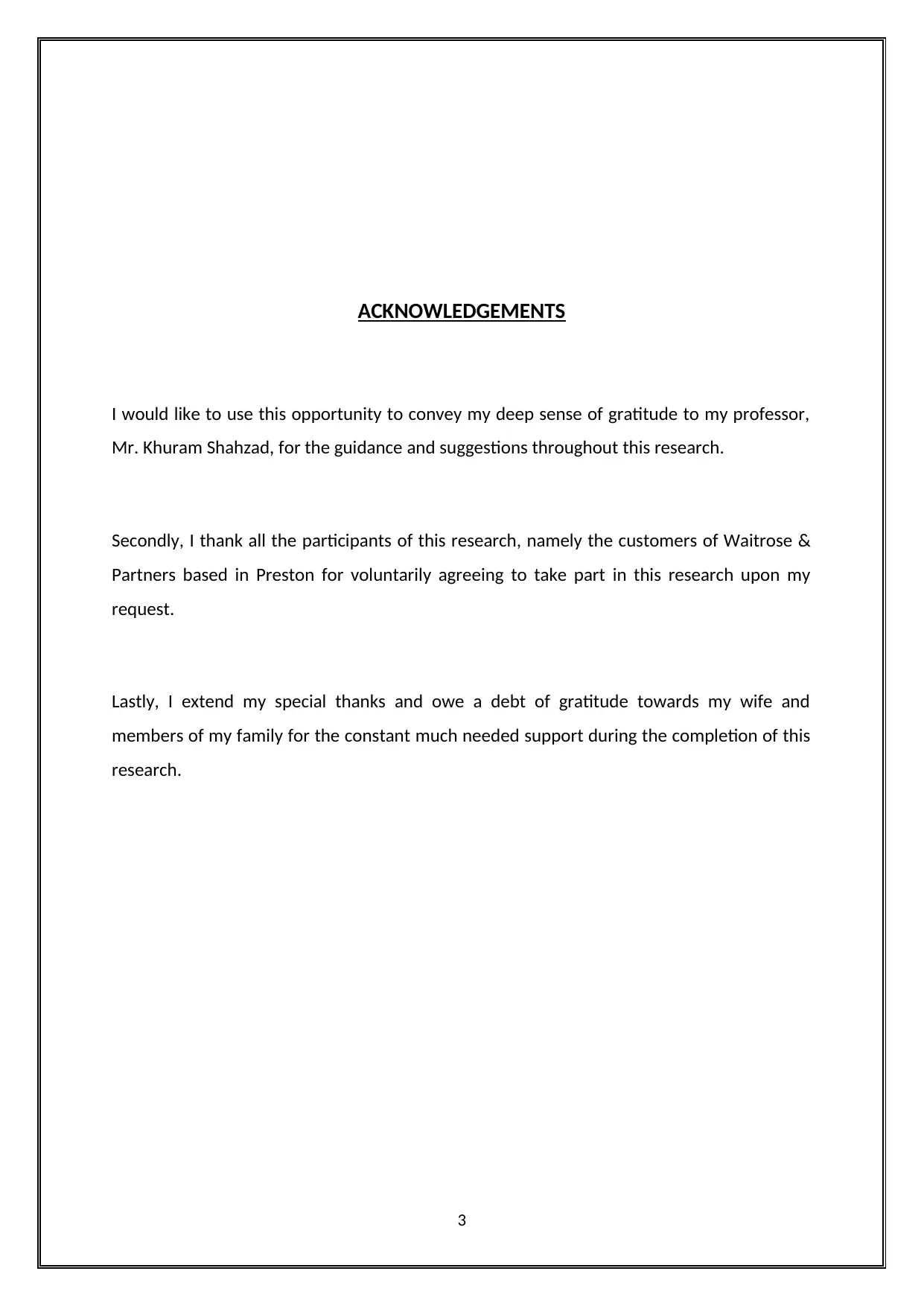
ACKNOWLEDGEMENTS
I would like to use this opportunity to convey my deep sense of gratitude to my professor,
Mr. Khuram Shahzad, for the guidance and suggestions throughout this research.
Secondly, I thank all the participants of this research, namely the customers of Waitrose &
Partners based in Preston for voluntarily agreeing to take part in this research upon my
request.
Lastly, I extend my special thanks and owe a debt of gratitude towards my wife and
members of my family for the constant much needed support during the completion of this
research.
3
I would like to use this opportunity to convey my deep sense of gratitude to my professor,
Mr. Khuram Shahzad, for the guidance and suggestions throughout this research.
Secondly, I thank all the participants of this research, namely the customers of Waitrose &
Partners based in Preston for voluntarily agreeing to take part in this research upon my
request.
Lastly, I extend my special thanks and owe a debt of gratitude towards my wife and
members of my family for the constant much needed support during the completion of this
research.
3

Table of Contents
CHAPTER ONE – INTRODUCTION...........................................................................................................5
Background of the research...............................................................................................................5
Research Aim & Objectives................................................................................................................6
Research Questions...........................................................................................................................6
Rationale behind this research..........................................................................................................7
Structure of the report......................................................................................................................7
CHAPTER TWO - LITERATURE REVIEW..................................................................................................8
Sustainability and consumer behaviour.............................................................................................8
Socio-economic profile of customers................................................................................................9
Barriers for initiating sustainability development..............................................................................9
Difference between sustainability awareness and action among customers..................................12
Business ethics theories and ethical consumerism implications......................................................14
Trends of Ethical Consumerism in the UK........................................................................................15
Effect of information sources on the decisions of consumer purchasing........................................17
Conceptualising ethical consumption..............................................................................................18
Literature Gaps................................................................................................................................20
Conceptual Framework...................................................................................................................20
CHAPTER THREE – RESEARCH METHDOLOGY......................................................................................22
Introduction.....................................................................................................................................22
Research Philosophy........................................................................................................................22
Research Approach..........................................................................................................................23
Research Methods...........................................................................................................................24
Sample Size and its characteristics..................................................................................................24
Data Collection and Analysis............................................................................................................25
Ethical Considerations.....................................................................................................................25
Validity, Reliability, Transferability..................................................................................................25
Conclusion.......................................................................................................................................25
CHAPTER FOUR – ANALYSIS AND FINDINGS........................................................................................27
FINDINGS AND DISCUSSION............................................................................................................37
Key themes from the data analysis..................................................................................................39
CHAPTER FIVE – CONCLUSIONS...........................................................................................................42
REFERENCES........................................................................................................................................44
APPENDICES.........................................................................................................................................47
4
CHAPTER ONE – INTRODUCTION...........................................................................................................5
Background of the research...............................................................................................................5
Research Aim & Objectives................................................................................................................6
Research Questions...........................................................................................................................6
Rationale behind this research..........................................................................................................7
Structure of the report......................................................................................................................7
CHAPTER TWO - LITERATURE REVIEW..................................................................................................8
Sustainability and consumer behaviour.............................................................................................8
Socio-economic profile of customers................................................................................................9
Barriers for initiating sustainability development..............................................................................9
Difference between sustainability awareness and action among customers..................................12
Business ethics theories and ethical consumerism implications......................................................14
Trends of Ethical Consumerism in the UK........................................................................................15
Effect of information sources on the decisions of consumer purchasing........................................17
Conceptualising ethical consumption..............................................................................................18
Literature Gaps................................................................................................................................20
Conceptual Framework...................................................................................................................20
CHAPTER THREE – RESEARCH METHDOLOGY......................................................................................22
Introduction.....................................................................................................................................22
Research Philosophy........................................................................................................................22
Research Approach..........................................................................................................................23
Research Methods...........................................................................................................................24
Sample Size and its characteristics..................................................................................................24
Data Collection and Analysis............................................................................................................25
Ethical Considerations.....................................................................................................................25
Validity, Reliability, Transferability..................................................................................................25
Conclusion.......................................................................................................................................25
CHAPTER FOUR – ANALYSIS AND FINDINGS........................................................................................27
FINDINGS AND DISCUSSION............................................................................................................37
Key themes from the data analysis..................................................................................................39
CHAPTER FIVE – CONCLUSIONS...........................................................................................................42
REFERENCES........................................................................................................................................44
APPENDICES.........................................................................................................................................47
4
Secure Best Marks with AI Grader
Need help grading? Try our AI Grader for instant feedback on your assignments.
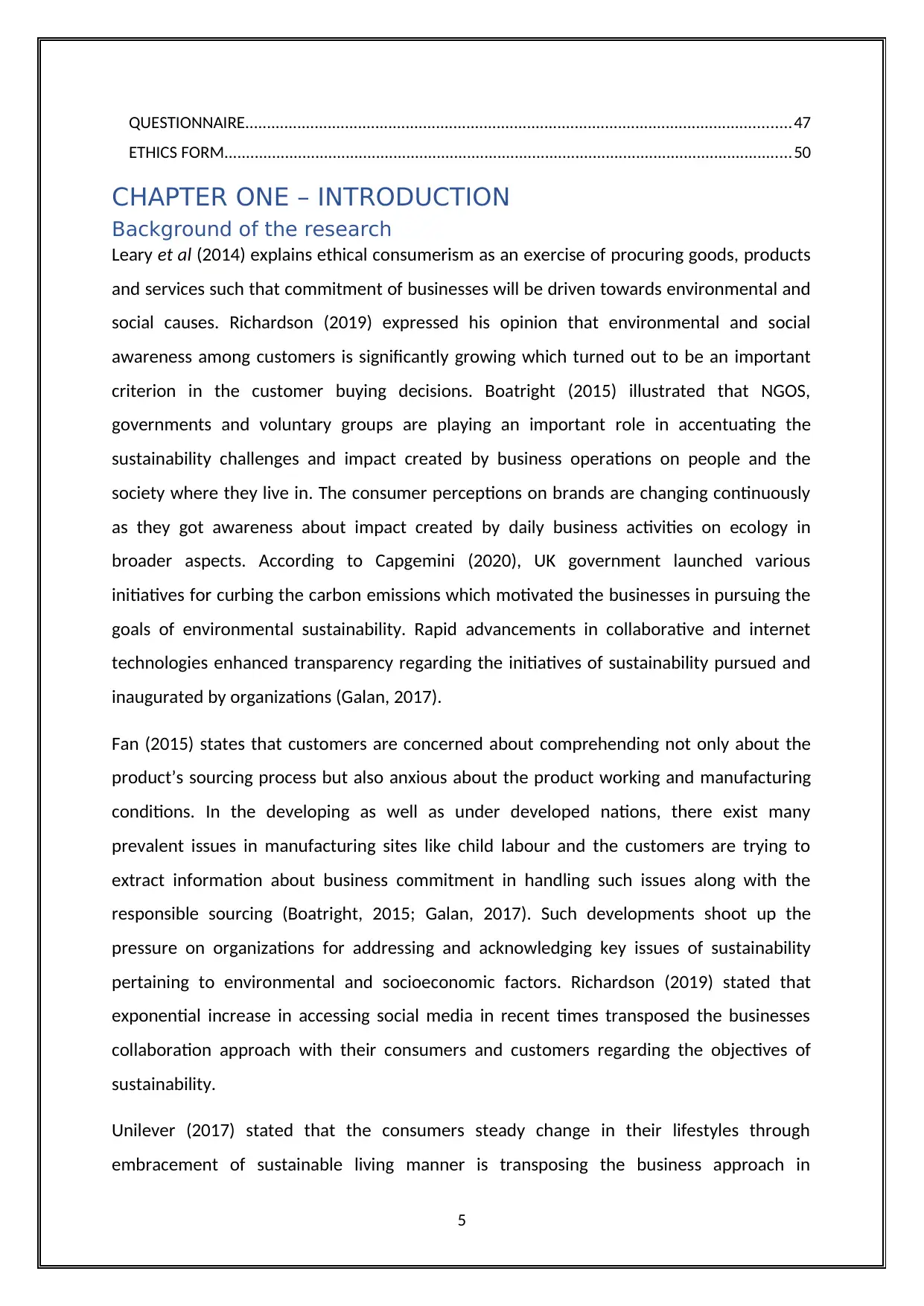
QUESTIONNAIRE..............................................................................................................................47
ETHICS FORM...................................................................................................................................50
CHAPTER ONE – INTRODUCTION
Background of the research
Leary et al (2014) explains ethical consumerism as an exercise of procuring goods, products
and services such that commitment of businesses will be driven towards environmental and
social causes. Richardson (2019) expressed his opinion that environmental and social
awareness among customers is significantly growing which turned out to be an important
criterion in the customer buying decisions. Boatright (2015) illustrated that NGOS,
governments and voluntary groups are playing an important role in accentuating the
sustainability challenges and impact created by business operations on people and the
society where they live in. The consumer perceptions on brands are changing continuously
as they got awareness about impact created by daily business activities on ecology in
broader aspects. According to Capgemini (2020), UK government launched various
initiatives for curbing the carbon emissions which motivated the businesses in pursuing the
goals of environmental sustainability. Rapid advancements in collaborative and internet
technologies enhanced transparency regarding the initiatives of sustainability pursued and
inaugurated by organizations (Galan, 2017).
Fan (2015) states that customers are concerned about comprehending not only about the
product’s sourcing process but also anxious about the product working and manufacturing
conditions. In the developing as well as under developed nations, there exist many
prevalent issues in manufacturing sites like child labour and the customers are trying to
extract information about business commitment in handling such issues along with the
responsible sourcing (Boatright, 2015; Galan, 2017). Such developments shoot up the
pressure on organizations for addressing and acknowledging key issues of sustainability
pertaining to environmental and socioeconomic factors. Richardson (2019) stated that
exponential increase in accessing social media in recent times transposed the businesses
collaboration approach with their consumers and customers regarding the objectives of
sustainability.
Unilever (2017) stated that the consumers steady change in their lifestyles through
embracement of sustainable living manner is transposing the business approach in
5
ETHICS FORM...................................................................................................................................50
CHAPTER ONE – INTRODUCTION
Background of the research
Leary et al (2014) explains ethical consumerism as an exercise of procuring goods, products
and services such that commitment of businesses will be driven towards environmental and
social causes. Richardson (2019) expressed his opinion that environmental and social
awareness among customers is significantly growing which turned out to be an important
criterion in the customer buying decisions. Boatright (2015) illustrated that NGOS,
governments and voluntary groups are playing an important role in accentuating the
sustainability challenges and impact created by business operations on people and the
society where they live in. The consumer perceptions on brands are changing continuously
as they got awareness about impact created by daily business activities on ecology in
broader aspects. According to Capgemini (2020), UK government launched various
initiatives for curbing the carbon emissions which motivated the businesses in pursuing the
goals of environmental sustainability. Rapid advancements in collaborative and internet
technologies enhanced transparency regarding the initiatives of sustainability pursued and
inaugurated by organizations (Galan, 2017).
Fan (2015) states that customers are concerned about comprehending not only about the
product’s sourcing process but also anxious about the product working and manufacturing
conditions. In the developing as well as under developed nations, there exist many
prevalent issues in manufacturing sites like child labour and the customers are trying to
extract information about business commitment in handling such issues along with the
responsible sourcing (Boatright, 2015; Galan, 2017). Such developments shoot up the
pressure on organizations for addressing and acknowledging key issues of sustainability
pertaining to environmental and socioeconomic factors. Richardson (2019) stated that
exponential increase in accessing social media in recent times transposed the businesses
collaboration approach with their consumers and customers regarding the objectives of
sustainability.
Unilever (2017) stated that the consumers steady change in their lifestyles through
embracement of sustainable living manner is transposing the business approach in
5
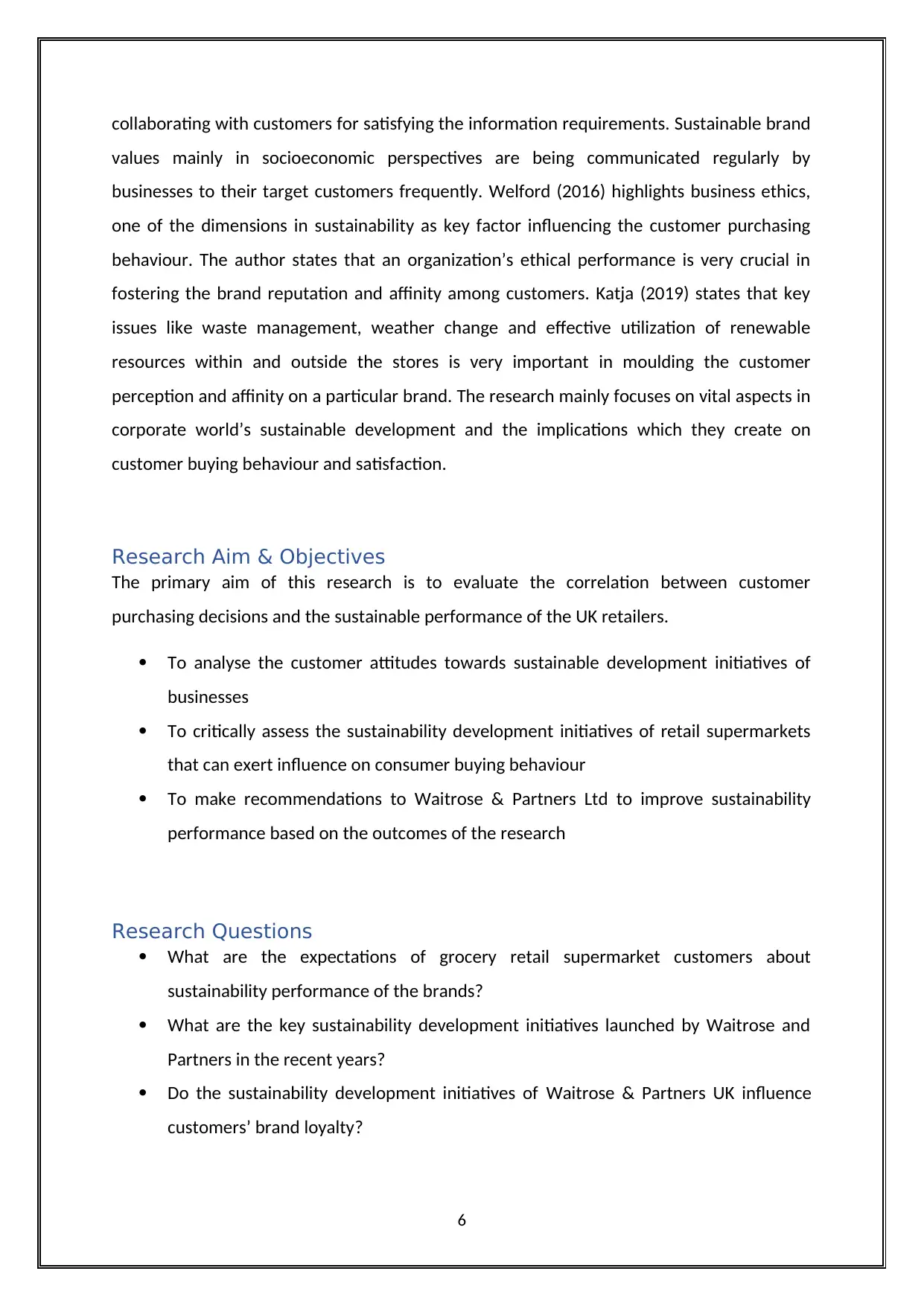
collaborating with customers for satisfying the information requirements. Sustainable brand
values mainly in socioeconomic perspectives are being communicated regularly by
businesses to their target customers frequently. Welford (2016) highlights business ethics,
one of the dimensions in sustainability as key factor influencing the customer purchasing
behaviour. The author states that an organization’s ethical performance is very crucial in
fostering the brand reputation and affinity among customers. Katja (2019) states that key
issues like waste management, weather change and effective utilization of renewable
resources within and outside the stores is very important in moulding the customer
perception and affinity on a particular brand. The research mainly focuses on vital aspects in
corporate world’s sustainable development and the implications which they create on
customer buying behaviour and satisfaction.
Research Aim & Objectives
The primary aim of this research is to evaluate the correlation between customer
purchasing decisions and the sustainable performance of the UK retailers.
To analyse the customer attitudes towards sustainable development initiatives of
businesses
To critically assess the sustainability development initiatives of retail supermarkets
that can exert influence on consumer buying behaviour
To make recommendations to Waitrose & Partners Ltd to improve sustainability
performance based on the outcomes of the research
Research Questions
What are the expectations of grocery retail supermarket customers about
sustainability performance of the brands?
What are the key sustainability development initiatives launched by Waitrose and
Partners in the recent years?
Do the sustainability development initiatives of Waitrose & Partners UK influence
customers’ brand loyalty?
6
values mainly in socioeconomic perspectives are being communicated regularly by
businesses to their target customers frequently. Welford (2016) highlights business ethics,
one of the dimensions in sustainability as key factor influencing the customer purchasing
behaviour. The author states that an organization’s ethical performance is very crucial in
fostering the brand reputation and affinity among customers. Katja (2019) states that key
issues like waste management, weather change and effective utilization of renewable
resources within and outside the stores is very important in moulding the customer
perception and affinity on a particular brand. The research mainly focuses on vital aspects in
corporate world’s sustainable development and the implications which they create on
customer buying behaviour and satisfaction.
Research Aim & Objectives
The primary aim of this research is to evaluate the correlation between customer
purchasing decisions and the sustainable performance of the UK retailers.
To analyse the customer attitudes towards sustainable development initiatives of
businesses
To critically assess the sustainability development initiatives of retail supermarkets
that can exert influence on consumer buying behaviour
To make recommendations to Waitrose & Partners Ltd to improve sustainability
performance based on the outcomes of the research
Research Questions
What are the expectations of grocery retail supermarket customers about
sustainability performance of the brands?
What are the key sustainability development initiatives launched by Waitrose and
Partners in the recent years?
Do the sustainability development initiatives of Waitrose & Partners UK influence
customers’ brand loyalty?
6
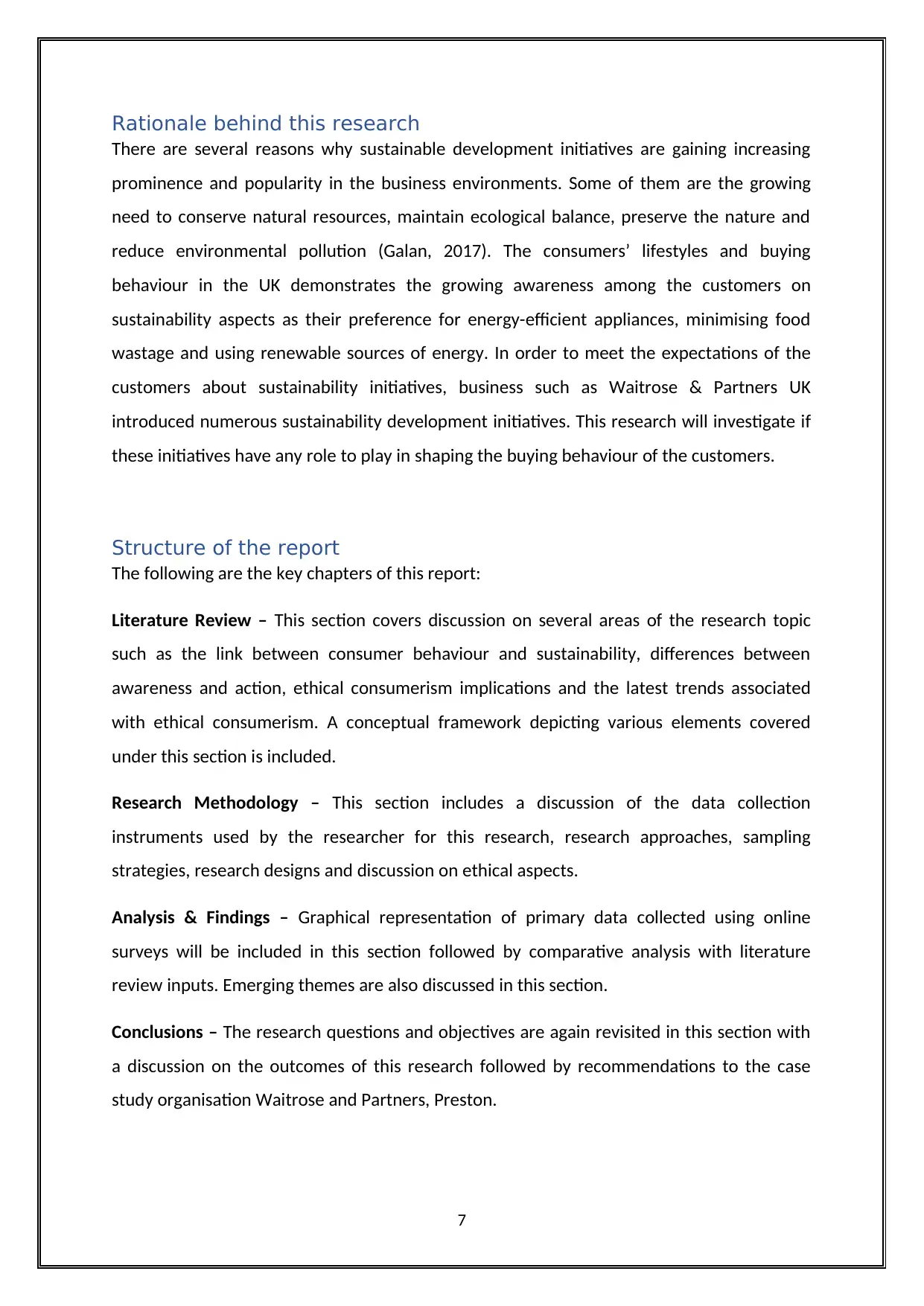
Rationale behind this research
There are several reasons why sustainable development initiatives are gaining increasing
prominence and popularity in the business environments. Some of them are the growing
need to conserve natural resources, maintain ecological balance, preserve the nature and
reduce environmental pollution (Galan, 2017). The consumers’ lifestyles and buying
behaviour in the UK demonstrates the growing awareness among the customers on
sustainability aspects as their preference for energy-efficient appliances, minimising food
wastage and using renewable sources of energy. In order to meet the expectations of the
customers about sustainability initiatives, business such as Waitrose & Partners UK
introduced numerous sustainability development initiatives. This research will investigate if
these initiatives have any role to play in shaping the buying behaviour of the customers.
Structure of the report
The following are the key chapters of this report:
Literature Review – This section covers discussion on several areas of the research topic
such as the link between consumer behaviour and sustainability, differences between
awareness and action, ethical consumerism implications and the latest trends associated
with ethical consumerism. A conceptual framework depicting various elements covered
under this section is included.
Research Methodology – This section includes a discussion of the data collection
instruments used by the researcher for this research, research approaches, sampling
strategies, research designs and discussion on ethical aspects.
Analysis & Findings – Graphical representation of primary data collected using online
surveys will be included in this section followed by comparative analysis with literature
review inputs. Emerging themes are also discussed in this section.
Conclusions – The research questions and objectives are again revisited in this section with
a discussion on the outcomes of this research followed by recommendations to the case
study organisation Waitrose and Partners, Preston.
7
There are several reasons why sustainable development initiatives are gaining increasing
prominence and popularity in the business environments. Some of them are the growing
need to conserve natural resources, maintain ecological balance, preserve the nature and
reduce environmental pollution (Galan, 2017). The consumers’ lifestyles and buying
behaviour in the UK demonstrates the growing awareness among the customers on
sustainability aspects as their preference for energy-efficient appliances, minimising food
wastage and using renewable sources of energy. In order to meet the expectations of the
customers about sustainability initiatives, business such as Waitrose & Partners UK
introduced numerous sustainability development initiatives. This research will investigate if
these initiatives have any role to play in shaping the buying behaviour of the customers.
Structure of the report
The following are the key chapters of this report:
Literature Review – This section covers discussion on several areas of the research topic
such as the link between consumer behaviour and sustainability, differences between
awareness and action, ethical consumerism implications and the latest trends associated
with ethical consumerism. A conceptual framework depicting various elements covered
under this section is included.
Research Methodology – This section includes a discussion of the data collection
instruments used by the researcher for this research, research approaches, sampling
strategies, research designs and discussion on ethical aspects.
Analysis & Findings – Graphical representation of primary data collected using online
surveys will be included in this section followed by comparative analysis with literature
review inputs. Emerging themes are also discussed in this section.
Conclusions – The research questions and objectives are again revisited in this section with
a discussion on the outcomes of this research followed by recommendations to the case
study organisation Waitrose and Partners, Preston.
7
Paraphrase This Document
Need a fresh take? Get an instant paraphrase of this document with our AI Paraphraser
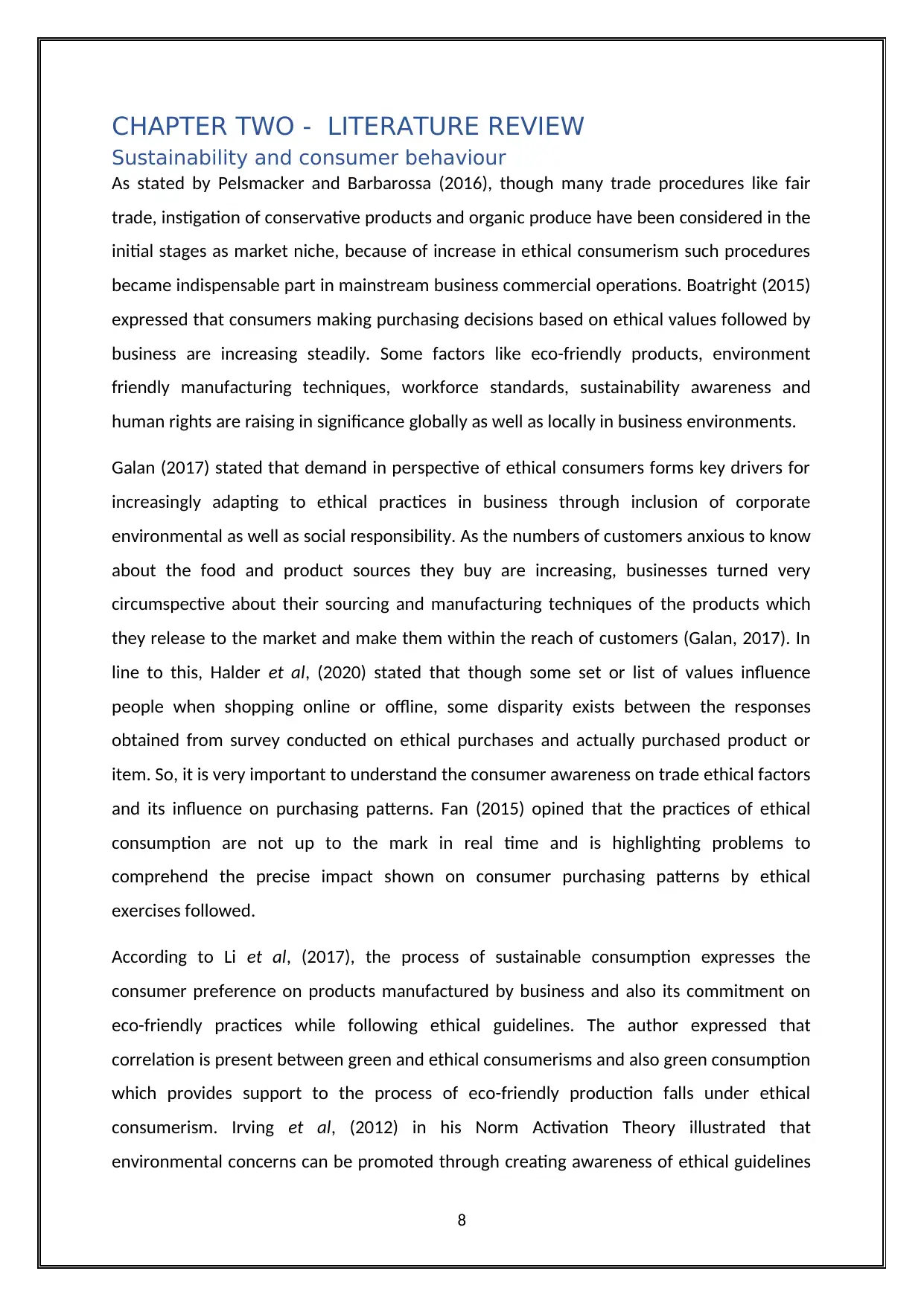
CHAPTER TWO - LITERATURE REVIEW
Sustainability and consumer behaviour
As stated by Pelsmacker and Barbarossa (2016), though many trade procedures like fair
trade, instigation of conservative products and organic produce have been considered in the
initial stages as market niche, because of increase in ethical consumerism such procedures
became indispensable part in mainstream business commercial operations. Boatright (2015)
expressed that consumers making purchasing decisions based on ethical values followed by
business are increasing steadily. Some factors like eco-friendly products, environment
friendly manufacturing techniques, workforce standards, sustainability awareness and
human rights are raising in significance globally as well as locally in business environments.
Galan (2017) stated that demand in perspective of ethical consumers forms key drivers for
increasingly adapting to ethical practices in business through inclusion of corporate
environmental as well as social responsibility. As the numbers of customers anxious to know
about the food and product sources they buy are increasing, businesses turned very
circumspective about their sourcing and manufacturing techniques of the products which
they release to the market and make them within the reach of customers (Galan, 2017). In
line to this, Halder et al, (2020) stated that though some set or list of values influence
people when shopping online or offline, some disparity exists between the responses
obtained from survey conducted on ethical purchases and actually purchased product or
item. So, it is very important to understand the consumer awareness on trade ethical factors
and its influence on purchasing patterns. Fan (2015) opined that the practices of ethical
consumption are not up to the mark in real time and is highlighting problems to
comprehend the precise impact shown on consumer purchasing patterns by ethical
exercises followed.
According to Li et al, (2017), the process of sustainable consumption expresses the
consumer preference on products manufactured by business and also its commitment on
eco-friendly practices while following ethical guidelines. The author expressed that
correlation is present between green and ethical consumerisms and also green consumption
which provides support to the process of eco-friendly production falls under ethical
consumerism. Irving et al, (2012) in his Norm Activation Theory illustrated that
environmental concerns can be promoted through creating awareness of ethical guidelines
8
Sustainability and consumer behaviour
As stated by Pelsmacker and Barbarossa (2016), though many trade procedures like fair
trade, instigation of conservative products and organic produce have been considered in the
initial stages as market niche, because of increase in ethical consumerism such procedures
became indispensable part in mainstream business commercial operations. Boatright (2015)
expressed that consumers making purchasing decisions based on ethical values followed by
business are increasing steadily. Some factors like eco-friendly products, environment
friendly manufacturing techniques, workforce standards, sustainability awareness and
human rights are raising in significance globally as well as locally in business environments.
Galan (2017) stated that demand in perspective of ethical consumers forms key drivers for
increasingly adapting to ethical practices in business through inclusion of corporate
environmental as well as social responsibility. As the numbers of customers anxious to know
about the food and product sources they buy are increasing, businesses turned very
circumspective about their sourcing and manufacturing techniques of the products which
they release to the market and make them within the reach of customers (Galan, 2017). In
line to this, Halder et al, (2020) stated that though some set or list of values influence
people when shopping online or offline, some disparity exists between the responses
obtained from survey conducted on ethical purchases and actually purchased product or
item. So, it is very important to understand the consumer awareness on trade ethical factors
and its influence on purchasing patterns. Fan (2015) opined that the practices of ethical
consumption are not up to the mark in real time and is highlighting problems to
comprehend the precise impact shown on consumer purchasing patterns by ethical
exercises followed.
According to Li et al, (2017), the process of sustainable consumption expresses the
consumer preference on products manufactured by business and also its commitment on
eco-friendly practices while following ethical guidelines. The author expressed that
correlation is present between green and ethical consumerisms and also green consumption
which provides support to the process of eco-friendly production falls under ethical
consumerism. Irving et al, (2012) in his Norm Activation Theory illustrated that
environmental concerns can be promoted through creating awareness of ethical guidelines
8
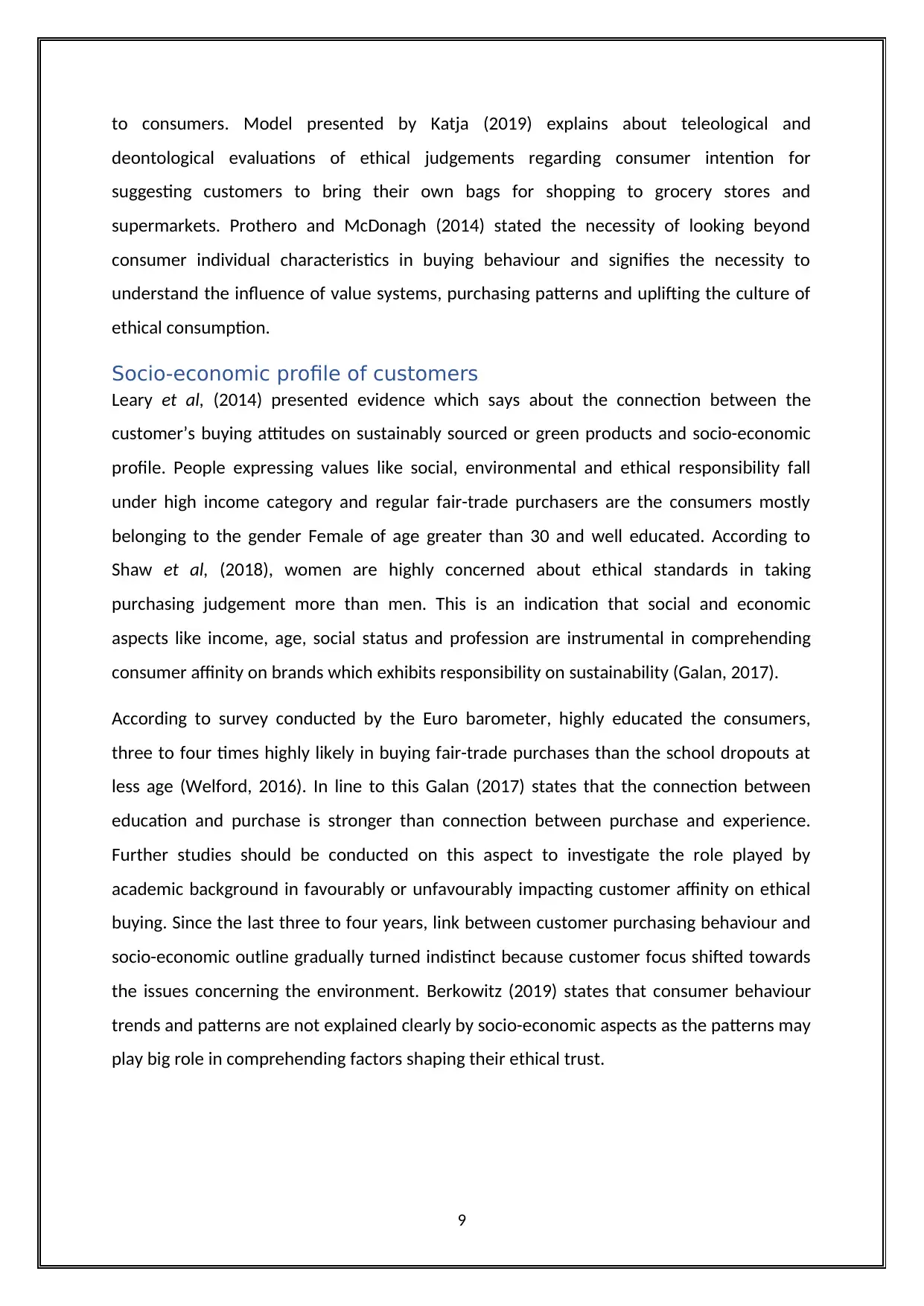
to consumers. Model presented by Katja (2019) explains about teleological and
deontological evaluations of ethical judgements regarding consumer intention for
suggesting customers to bring their own bags for shopping to grocery stores and
supermarkets. Prothero and McDonagh (2014) stated the necessity of looking beyond
consumer individual characteristics in buying behaviour and signifies the necessity to
understand the influence of value systems, purchasing patterns and uplifting the culture of
ethical consumption.
Socio-economic profile of customers
Leary et al, (2014) presented evidence which says about the connection between the
customer’s buying attitudes on sustainably sourced or green products and socio-economic
profile. People expressing values like social, environmental and ethical responsibility fall
under high income category and regular fair-trade purchasers are the consumers mostly
belonging to the gender Female of age greater than 30 and well educated. According to
Shaw et al, (2018), women are highly concerned about ethical standards in taking
purchasing judgement more than men. This is an indication that social and economic
aspects like income, age, social status and profession are instrumental in comprehending
consumer affinity on brands which exhibits responsibility on sustainability (Galan, 2017).
According to survey conducted by the Euro barometer, highly educated the consumers,
three to four times highly likely in buying fair-trade purchases than the school dropouts at
less age (Welford, 2016). In line to this Galan (2017) states that the connection between
education and purchase is stronger than connection between purchase and experience.
Further studies should be conducted on this aspect to investigate the role played by
academic background in favourably or unfavourably impacting customer affinity on ethical
buying. Since the last three to four years, link between customer purchasing behaviour and
socio-economic outline gradually turned indistinct because customer focus shifted towards
the issues concerning the environment. Berkowitz (2019) states that consumer behaviour
trends and patterns are not explained clearly by socio-economic aspects as the patterns may
play big role in comprehending factors shaping their ethical trust.
9
deontological evaluations of ethical judgements regarding consumer intention for
suggesting customers to bring their own bags for shopping to grocery stores and
supermarkets. Prothero and McDonagh (2014) stated the necessity of looking beyond
consumer individual characteristics in buying behaviour and signifies the necessity to
understand the influence of value systems, purchasing patterns and uplifting the culture of
ethical consumption.
Socio-economic profile of customers
Leary et al, (2014) presented evidence which says about the connection between the
customer’s buying attitudes on sustainably sourced or green products and socio-economic
profile. People expressing values like social, environmental and ethical responsibility fall
under high income category and regular fair-trade purchasers are the consumers mostly
belonging to the gender Female of age greater than 30 and well educated. According to
Shaw et al, (2018), women are highly concerned about ethical standards in taking
purchasing judgement more than men. This is an indication that social and economic
aspects like income, age, social status and profession are instrumental in comprehending
consumer affinity on brands which exhibits responsibility on sustainability (Galan, 2017).
According to survey conducted by the Euro barometer, highly educated the consumers,
three to four times highly likely in buying fair-trade purchases than the school dropouts at
less age (Welford, 2016). In line to this Galan (2017) states that the connection between
education and purchase is stronger than connection between purchase and experience.
Further studies should be conducted on this aspect to investigate the role played by
academic background in favourably or unfavourably impacting customer affinity on ethical
buying. Since the last three to four years, link between customer purchasing behaviour and
socio-economic outline gradually turned indistinct because customer focus shifted towards
the issues concerning the environment. Berkowitz (2019) states that consumer behaviour
trends and patterns are not explained clearly by socio-economic aspects as the patterns may
play big role in comprehending factors shaping their ethical trust.
9
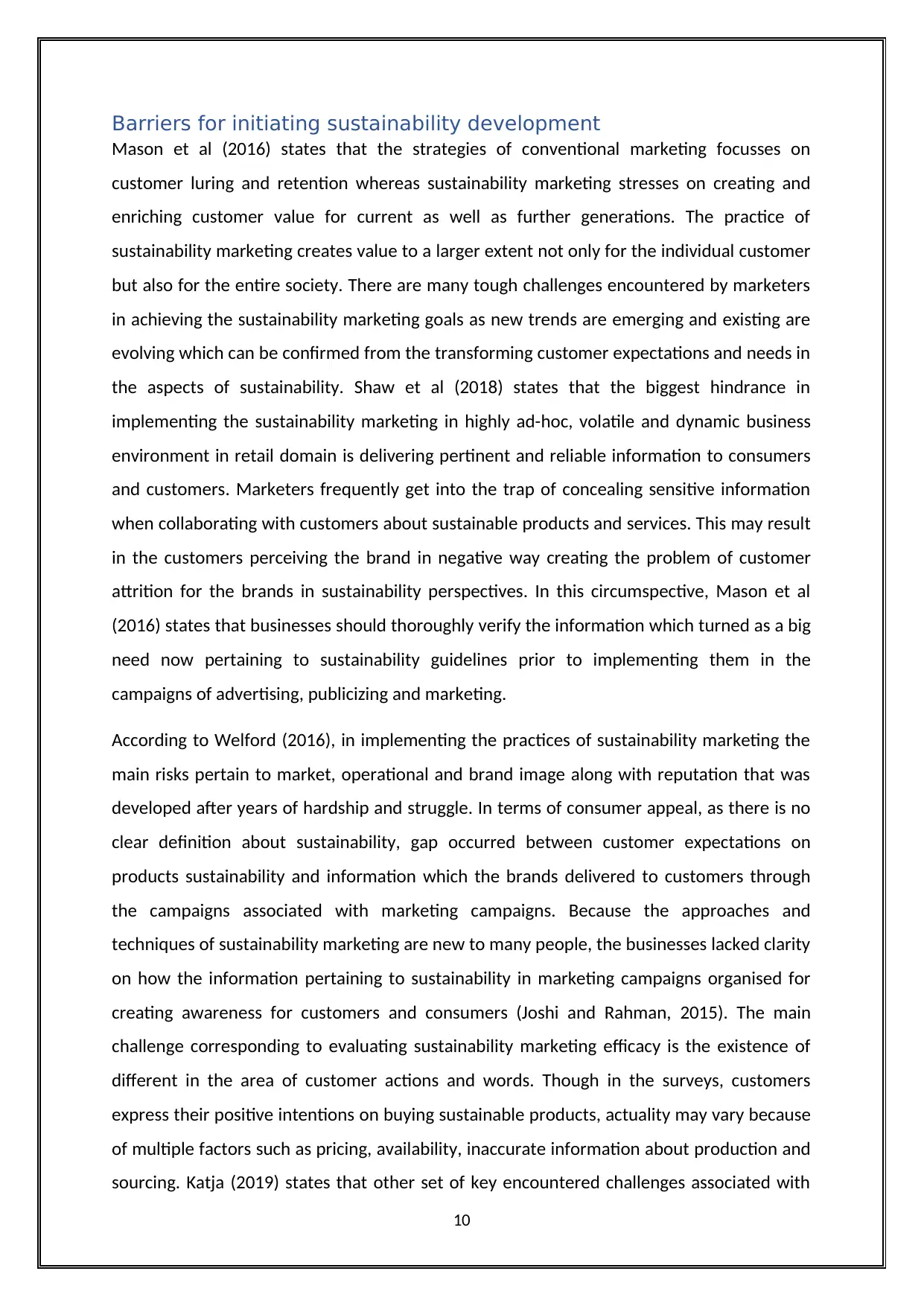
Barriers for initiating sustainability development
Mason et al (2016) states that the strategies of conventional marketing focusses on
customer luring and retention whereas sustainability marketing stresses on creating and
enriching customer value for current as well as further generations. The practice of
sustainability marketing creates value to a larger extent not only for the individual customer
but also for the entire society. There are many tough challenges encountered by marketers
in achieving the sustainability marketing goals as new trends are emerging and existing are
evolving which can be confirmed from the transforming customer expectations and needs in
the aspects of sustainability. Shaw et al (2018) states that the biggest hindrance in
implementing the sustainability marketing in highly ad-hoc, volatile and dynamic business
environment in retail domain is delivering pertinent and reliable information to consumers
and customers. Marketers frequently get into the trap of concealing sensitive information
when collaborating with customers about sustainable products and services. This may result
in the customers perceiving the brand in negative way creating the problem of customer
attrition for the brands in sustainability perspectives. In this circumspective, Mason et al
(2016) states that businesses should thoroughly verify the information which turned as a big
need now pertaining to sustainability guidelines prior to implementing them in the
campaigns of advertising, publicizing and marketing.
According to Welford (2016), in implementing the practices of sustainability marketing the
main risks pertain to market, operational and brand image along with reputation that was
developed after years of hardship and struggle. In terms of consumer appeal, as there is no
clear definition about sustainability, gap occurred between customer expectations on
products sustainability and information which the brands delivered to customers through
the campaigns associated with marketing campaigns. Because the approaches and
techniques of sustainability marketing are new to many people, the businesses lacked clarity
on how the information pertaining to sustainability in marketing campaigns organised for
creating awareness for customers and consumers (Joshi and Rahman, 2015). The main
challenge corresponding to evaluating sustainability marketing efficacy is the existence of
different in the area of customer actions and words. Though in the surveys, customers
express their positive intentions on buying sustainable products, actuality may vary because
of multiple factors such as pricing, availability, inaccurate information about production and
sourcing. Katja (2019) states that other set of key encountered challenges associated with
10
Mason et al (2016) states that the strategies of conventional marketing focusses on
customer luring and retention whereas sustainability marketing stresses on creating and
enriching customer value for current as well as further generations. The practice of
sustainability marketing creates value to a larger extent not only for the individual customer
but also for the entire society. There are many tough challenges encountered by marketers
in achieving the sustainability marketing goals as new trends are emerging and existing are
evolving which can be confirmed from the transforming customer expectations and needs in
the aspects of sustainability. Shaw et al (2018) states that the biggest hindrance in
implementing the sustainability marketing in highly ad-hoc, volatile and dynamic business
environment in retail domain is delivering pertinent and reliable information to consumers
and customers. Marketers frequently get into the trap of concealing sensitive information
when collaborating with customers about sustainable products and services. This may result
in the customers perceiving the brand in negative way creating the problem of customer
attrition for the brands in sustainability perspectives. In this circumspective, Mason et al
(2016) states that businesses should thoroughly verify the information which turned as a big
need now pertaining to sustainability guidelines prior to implementing them in the
campaigns of advertising, publicizing and marketing.
According to Welford (2016), in implementing the practices of sustainability marketing the
main risks pertain to market, operational and brand image along with reputation that was
developed after years of hardship and struggle. In terms of consumer appeal, as there is no
clear definition about sustainability, gap occurred between customer expectations on
products sustainability and information which the brands delivered to customers through
the campaigns associated with marketing campaigns. Because the approaches and
techniques of sustainability marketing are new to many people, the businesses lacked clarity
on how the information pertaining to sustainability in marketing campaigns organised for
creating awareness for customers and consumers (Joshi and Rahman, 2015). The main
challenge corresponding to evaluating sustainability marketing efficacy is the existence of
different in the area of customer actions and words. Though in the surveys, customers
express their positive intentions on buying sustainable products, actuality may vary because
of multiple factors such as pricing, availability, inaccurate information about production and
sourcing. Katja (2019) states that other set of key encountered challenges associated with
10
Secure Best Marks with AI Grader
Need help grading? Try our AI Grader for instant feedback on your assignments.
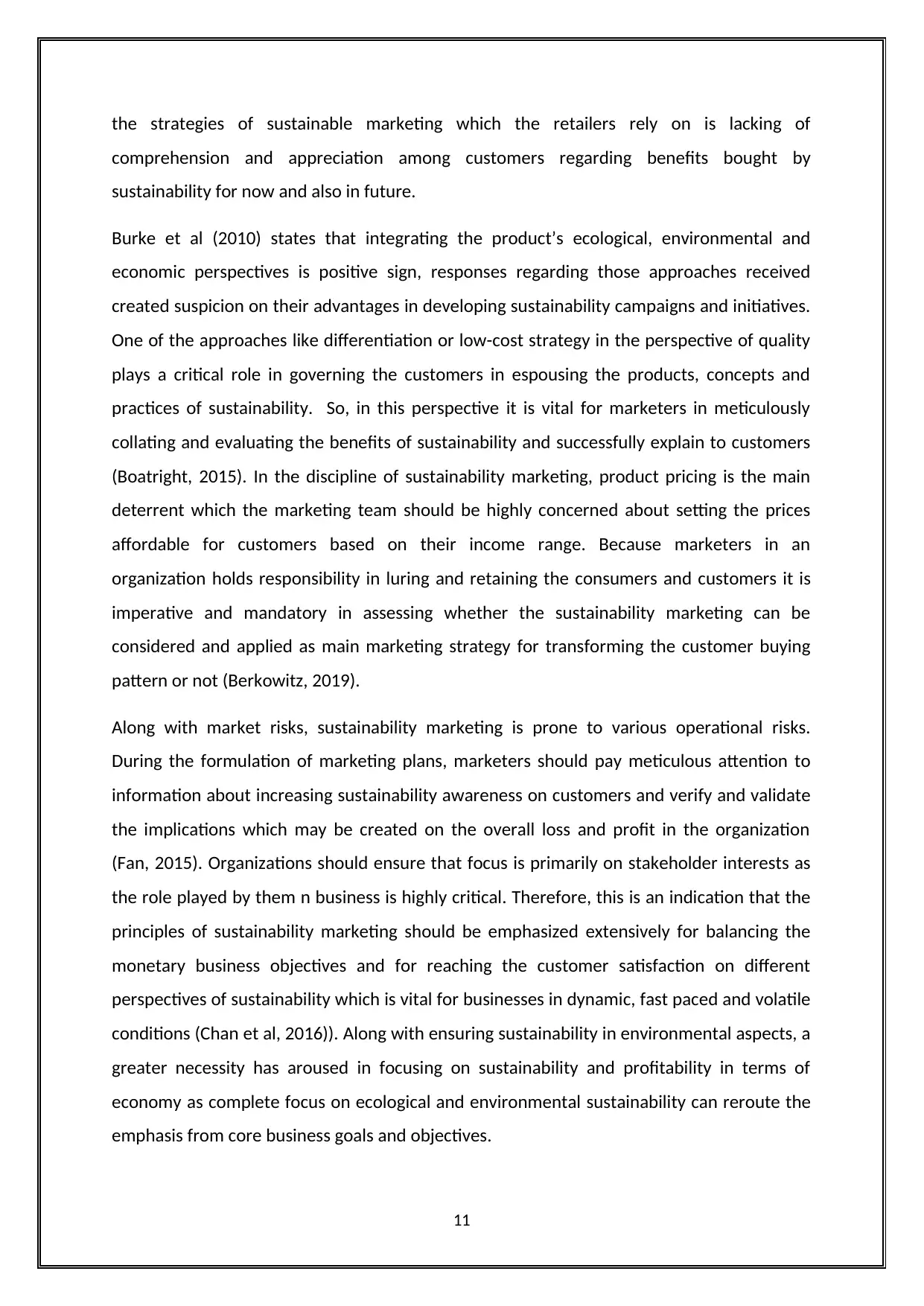
the strategies of sustainable marketing which the retailers rely on is lacking of
comprehension and appreciation among customers regarding benefits bought by
sustainability for now and also in future.
Burke et al (2010) states that integrating the product’s ecological, environmental and
economic perspectives is positive sign, responses regarding those approaches received
created suspicion on their advantages in developing sustainability campaigns and initiatives.
One of the approaches like differentiation or low-cost strategy in the perspective of quality
plays a critical role in governing the customers in espousing the products, concepts and
practices of sustainability. So, in this perspective it is vital for marketers in meticulously
collating and evaluating the benefits of sustainability and successfully explain to customers
(Boatright, 2015). In the discipline of sustainability marketing, product pricing is the main
deterrent which the marketing team should be highly concerned about setting the prices
affordable for customers based on their income range. Because marketers in an
organization holds responsibility in luring and retaining the consumers and customers it is
imperative and mandatory in assessing whether the sustainability marketing can be
considered and applied as main marketing strategy for transforming the customer buying
pattern or not (Berkowitz, 2019).
Along with market risks, sustainability marketing is prone to various operational risks.
During the formulation of marketing plans, marketers should pay meticulous attention to
information about increasing sustainability awareness on customers and verify and validate
the implications which may be created on the overall loss and profit in the organization
(Fan, 2015). Organizations should ensure that focus is primarily on stakeholder interests as
the role played by them n business is highly critical. Therefore, this is an indication that the
principles of sustainability marketing should be emphasized extensively for balancing the
monetary business objectives and for reaching the customer satisfaction on different
perspectives of sustainability which is vital for businesses in dynamic, fast paced and volatile
conditions (Chan et al, 2016)). Along with ensuring sustainability in environmental aspects, a
greater necessity has aroused in focusing on sustainability and profitability in terms of
economy as complete focus on ecological and environmental sustainability can reroute the
emphasis from core business goals and objectives.
11
comprehension and appreciation among customers regarding benefits bought by
sustainability for now and also in future.
Burke et al (2010) states that integrating the product’s ecological, environmental and
economic perspectives is positive sign, responses regarding those approaches received
created suspicion on their advantages in developing sustainability campaigns and initiatives.
One of the approaches like differentiation or low-cost strategy in the perspective of quality
plays a critical role in governing the customers in espousing the products, concepts and
practices of sustainability. So, in this perspective it is vital for marketers in meticulously
collating and evaluating the benefits of sustainability and successfully explain to customers
(Boatright, 2015). In the discipline of sustainability marketing, product pricing is the main
deterrent which the marketing team should be highly concerned about setting the prices
affordable for customers based on their income range. Because marketers in an
organization holds responsibility in luring and retaining the consumers and customers it is
imperative and mandatory in assessing whether the sustainability marketing can be
considered and applied as main marketing strategy for transforming the customer buying
pattern or not (Berkowitz, 2019).
Along with market risks, sustainability marketing is prone to various operational risks.
During the formulation of marketing plans, marketers should pay meticulous attention to
information about increasing sustainability awareness on customers and verify and validate
the implications which may be created on the overall loss and profit in the organization
(Fan, 2015). Organizations should ensure that focus is primarily on stakeholder interests as
the role played by them n business is highly critical. Therefore, this is an indication that the
principles of sustainability marketing should be emphasized extensively for balancing the
monetary business objectives and for reaching the customer satisfaction on different
perspectives of sustainability which is vital for businesses in dynamic, fast paced and volatile
conditions (Chan et al, 2016)). Along with ensuring sustainability in environmental aspects, a
greater necessity has aroused in focusing on sustainability and profitability in terms of
economy as complete focus on ecological and environmental sustainability can reroute the
emphasis from core business goals and objectives.
11

In the modern period, the main criticism faced by sustainable marketing is the
inconsistencies created in business operations while communicating pertinent information
to customers regarding various aspects and attributes in sustainability marketing (Flammer,
2015). The operations involved in sustainability marketing are noble cause oriented and the
conventional methods of marketing ate for commercial activities which correspond to
boosting the profitability and sales. In implementing the approaches of sustainability
marketing, another key challenge encountered is the picturesque of negative greenwashing
they have to face when trying to satisfy the customers that the organization design eco-
friendly products and the business operations which they do are environment friendly
(Galan, 2017). Lack of proper proofs and evidence corresponding to those measures taken
can show negative influence of impact on brands which creates customer attrition or churn.
Even the organizations which are wholehearted in reaching the sustainability marketing
goals may be in danger zone due to customer loss. So, it is pivotal for marketing department
people in evaluating all the benefits and challenges associated with sustainability marketing
for influencing customer buying patterns and gain competitive edge in the market (Welford,
2016).
Difference between sustainability awareness and action among
customers
Klockner (2013), over the last two decades in 21st century consumer awareness on social-
economic attributes corresponding to business is increasing which will be more in coming
decades. Veresiu and Giesler (2014) accentuated discrepancies betwixt the factors of
consumer ethical purchasing behaviour, environmental awareness, sustainability and
socioeconomic. Many reasons exist for the consumer concerns between ethical practices
and real consumption practice. Burke et al (2010) states that environment friendly products
cannot be accessible to customers easily due to lack of trust in meeting the price and
performance criteria. So, though customers are aware about environmental and
sustainability concerns, the chances are very high that customers may prefer the products
which are accessible quickly and also good in terms of price and performance. Boatright,
(2015) pointed out that lacing of information regarding environmental and sustainability
benefits is stopping the customers in buying eco-friendly products. The other issues pointed
12
inconsistencies created in business operations while communicating pertinent information
to customers regarding various aspects and attributes in sustainability marketing (Flammer,
2015). The operations involved in sustainability marketing are noble cause oriented and the
conventional methods of marketing ate for commercial activities which correspond to
boosting the profitability and sales. In implementing the approaches of sustainability
marketing, another key challenge encountered is the picturesque of negative greenwashing
they have to face when trying to satisfy the customers that the organization design eco-
friendly products and the business operations which they do are environment friendly
(Galan, 2017). Lack of proper proofs and evidence corresponding to those measures taken
can show negative influence of impact on brands which creates customer attrition or churn.
Even the organizations which are wholehearted in reaching the sustainability marketing
goals may be in danger zone due to customer loss. So, it is pivotal for marketing department
people in evaluating all the benefits and challenges associated with sustainability marketing
for influencing customer buying patterns and gain competitive edge in the market (Welford,
2016).
Difference between sustainability awareness and action among
customers
Klockner (2013), over the last two decades in 21st century consumer awareness on social-
economic attributes corresponding to business is increasing which will be more in coming
decades. Veresiu and Giesler (2014) accentuated discrepancies betwixt the factors of
consumer ethical purchasing behaviour, environmental awareness, sustainability and
socioeconomic. Many reasons exist for the consumer concerns between ethical practices
and real consumption practice. Burke et al (2010) states that environment friendly products
cannot be accessible to customers easily due to lack of trust in meeting the price and
performance criteria. So, though customers are aware about environmental and
sustainability concerns, the chances are very high that customers may prefer the products
which are accessible quickly and also good in terms of price and performance. Boatright,
(2015) pointed out that lacing of information regarding environmental and sustainability
benefits is stopping the customers in buying eco-friendly products. The other issues pointed
12
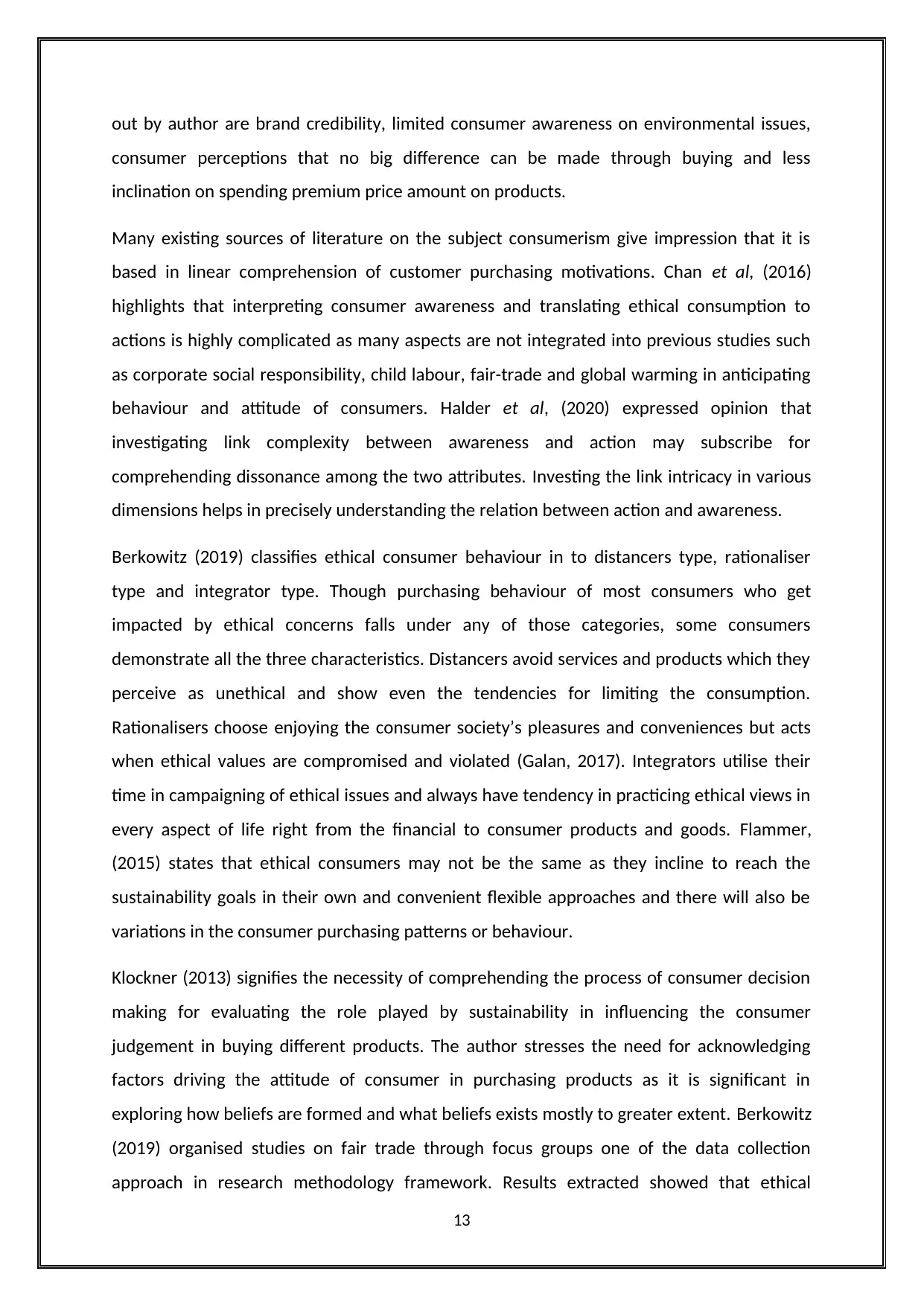
out by author are brand credibility, limited consumer awareness on environmental issues,
consumer perceptions that no big difference can be made through buying and less
inclination on spending premium price amount on products.
Many existing sources of literature on the subject consumerism give impression that it is
based in linear comprehension of customer purchasing motivations. Chan et al, (2016)
highlights that interpreting consumer awareness and translating ethical consumption to
actions is highly complicated as many aspects are not integrated into previous studies such
as corporate social responsibility, child labour, fair-trade and global warming in anticipating
behaviour and attitude of consumers. Halder et al, (2020) expressed opinion that
investigating link complexity between awareness and action may subscribe for
comprehending dissonance among the two attributes. Investing the link intricacy in various
dimensions helps in precisely understanding the relation between action and awareness.
Berkowitz (2019) classifies ethical consumer behaviour in to distancers type, rationaliser
type and integrator type. Though purchasing behaviour of most consumers who get
impacted by ethical concerns falls under any of those categories, some consumers
demonstrate all the three characteristics. Distancers avoid services and products which they
perceive as unethical and show even the tendencies for limiting the consumption.
Rationalisers choose enjoying the consumer society’s pleasures and conveniences but acts
when ethical values are compromised and violated (Galan, 2017). Integrators utilise their
time in campaigning of ethical issues and always have tendency in practicing ethical views in
every aspect of life right from the financial to consumer products and goods. Flammer,
(2015) states that ethical consumers may not be the same as they incline to reach the
sustainability goals in their own and convenient flexible approaches and there will also be
variations in the consumer purchasing patterns or behaviour.
Klockner (2013) signifies the necessity of comprehending the process of consumer decision
making for evaluating the role played by sustainability in influencing the consumer
judgement in buying different products. The author stresses the need for acknowledging
factors driving the attitude of consumer in purchasing products as it is significant in
exploring how beliefs are formed and what beliefs exists mostly to greater extent. Berkowitz
(2019) organised studies on fair trade through focus groups one of the data collection
approach in research methodology framework. Results extracted showed that ethical
13
consumer perceptions that no big difference can be made through buying and less
inclination on spending premium price amount on products.
Many existing sources of literature on the subject consumerism give impression that it is
based in linear comprehension of customer purchasing motivations. Chan et al, (2016)
highlights that interpreting consumer awareness and translating ethical consumption to
actions is highly complicated as many aspects are not integrated into previous studies such
as corporate social responsibility, child labour, fair-trade and global warming in anticipating
behaviour and attitude of consumers. Halder et al, (2020) expressed opinion that
investigating link complexity between awareness and action may subscribe for
comprehending dissonance among the two attributes. Investing the link intricacy in various
dimensions helps in precisely understanding the relation between action and awareness.
Berkowitz (2019) classifies ethical consumer behaviour in to distancers type, rationaliser
type and integrator type. Though purchasing behaviour of most consumers who get
impacted by ethical concerns falls under any of those categories, some consumers
demonstrate all the three characteristics. Distancers avoid services and products which they
perceive as unethical and show even the tendencies for limiting the consumption.
Rationalisers choose enjoying the consumer society’s pleasures and conveniences but acts
when ethical values are compromised and violated (Galan, 2017). Integrators utilise their
time in campaigning of ethical issues and always have tendency in practicing ethical views in
every aspect of life right from the financial to consumer products and goods. Flammer,
(2015) states that ethical consumers may not be the same as they incline to reach the
sustainability goals in their own and convenient flexible approaches and there will also be
variations in the consumer purchasing patterns or behaviour.
Klockner (2013) signifies the necessity of comprehending the process of consumer decision
making for evaluating the role played by sustainability in influencing the consumer
judgement in buying different products. The author stresses the need for acknowledging
factors driving the attitude of consumer in purchasing products as it is significant in
exploring how beliefs are formed and what beliefs exists mostly to greater extent. Berkowitz
(2019) organised studies on fair trade through focus groups one of the data collection
approach in research methodology framework. Results extracted showed that ethical
13
Paraphrase This Document
Need a fresh take? Get an instant paraphrase of this document with our AI Paraphraser
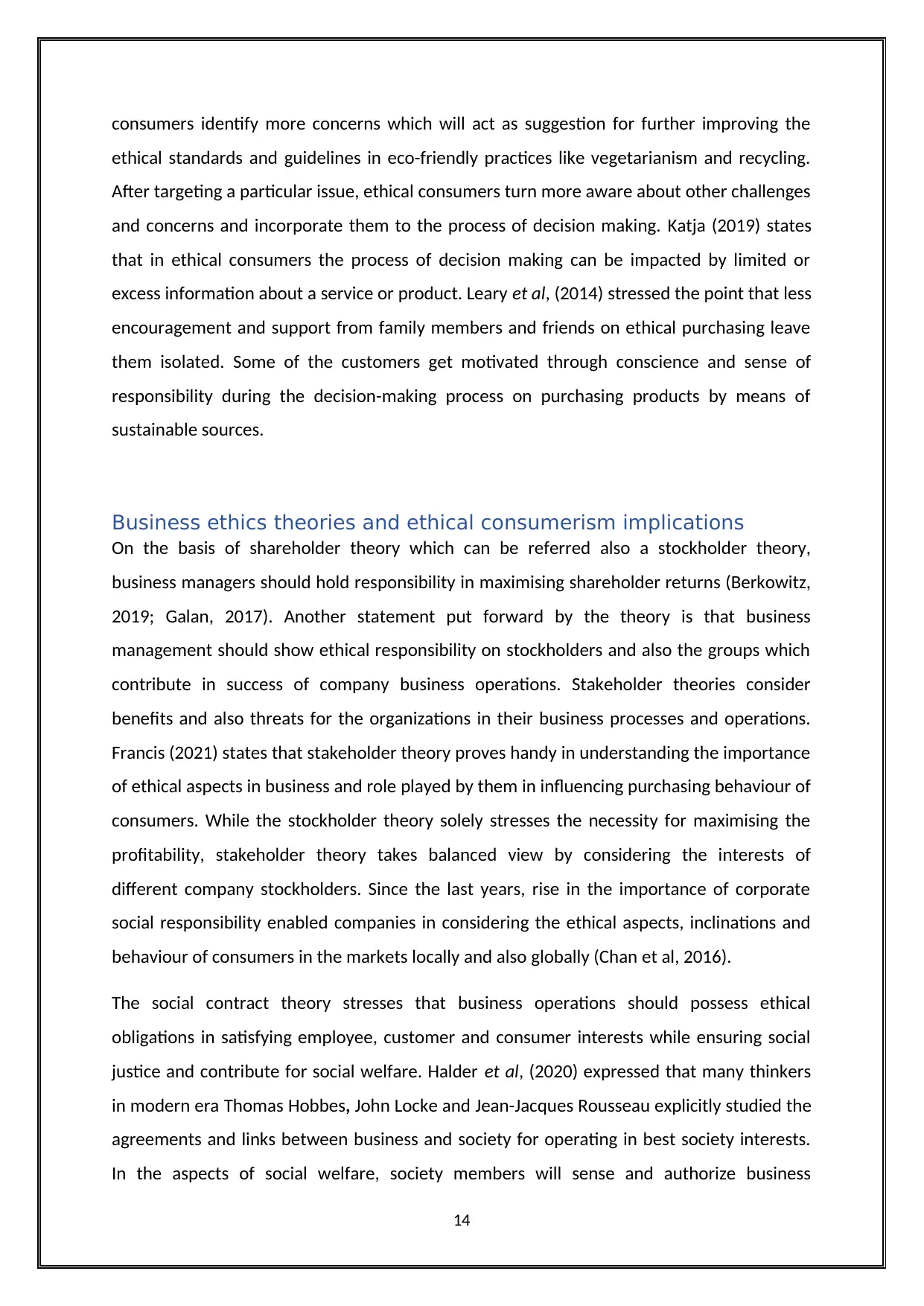
consumers identify more concerns which will act as suggestion for further improving the
ethical standards and guidelines in eco-friendly practices like vegetarianism and recycling.
After targeting a particular issue, ethical consumers turn more aware about other challenges
and concerns and incorporate them to the process of decision making. Katja (2019) states
that in ethical consumers the process of decision making can be impacted by limited or
excess information about a service or product. Leary et al, (2014) stressed the point that less
encouragement and support from family members and friends on ethical purchasing leave
them isolated. Some of the customers get motivated through conscience and sense of
responsibility during the decision-making process on purchasing products by means of
sustainable sources.
Business ethics theories and ethical consumerism implications
On the basis of shareholder theory which can be referred also a stockholder theory,
business managers should hold responsibility in maximising shareholder returns (Berkowitz,
2019; Galan, 2017). Another statement put forward by the theory is that business
management should show ethical responsibility on stockholders and also the groups which
contribute in success of company business operations. Stakeholder theories consider
benefits and also threats for the organizations in their business processes and operations.
Francis (2021) states that stakeholder theory proves handy in understanding the importance
of ethical aspects in business and role played by them in influencing purchasing behaviour of
consumers. While the stockholder theory solely stresses the necessity for maximising the
profitability, stakeholder theory takes balanced view by considering the interests of
different company stockholders. Since the last years, rise in the importance of corporate
social responsibility enabled companies in considering the ethical aspects, inclinations and
behaviour of consumers in the markets locally and also globally (Chan et al, 2016).
The social contract theory stresses that business operations should possess ethical
obligations in satisfying employee, customer and consumer interests while ensuring social
justice and contribute for social welfare. Halder et al, (2020) expressed that many thinkers
in modern era Thomas Hobbes, John Locke and Jean-Jacques Rousseau explicitly studied the
agreements and links between business and society for operating in best society interests.
In the aspects of social welfare, society members will sense and authorize business
14
ethical standards and guidelines in eco-friendly practices like vegetarianism and recycling.
After targeting a particular issue, ethical consumers turn more aware about other challenges
and concerns and incorporate them to the process of decision making. Katja (2019) states
that in ethical consumers the process of decision making can be impacted by limited or
excess information about a service or product. Leary et al, (2014) stressed the point that less
encouragement and support from family members and friends on ethical purchasing leave
them isolated. Some of the customers get motivated through conscience and sense of
responsibility during the decision-making process on purchasing products by means of
sustainable sources.
Business ethics theories and ethical consumerism implications
On the basis of shareholder theory which can be referred also a stockholder theory,
business managers should hold responsibility in maximising shareholder returns (Berkowitz,
2019; Galan, 2017). Another statement put forward by the theory is that business
management should show ethical responsibility on stockholders and also the groups which
contribute in success of company business operations. Stakeholder theories consider
benefits and also threats for the organizations in their business processes and operations.
Francis (2021) states that stakeholder theory proves handy in understanding the importance
of ethical aspects in business and role played by them in influencing purchasing behaviour of
consumers. While the stockholder theory solely stresses the necessity for maximising the
profitability, stakeholder theory takes balanced view by considering the interests of
different company stockholders. Since the last years, rise in the importance of corporate
social responsibility enabled companies in considering the ethical aspects, inclinations and
behaviour of consumers in the markets locally and also globally (Chan et al, 2016).
The social contract theory stresses that business operations should possess ethical
obligations in satisfying employee, customer and consumer interests while ensuring social
justice and contribute for social welfare. Halder et al, (2020) expressed that many thinkers
in modern era Thomas Hobbes, John Locke and Jean-Jacques Rousseau explicitly studied the
agreements and links between business and society for operating in best society interests.
In the aspects of social welfare, society members will sense and authorize business
14
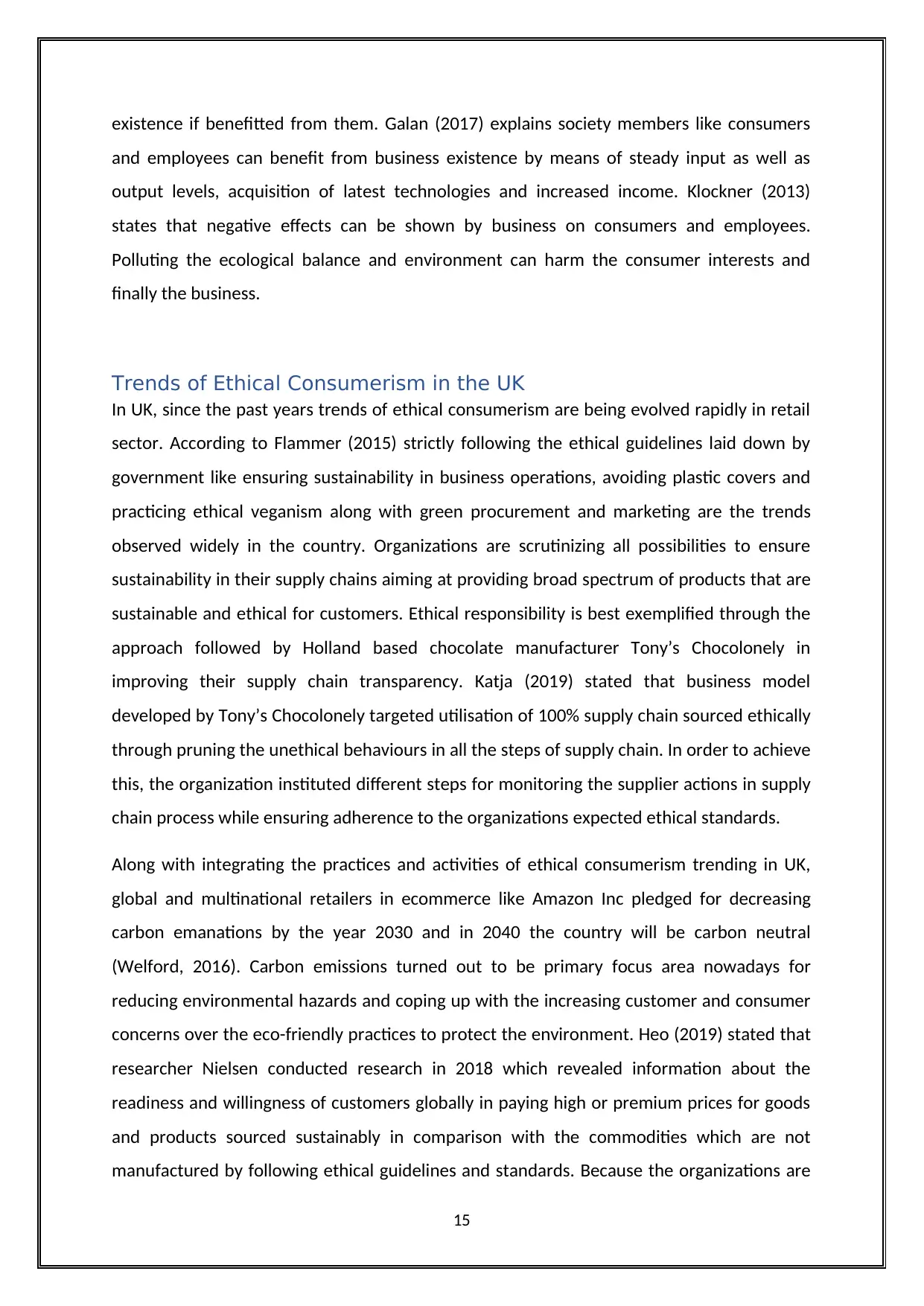
existence if benefitted from them. Galan (2017) explains society members like consumers
and employees can benefit from business existence by means of steady input as well as
output levels, acquisition of latest technologies and increased income. Klockner (2013)
states that negative effects can be shown by business on consumers and employees.
Polluting the ecological balance and environment can harm the consumer interests and
finally the business.
Trends of Ethical Consumerism in the UK
In UK, since the past years trends of ethical consumerism are being evolved rapidly in retail
sector. According to Flammer (2015) strictly following the ethical guidelines laid down by
government like ensuring sustainability in business operations, avoiding plastic covers and
practicing ethical veganism along with green procurement and marketing are the trends
observed widely in the country. Organizations are scrutinizing all possibilities to ensure
sustainability in their supply chains aiming at providing broad spectrum of products that are
sustainable and ethical for customers. Ethical responsibility is best exemplified through the
approach followed by Holland based chocolate manufacturer Tony’s Chocolonely in
improving their supply chain transparency. Katja (2019) stated that business model
developed by Tony’s Chocolonely targeted utilisation of 100% supply chain sourced ethically
through pruning the unethical behaviours in all the steps of supply chain. In order to achieve
this, the organization instituted different steps for monitoring the supplier actions in supply
chain process while ensuring adherence to the organizations expected ethical standards.
Along with integrating the practices and activities of ethical consumerism trending in UK,
global and multinational retailers in ecommerce like Amazon Inc pledged for decreasing
carbon emanations by the year 2030 and in 2040 the country will be carbon neutral
(Welford, 2016). Carbon emissions turned out to be primary focus area nowadays for
reducing environmental hazards and coping up with the increasing customer and consumer
concerns over the eco-friendly practices to protect the environment. Heo (2019) stated that
researcher Nielsen conducted research in 2018 which revealed information about the
readiness and willingness of customers globally in paying high or premium prices for goods
and products sourced sustainably in comparison with the commodities which are not
manufactured by following ethical guidelines and standards. Because the organizations are
15
and employees can benefit from business existence by means of steady input as well as
output levels, acquisition of latest technologies and increased income. Klockner (2013)
states that negative effects can be shown by business on consumers and employees.
Polluting the ecological balance and environment can harm the consumer interests and
finally the business.
Trends of Ethical Consumerism in the UK
In UK, since the past years trends of ethical consumerism are being evolved rapidly in retail
sector. According to Flammer (2015) strictly following the ethical guidelines laid down by
government like ensuring sustainability in business operations, avoiding plastic covers and
practicing ethical veganism along with green procurement and marketing are the trends
observed widely in the country. Organizations are scrutinizing all possibilities to ensure
sustainability in their supply chains aiming at providing broad spectrum of products that are
sustainable and ethical for customers. Ethical responsibility is best exemplified through the
approach followed by Holland based chocolate manufacturer Tony’s Chocolonely in
improving their supply chain transparency. Katja (2019) stated that business model
developed by Tony’s Chocolonely targeted utilisation of 100% supply chain sourced ethically
through pruning the unethical behaviours in all the steps of supply chain. In order to achieve
this, the organization instituted different steps for monitoring the supplier actions in supply
chain process while ensuring adherence to the organizations expected ethical standards.
Along with integrating the practices and activities of ethical consumerism trending in UK,
global and multinational retailers in ecommerce like Amazon Inc pledged for decreasing
carbon emanations by the year 2030 and in 2040 the country will be carbon neutral
(Welford, 2016). Carbon emissions turned out to be primary focus area nowadays for
reducing environmental hazards and coping up with the increasing customer and consumer
concerns over the eco-friendly practices to protect the environment. Heo (2019) stated that
researcher Nielsen conducted research in 2018 which revealed information about the
readiness and willingness of customers globally in paying high or premium prices for goods
and products sourced sustainably in comparison with the commodities which are not
manufactured by following ethical guidelines and standards. Because the organizations are
15
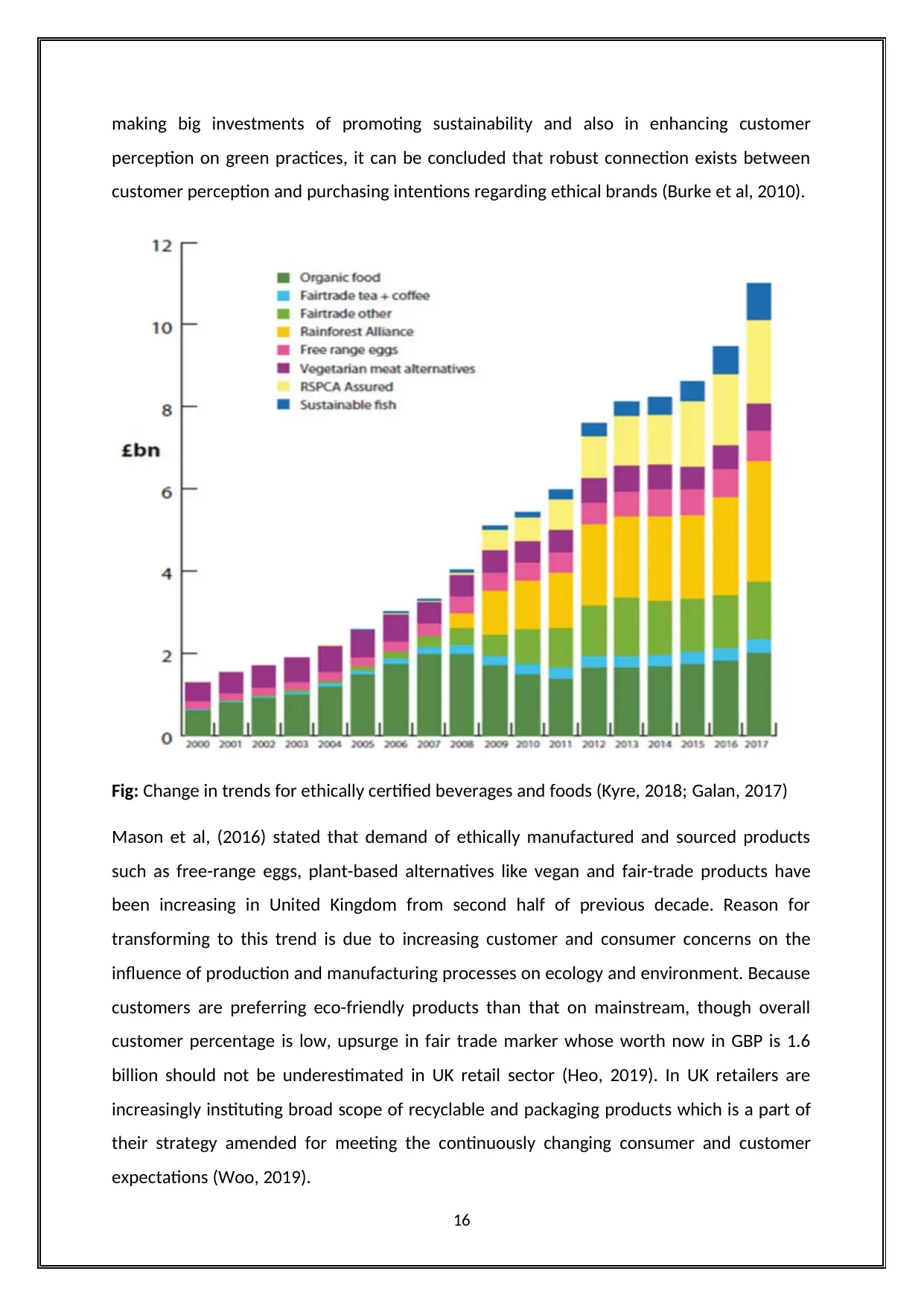
making big investments of promoting sustainability and also in enhancing customer
perception on green practices, it can be concluded that robust connection exists between
customer perception and purchasing intentions regarding ethical brands (Burke et al, 2010).
Fig: Change in trends for ethically certified beverages and foods (Kyre, 2018; Galan, 2017)
Mason et al, (2016) stated that demand of ethically manufactured and sourced products
such as free-range eggs, plant-based alternatives like vegan and fair-trade products have
been increasing in United Kingdom from second half of previous decade. Reason for
transforming to this trend is due to increasing customer and consumer concerns on the
influence of production and manufacturing processes on ecology and environment. Because
customers are preferring eco-friendly products than that on mainstream, though overall
customer percentage is low, upsurge in fair trade marker whose worth now in GBP is 1.6
billion should not be underestimated in UK retail sector (Heo, 2019). In UK retailers are
increasingly instituting broad scope of recyclable and packaging products which is a part of
their strategy amended for meeting the continuously changing consumer and customer
expectations (Woo, 2019).
16
perception on green practices, it can be concluded that robust connection exists between
customer perception and purchasing intentions regarding ethical brands (Burke et al, 2010).
Fig: Change in trends for ethically certified beverages and foods (Kyre, 2018; Galan, 2017)
Mason et al, (2016) stated that demand of ethically manufactured and sourced products
such as free-range eggs, plant-based alternatives like vegan and fair-trade products have
been increasing in United Kingdom from second half of previous decade. Reason for
transforming to this trend is due to increasing customer and consumer concerns on the
influence of production and manufacturing processes on ecology and environment. Because
customers are preferring eco-friendly products than that on mainstream, though overall
customer percentage is low, upsurge in fair trade marker whose worth now in GBP is 1.6
billion should not be underestimated in UK retail sector (Heo, 2019). In UK retailers are
increasingly instituting broad scope of recyclable and packaging products which is a part of
their strategy amended for meeting the continuously changing consumer and customer
expectations (Woo, 2019).
16
Secure Best Marks with AI Grader
Need help grading? Try our AI Grader for instant feedback on your assignments.
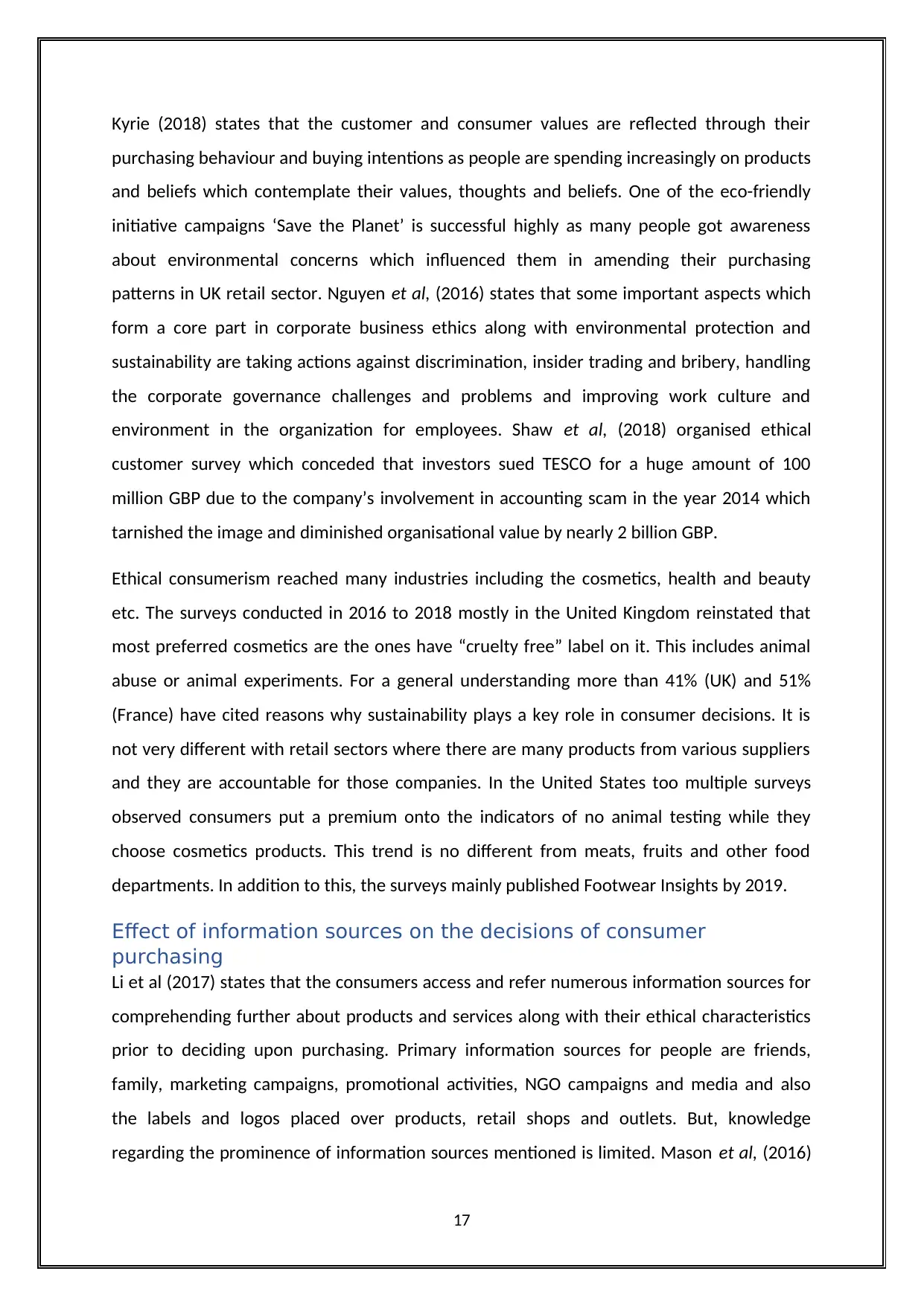
Kyrie (2018) states that the customer and consumer values are reflected through their
purchasing behaviour and buying intentions as people are spending increasingly on products
and beliefs which contemplate their values, thoughts and beliefs. One of the eco-friendly
initiative campaigns ‘Save the Planet’ is successful highly as many people got awareness
about environmental concerns which influenced them in amending their purchasing
patterns in UK retail sector. Nguyen et al, (2016) states that some important aspects which
form a core part in corporate business ethics along with environmental protection and
sustainability are taking actions against discrimination, insider trading and bribery, handling
the corporate governance challenges and problems and improving work culture and
environment in the organization for employees. Shaw et al, (2018) organised ethical
customer survey which conceded that investors sued TESCO for a huge amount of 100
million GBP due to the company’s involvement in accounting scam in the year 2014 which
tarnished the image and diminished organisational value by nearly 2 billion GBP.
Ethical consumerism reached many industries including the cosmetics, health and beauty
etc. The surveys conducted in 2016 to 2018 mostly in the United Kingdom reinstated that
most preferred cosmetics are the ones have “cruelty free” label on it. This includes animal
abuse or animal experiments. For a general understanding more than 41% (UK) and 51%
(France) have cited reasons why sustainability plays a key role in consumer decisions. It is
not very different with retail sectors where there are many products from various suppliers
and they are accountable for those companies. In the United States too multiple surveys
observed consumers put a premium onto the indicators of no animal testing while they
choose cosmetics products. This trend is no different from meats, fruits and other food
departments. In addition to this, the surveys mainly published Footwear Insights by 2019.
Effect of information sources on the decisions of consumer
purchasing
Li et al (2017) states that the consumers access and refer numerous information sources for
comprehending further about products and services along with their ethical characteristics
prior to deciding upon purchasing. Primary information sources for people are friends,
family, marketing campaigns, promotional activities, NGO campaigns and media and also
the labels and logos placed over products, retail shops and outlets. But, knowledge
regarding the prominence of information sources mentioned is limited. Mason et al, (2016)
17
purchasing behaviour and buying intentions as people are spending increasingly on products
and beliefs which contemplate their values, thoughts and beliefs. One of the eco-friendly
initiative campaigns ‘Save the Planet’ is successful highly as many people got awareness
about environmental concerns which influenced them in amending their purchasing
patterns in UK retail sector. Nguyen et al, (2016) states that some important aspects which
form a core part in corporate business ethics along with environmental protection and
sustainability are taking actions against discrimination, insider trading and bribery, handling
the corporate governance challenges and problems and improving work culture and
environment in the organization for employees. Shaw et al, (2018) organised ethical
customer survey which conceded that investors sued TESCO for a huge amount of 100
million GBP due to the company’s involvement in accounting scam in the year 2014 which
tarnished the image and diminished organisational value by nearly 2 billion GBP.
Ethical consumerism reached many industries including the cosmetics, health and beauty
etc. The surveys conducted in 2016 to 2018 mostly in the United Kingdom reinstated that
most preferred cosmetics are the ones have “cruelty free” label on it. This includes animal
abuse or animal experiments. For a general understanding more than 41% (UK) and 51%
(France) have cited reasons why sustainability plays a key role in consumer decisions. It is
not very different with retail sectors where there are many products from various suppliers
and they are accountable for those companies. In the United States too multiple surveys
observed consumers put a premium onto the indicators of no animal testing while they
choose cosmetics products. This trend is no different from meats, fruits and other food
departments. In addition to this, the surveys mainly published Footwear Insights by 2019.
Effect of information sources on the decisions of consumer
purchasing
Li et al (2017) states that the consumers access and refer numerous information sources for
comprehending further about products and services along with their ethical characteristics
prior to deciding upon purchasing. Primary information sources for people are friends,
family, marketing campaigns, promotional activities, NGO campaigns and media and also
the labels and logos placed over products, retail shops and outlets. But, knowledge
regarding the prominence of information sources mentioned is limited. Mason et al, (2016)
17
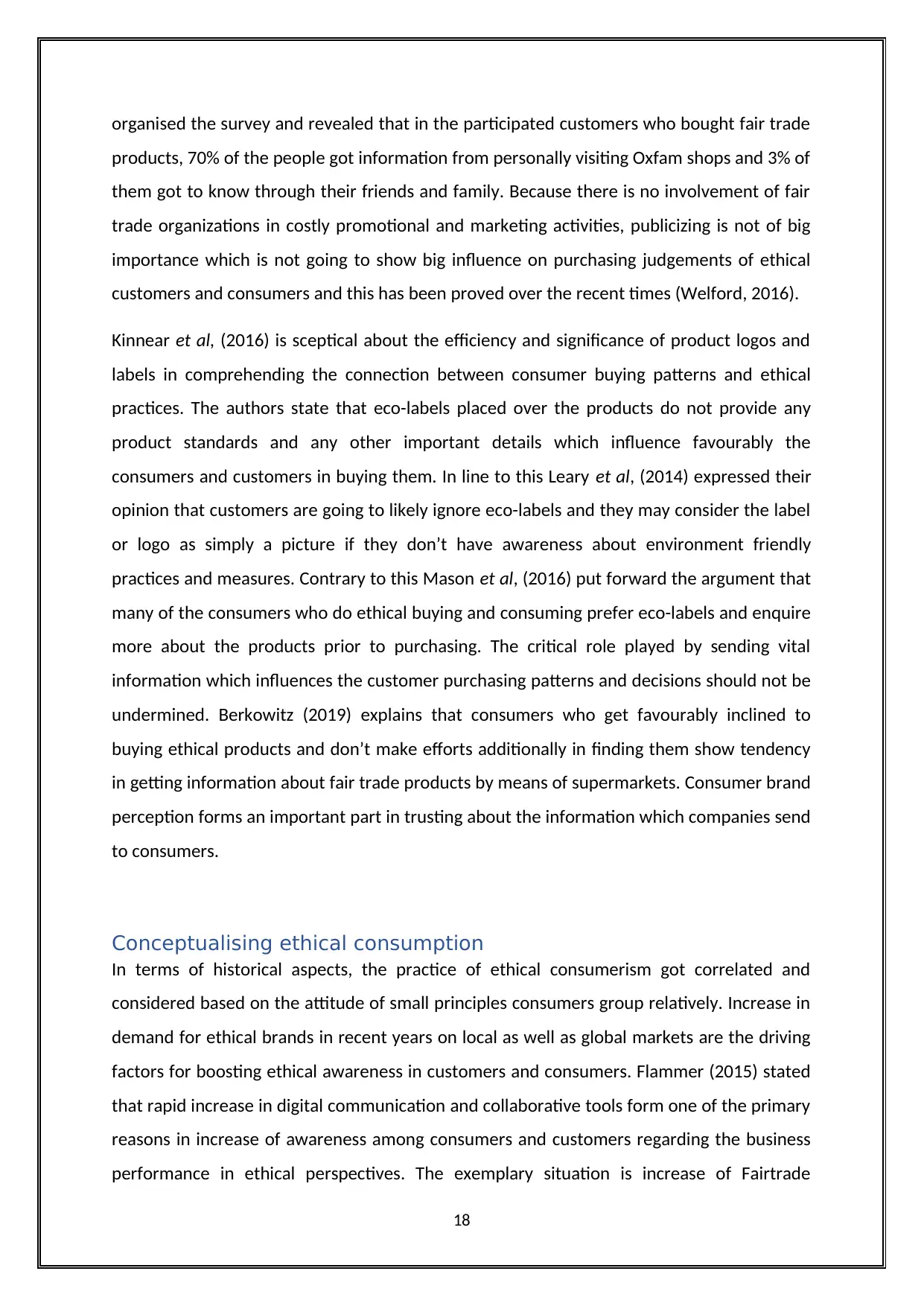
organised the survey and revealed that in the participated customers who bought fair trade
products, 70% of the people got information from personally visiting Oxfam shops and 3% of
them got to know through their friends and family. Because there is no involvement of fair
trade organizations in costly promotional and marketing activities, publicizing is not of big
importance which is not going to show big influence on purchasing judgements of ethical
customers and consumers and this has been proved over the recent times (Welford, 2016).
Kinnear et al, (2016) is sceptical about the efficiency and significance of product logos and
labels in comprehending the connection between consumer buying patterns and ethical
practices. The authors state that eco-labels placed over the products do not provide any
product standards and any other important details which influence favourably the
consumers and customers in buying them. In line to this Leary et al, (2014) expressed their
opinion that customers are going to likely ignore eco-labels and they may consider the label
or logo as simply a picture if they don’t have awareness about environment friendly
practices and measures. Contrary to this Mason et al, (2016) put forward the argument that
many of the consumers who do ethical buying and consuming prefer eco-labels and enquire
more about the products prior to purchasing. The critical role played by sending vital
information which influences the customer purchasing patterns and decisions should not be
undermined. Berkowitz (2019) explains that consumers who get favourably inclined to
buying ethical products and don’t make efforts additionally in finding them show tendency
in getting information about fair trade products by means of supermarkets. Consumer brand
perception forms an important part in trusting about the information which companies send
to consumers.
Conceptualising ethical consumption
In terms of historical aspects, the practice of ethical consumerism got correlated and
considered based on the attitude of small principles consumers group relatively. Increase in
demand for ethical brands in recent years on local as well as global markets are the driving
factors for boosting ethical awareness in customers and consumers. Flammer (2015) stated
that rapid increase in digital communication and collaborative tools form one of the primary
reasons in increase of awareness among consumers and customers regarding the business
performance in ethical perspectives. The exemplary situation is increase of Fairtrade
18
products, 70% of the people got information from personally visiting Oxfam shops and 3% of
them got to know through their friends and family. Because there is no involvement of fair
trade organizations in costly promotional and marketing activities, publicizing is not of big
importance which is not going to show big influence on purchasing judgements of ethical
customers and consumers and this has been proved over the recent times (Welford, 2016).
Kinnear et al, (2016) is sceptical about the efficiency and significance of product logos and
labels in comprehending the connection between consumer buying patterns and ethical
practices. The authors state that eco-labels placed over the products do not provide any
product standards and any other important details which influence favourably the
consumers and customers in buying them. In line to this Leary et al, (2014) expressed their
opinion that customers are going to likely ignore eco-labels and they may consider the label
or logo as simply a picture if they don’t have awareness about environment friendly
practices and measures. Contrary to this Mason et al, (2016) put forward the argument that
many of the consumers who do ethical buying and consuming prefer eco-labels and enquire
more about the products prior to purchasing. The critical role played by sending vital
information which influences the customer purchasing patterns and decisions should not be
undermined. Berkowitz (2019) explains that consumers who get favourably inclined to
buying ethical products and don’t make efforts additionally in finding them show tendency
in getting information about fair trade products by means of supermarkets. Consumer brand
perception forms an important part in trusting about the information which companies send
to consumers.
Conceptualising ethical consumption
In terms of historical aspects, the practice of ethical consumerism got correlated and
considered based on the attitude of small principles consumers group relatively. Increase in
demand for ethical brands in recent years on local as well as global markets are the driving
factors for boosting ethical awareness in customers and consumers. Flammer (2015) stated
that rapid increase in digital communication and collaborative tools form one of the primary
reasons in increase of awareness among consumers and customers regarding the business
performance in ethical perspectives. The exemplary situation is increase of Fairtrade
18
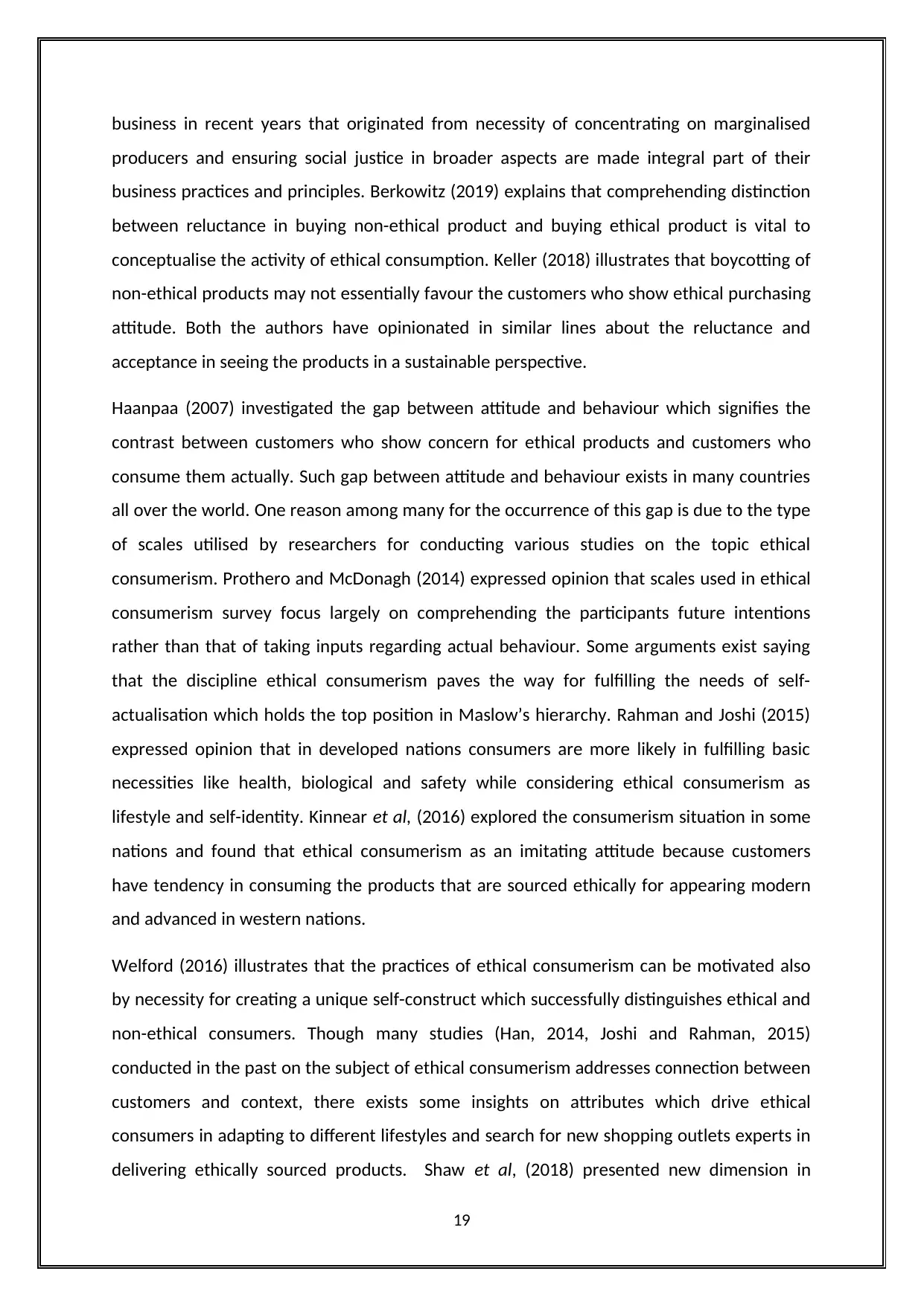
business in recent years that originated from necessity of concentrating on marginalised
producers and ensuring social justice in broader aspects are made integral part of their
business practices and principles. Berkowitz (2019) explains that comprehending distinction
between reluctance in buying non-ethical product and buying ethical product is vital to
conceptualise the activity of ethical consumption. Keller (2018) illustrates that boycotting of
non-ethical products may not essentially favour the customers who show ethical purchasing
attitude. Both the authors have opinionated in similar lines about the reluctance and
acceptance in seeing the products in a sustainable perspective.
Haanpaa (2007) investigated the gap between attitude and behaviour which signifies the
contrast between customers who show concern for ethical products and customers who
consume them actually. Such gap between attitude and behaviour exists in many countries
all over the world. One reason among many for the occurrence of this gap is due to the type
of scales utilised by researchers for conducting various studies on the topic ethical
consumerism. Prothero and McDonagh (2014) expressed opinion that scales used in ethical
consumerism survey focus largely on comprehending the participants future intentions
rather than that of taking inputs regarding actual behaviour. Some arguments exist saying
that the discipline ethical consumerism paves the way for fulfilling the needs of self-
actualisation which holds the top position in Maslow’s hierarchy. Rahman and Joshi (2015)
expressed opinion that in developed nations consumers are more likely in fulfilling basic
necessities like health, biological and safety while considering ethical consumerism as
lifestyle and self-identity. Kinnear et al, (2016) explored the consumerism situation in some
nations and found that ethical consumerism as an imitating attitude because customers
have tendency in consuming the products that are sourced ethically for appearing modern
and advanced in western nations.
Welford (2016) illustrates that the practices of ethical consumerism can be motivated also
by necessity for creating a unique self-construct which successfully distinguishes ethical and
non-ethical consumers. Though many studies (Han, 2014, Joshi and Rahman, 2015)
conducted in the past on the subject of ethical consumerism addresses connection between
customers and context, there exists some insights on attributes which drive ethical
consumers in adapting to different lifestyles and search for new shopping outlets experts in
delivering ethically sourced products. Shaw et al, (2018) presented new dimension in
19
producers and ensuring social justice in broader aspects are made integral part of their
business practices and principles. Berkowitz (2019) explains that comprehending distinction
between reluctance in buying non-ethical product and buying ethical product is vital to
conceptualise the activity of ethical consumption. Keller (2018) illustrates that boycotting of
non-ethical products may not essentially favour the customers who show ethical purchasing
attitude. Both the authors have opinionated in similar lines about the reluctance and
acceptance in seeing the products in a sustainable perspective.
Haanpaa (2007) investigated the gap between attitude and behaviour which signifies the
contrast between customers who show concern for ethical products and customers who
consume them actually. Such gap between attitude and behaviour exists in many countries
all over the world. One reason among many for the occurrence of this gap is due to the type
of scales utilised by researchers for conducting various studies on the topic ethical
consumerism. Prothero and McDonagh (2014) expressed opinion that scales used in ethical
consumerism survey focus largely on comprehending the participants future intentions
rather than that of taking inputs regarding actual behaviour. Some arguments exist saying
that the discipline ethical consumerism paves the way for fulfilling the needs of self-
actualisation which holds the top position in Maslow’s hierarchy. Rahman and Joshi (2015)
expressed opinion that in developed nations consumers are more likely in fulfilling basic
necessities like health, biological and safety while considering ethical consumerism as
lifestyle and self-identity. Kinnear et al, (2016) explored the consumerism situation in some
nations and found that ethical consumerism as an imitating attitude because customers
have tendency in consuming the products that are sourced ethically for appearing modern
and advanced in western nations.
Welford (2016) illustrates that the practices of ethical consumerism can be motivated also
by necessity for creating a unique self-construct which successfully distinguishes ethical and
non-ethical consumers. Though many studies (Han, 2014, Joshi and Rahman, 2015)
conducted in the past on the subject of ethical consumerism addresses connection between
customers and context, there exists some insights on attributes which drive ethical
consumers in adapting to different lifestyles and search for new shopping outlets experts in
delivering ethically sourced products. Shaw et al, (2018) presented new dimension in
19
Paraphrase This Document
Need a fresh take? Get an instant paraphrase of this document with our AI Paraphraser
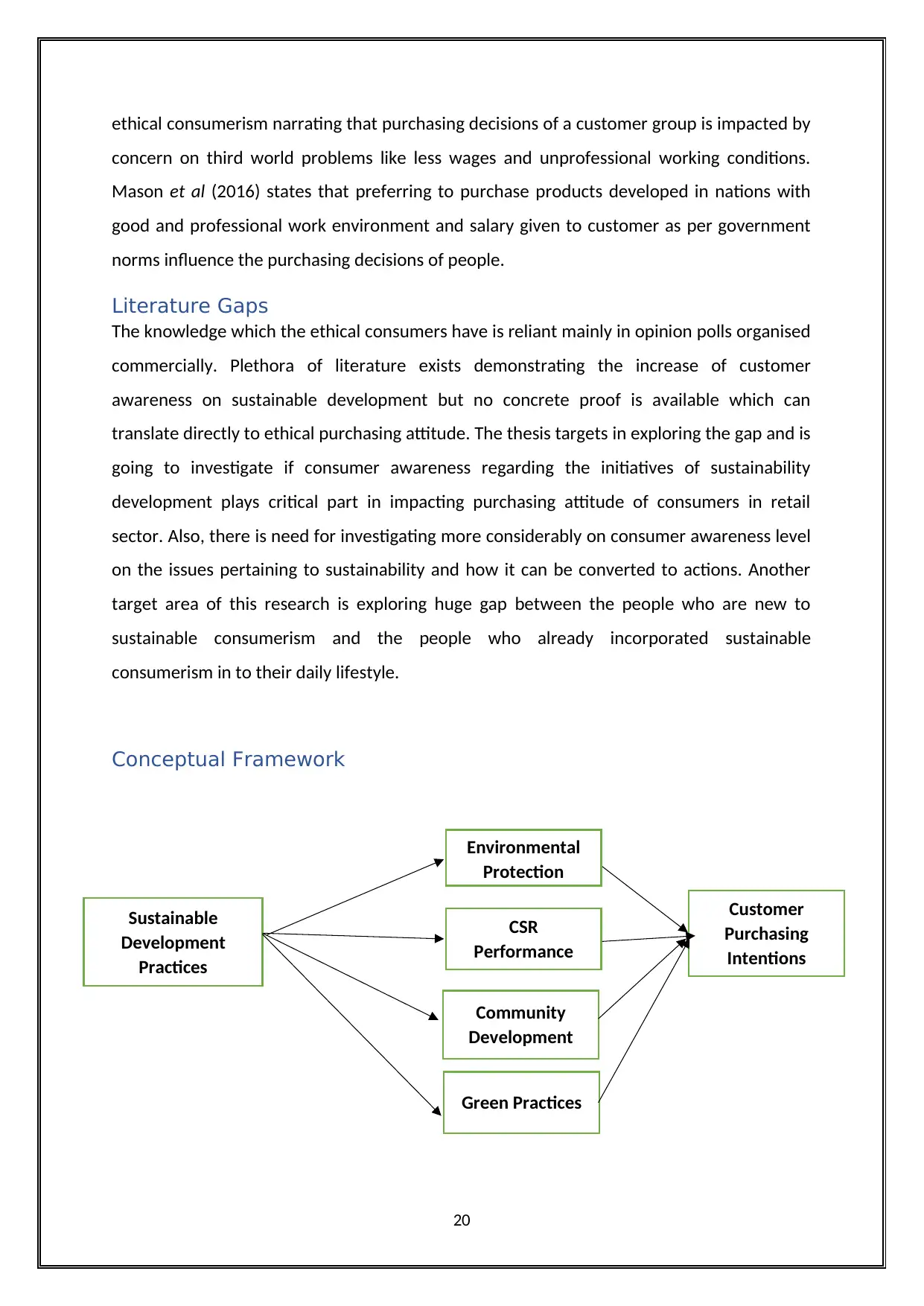
ethical consumerism narrating that purchasing decisions of a customer group is impacted by
concern on third world problems like less wages and unprofessional working conditions.
Mason et al (2016) states that preferring to purchase products developed in nations with
good and professional work environment and salary given to customer as per government
norms influence the purchasing decisions of people.
Literature Gaps
The knowledge which the ethical consumers have is reliant mainly in opinion polls organised
commercially. Plethora of literature exists demonstrating the increase of customer
awareness on sustainable development but no concrete proof is available which can
translate directly to ethical purchasing attitude. The thesis targets in exploring the gap and is
going to investigate if consumer awareness regarding the initiatives of sustainability
development plays critical part in impacting purchasing attitude of consumers in retail
sector. Also, there is need for investigating more considerably on consumer awareness level
on the issues pertaining to sustainability and how it can be converted to actions. Another
target area of this research is exploring huge gap between the people who are new to
sustainable consumerism and the people who already incorporated sustainable
consumerism in to their daily lifestyle.
Conceptual Framework
20
Sustainable
Development
Practices
CSR
Performance
Community
Development
Green Practices
Customer
Purchasing
Intentions
Environmental
Protection
concern on third world problems like less wages and unprofessional working conditions.
Mason et al (2016) states that preferring to purchase products developed in nations with
good and professional work environment and salary given to customer as per government
norms influence the purchasing decisions of people.
Literature Gaps
The knowledge which the ethical consumers have is reliant mainly in opinion polls organised
commercially. Plethora of literature exists demonstrating the increase of customer
awareness on sustainable development but no concrete proof is available which can
translate directly to ethical purchasing attitude. The thesis targets in exploring the gap and is
going to investigate if consumer awareness regarding the initiatives of sustainability
development plays critical part in impacting purchasing attitude of consumers in retail
sector. Also, there is need for investigating more considerably on consumer awareness level
on the issues pertaining to sustainability and how it can be converted to actions. Another
target area of this research is exploring huge gap between the people who are new to
sustainable consumerism and the people who already incorporated sustainable
consumerism in to their daily lifestyle.
Conceptual Framework
20
Sustainable
Development
Practices
CSR
Performance
Community
Development
Green Practices
Customer
Purchasing
Intentions
Environmental
Protection
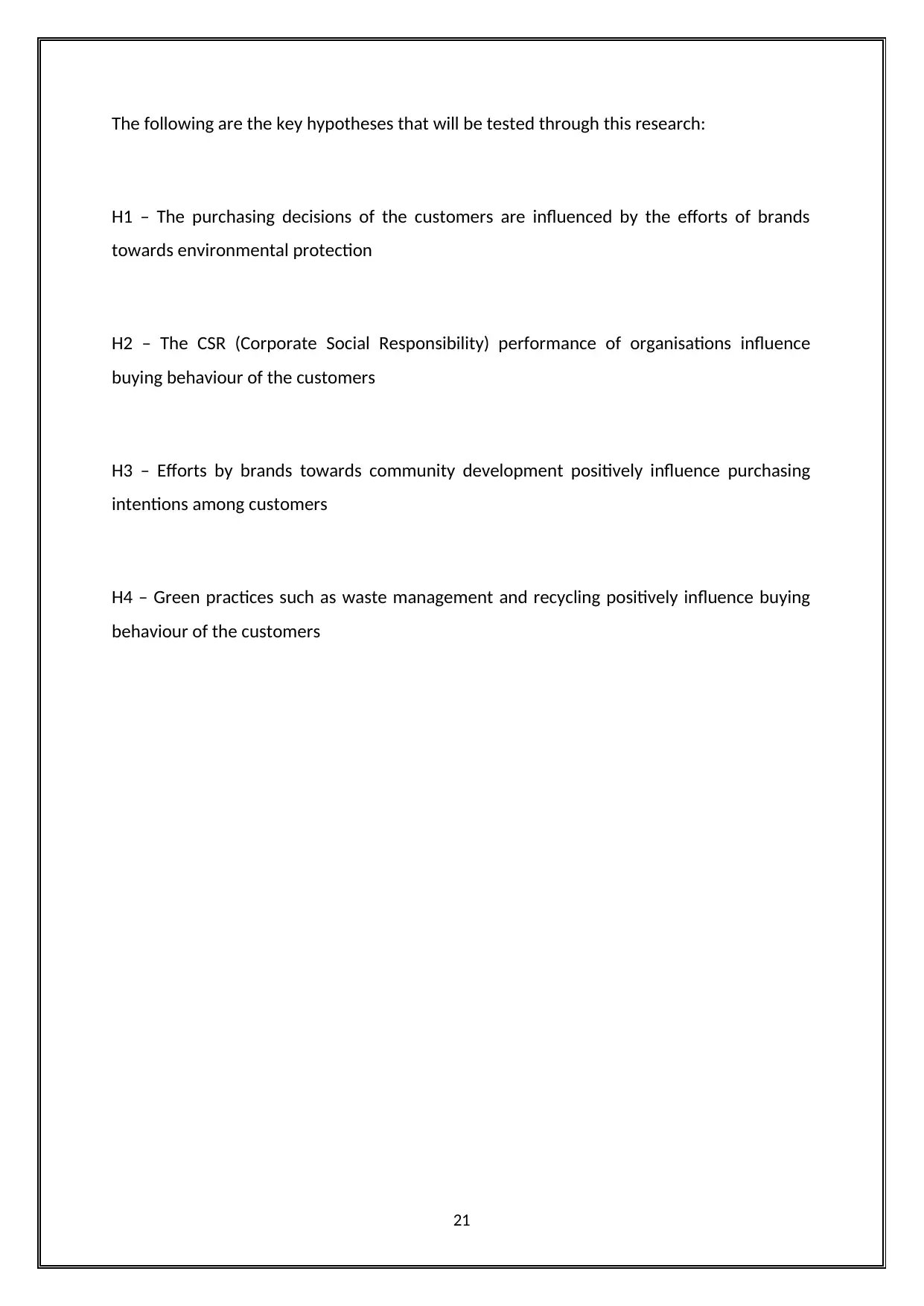
The following are the key hypotheses that will be tested through this research:
H1 – The purchasing decisions of the customers are influenced by the efforts of brands
towards environmental protection
H2 – The CSR (Corporate Social Responsibility) performance of organisations influence
buying behaviour of the customers
H3 – Efforts by brands towards community development positively influence purchasing
intentions among customers
H4 – Green practices such as waste management and recycling positively influence buying
behaviour of the customers
21
H1 – The purchasing decisions of the customers are influenced by the efforts of brands
towards environmental protection
H2 – The CSR (Corporate Social Responsibility) performance of organisations influence
buying behaviour of the customers
H3 – Efforts by brands towards community development positively influence purchasing
intentions among customers
H4 – Green practices such as waste management and recycling positively influence buying
behaviour of the customers
21
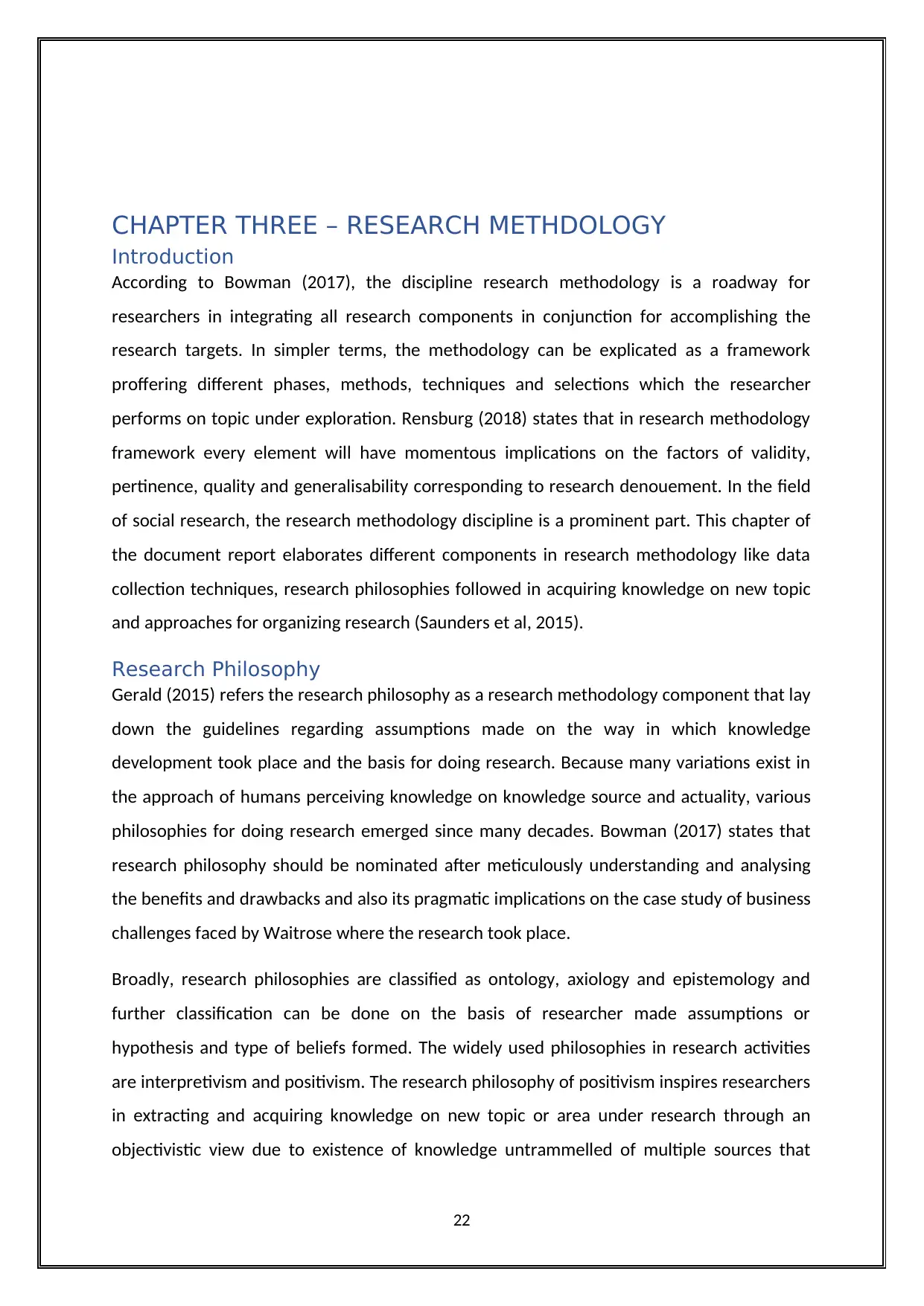
CHAPTER THREE – RESEARCH METHDOLOGY
Introduction
According to Bowman (2017), the discipline research methodology is a roadway for
researchers in integrating all research components in conjunction for accomplishing the
research targets. In simpler terms, the methodology can be explicated as a framework
proffering different phases, methods, techniques and selections which the researcher
performs on topic under exploration. Rensburg (2018) states that in research methodology
framework every element will have momentous implications on the factors of validity,
pertinence, quality and generalisability corresponding to research denouement. In the field
of social research, the research methodology discipline is a prominent part. This chapter of
the document report elaborates different components in research methodology like data
collection techniques, research philosophies followed in acquiring knowledge on new topic
and approaches for organizing research (Saunders et al, 2015).
Research Philosophy
Gerald (2015) refers the research philosophy as a research methodology component that lay
down the guidelines regarding assumptions made on the way in which knowledge
development took place and the basis for doing research. Because many variations exist in
the approach of humans perceiving knowledge on knowledge source and actuality, various
philosophies for doing research emerged since many decades. Bowman (2017) states that
research philosophy should be nominated after meticulously understanding and analysing
the benefits and drawbacks and also its pragmatic implications on the case study of business
challenges faced by Waitrose where the research took place.
Broadly, research philosophies are classified as ontology, axiology and epistemology and
further classification can be done on the basis of researcher made assumptions or
hypothesis and type of beliefs formed. The widely used philosophies in research activities
are interpretivism and positivism. The research philosophy of positivism inspires researchers
in extracting and acquiring knowledge on new topic or area under research through an
objectivistic view due to existence of knowledge untrammelled of multiple sources that
22
Introduction
According to Bowman (2017), the discipline research methodology is a roadway for
researchers in integrating all research components in conjunction for accomplishing the
research targets. In simpler terms, the methodology can be explicated as a framework
proffering different phases, methods, techniques and selections which the researcher
performs on topic under exploration. Rensburg (2018) states that in research methodology
framework every element will have momentous implications on the factors of validity,
pertinence, quality and generalisability corresponding to research denouement. In the field
of social research, the research methodology discipline is a prominent part. This chapter of
the document report elaborates different components in research methodology like data
collection techniques, research philosophies followed in acquiring knowledge on new topic
and approaches for organizing research (Saunders et al, 2015).
Research Philosophy
Gerald (2015) refers the research philosophy as a research methodology component that lay
down the guidelines regarding assumptions made on the way in which knowledge
development took place and the basis for doing research. Because many variations exist in
the approach of humans perceiving knowledge on knowledge source and actuality, various
philosophies for doing research emerged since many decades. Bowman (2017) states that
research philosophy should be nominated after meticulously understanding and analysing
the benefits and drawbacks and also its pragmatic implications on the case study of business
challenges faced by Waitrose where the research took place.
Broadly, research philosophies are classified as ontology, axiology and epistemology and
further classification can be done on the basis of researcher made assumptions or
hypothesis and type of beliefs formed. The widely used philosophies in research activities
are interpretivism and positivism. The research philosophy of positivism inspires researchers
in extracting and acquiring knowledge on new topic or area under research through an
objectivistic view due to existence of knowledge untrammelled of multiple sources that
22
Secure Best Marks with AI Grader
Need help grading? Try our AI Grader for instant feedback on your assignments.
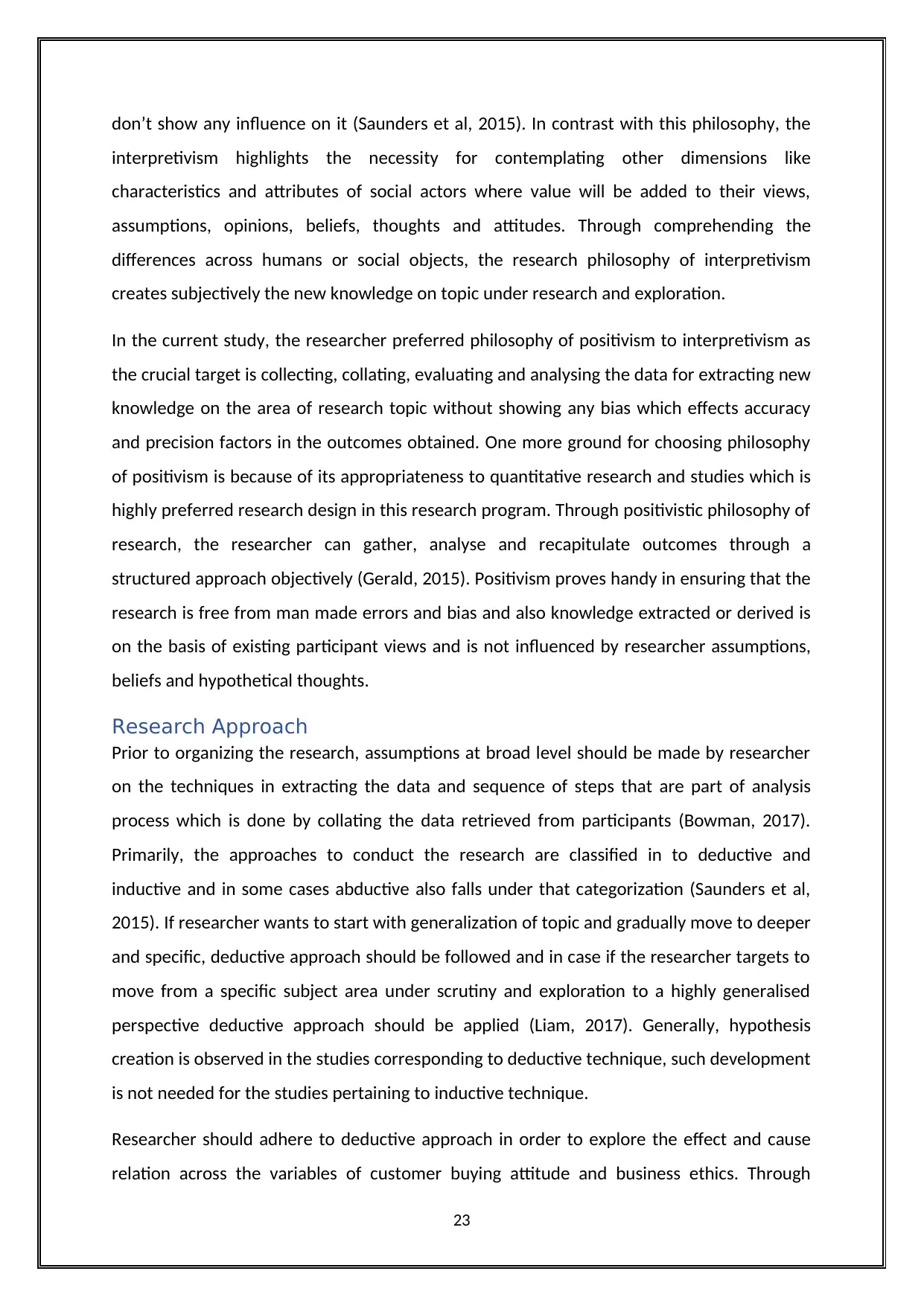
don’t show any influence on it (Saunders et al, 2015). In contrast with this philosophy, the
interpretivism highlights the necessity for contemplating other dimensions like
characteristics and attributes of social actors where value will be added to their views,
assumptions, opinions, beliefs, thoughts and attitudes. Through comprehending the
differences across humans or social objects, the research philosophy of interpretivism
creates subjectively the new knowledge on topic under research and exploration.
In the current study, the researcher preferred philosophy of positivism to interpretivism as
the crucial target is collecting, collating, evaluating and analysing the data for extracting new
knowledge on the area of research topic without showing any bias which effects accuracy
and precision factors in the outcomes obtained. One more ground for choosing philosophy
of positivism is because of its appropriateness to quantitative research and studies which is
highly preferred research design in this research program. Through positivistic philosophy of
research, the researcher can gather, analyse and recapitulate outcomes through a
structured approach objectively (Gerald, 2015). Positivism proves handy in ensuring that the
research is free from man made errors and bias and also knowledge extracted or derived is
on the basis of existing participant views and is not influenced by researcher assumptions,
beliefs and hypothetical thoughts.
Research Approach
Prior to organizing the research, assumptions at broad level should be made by researcher
on the techniques in extracting the data and sequence of steps that are part of analysis
process which is done by collating the data retrieved from participants (Bowman, 2017).
Primarily, the approaches to conduct the research are classified in to deductive and
inductive and in some cases abductive also falls under that categorization (Saunders et al,
2015). If researcher wants to start with generalization of topic and gradually move to deeper
and specific, deductive approach should be followed and in case if the researcher targets to
move from a specific subject area under scrutiny and exploration to a highly generalised
perspective deductive approach should be applied (Liam, 2017). Generally, hypothesis
creation is observed in the studies corresponding to deductive technique, such development
is not needed for the studies pertaining to inductive technique.
Researcher should adhere to deductive approach in order to explore the effect and cause
relation across the variables of customer buying attitude and business ethics. Through
23
interpretivism highlights the necessity for contemplating other dimensions like
characteristics and attributes of social actors where value will be added to their views,
assumptions, opinions, beliefs, thoughts and attitudes. Through comprehending the
differences across humans or social objects, the research philosophy of interpretivism
creates subjectively the new knowledge on topic under research and exploration.
In the current study, the researcher preferred philosophy of positivism to interpretivism as
the crucial target is collecting, collating, evaluating and analysing the data for extracting new
knowledge on the area of research topic without showing any bias which effects accuracy
and precision factors in the outcomes obtained. One more ground for choosing philosophy
of positivism is because of its appropriateness to quantitative research and studies which is
highly preferred research design in this research program. Through positivistic philosophy of
research, the researcher can gather, analyse and recapitulate outcomes through a
structured approach objectively (Gerald, 2015). Positivism proves handy in ensuring that the
research is free from man made errors and bias and also knowledge extracted or derived is
on the basis of existing participant views and is not influenced by researcher assumptions,
beliefs and hypothetical thoughts.
Research Approach
Prior to organizing the research, assumptions at broad level should be made by researcher
on the techniques in extracting the data and sequence of steps that are part of analysis
process which is done by collating the data retrieved from participants (Bowman, 2017).
Primarily, the approaches to conduct the research are classified in to deductive and
inductive and in some cases abductive also falls under that categorization (Saunders et al,
2015). If researcher wants to start with generalization of topic and gradually move to deeper
and specific, deductive approach should be followed and in case if the researcher targets to
move from a specific subject area under scrutiny and exploration to a highly generalised
perspective deductive approach should be applied (Liam, 2017). Generally, hypothesis
creation is observed in the studies corresponding to deductive technique, such development
is not needed for the studies pertaining to inductive technique.
Researcher should adhere to deductive approach in order to explore the effect and cause
relation across the variables of customer buying attitude and business ethics. Through
23
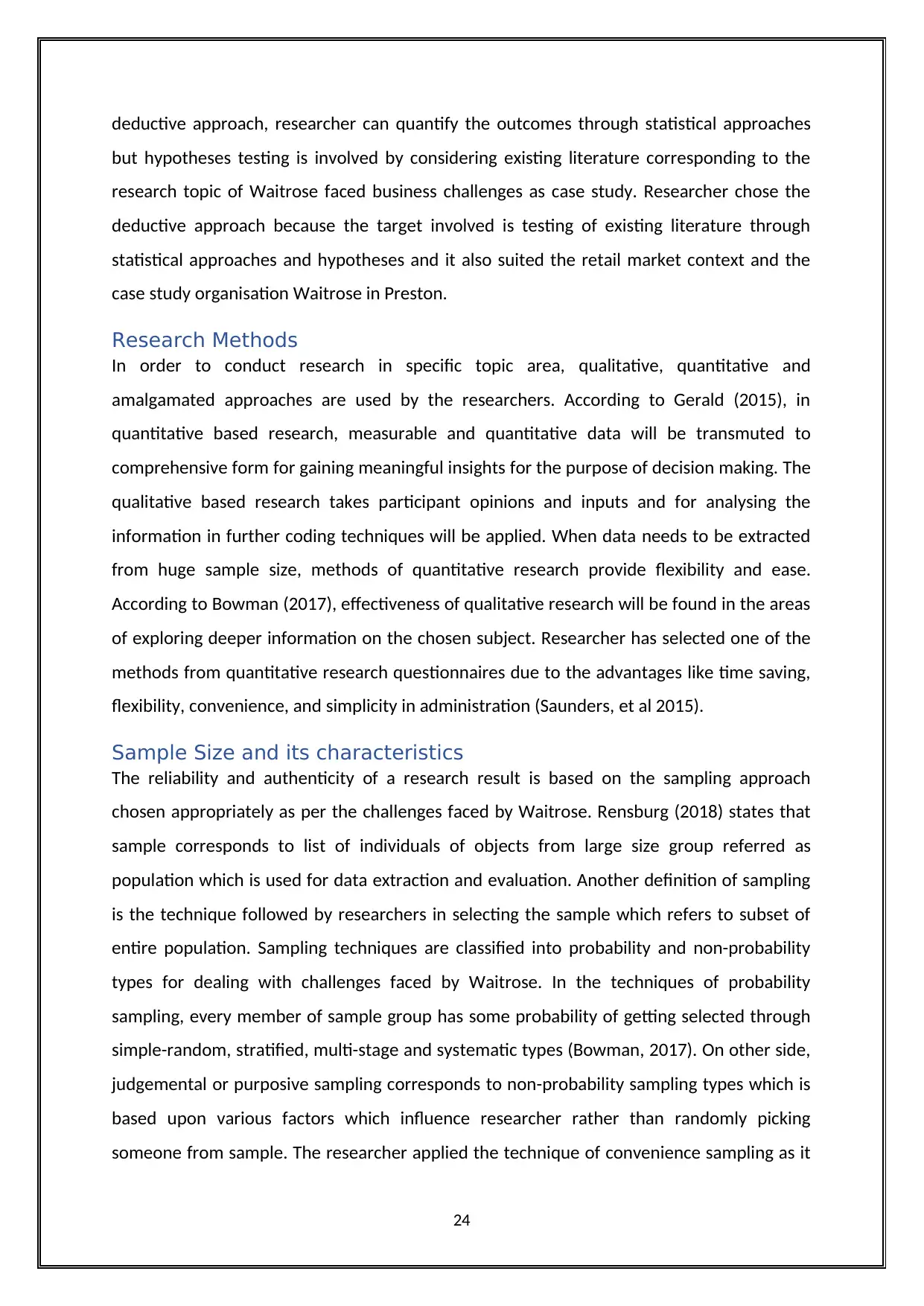
deductive approach, researcher can quantify the outcomes through statistical approaches
but hypotheses testing is involved by considering existing literature corresponding to the
research topic of Waitrose faced business challenges as case study. Researcher chose the
deductive approach because the target involved is testing of existing literature through
statistical approaches and hypotheses and it also suited the retail market context and the
case study organisation Waitrose in Preston.
Research Methods
In order to conduct research in specific topic area, qualitative, quantitative and
amalgamated approaches are used by the researchers. According to Gerald (2015), in
quantitative based research, measurable and quantitative data will be transmuted to
comprehensive form for gaining meaningful insights for the purpose of decision making. The
qualitative based research takes participant opinions and inputs and for analysing the
information in further coding techniques will be applied. When data needs to be extracted
from huge sample size, methods of quantitative research provide flexibility and ease.
According to Bowman (2017), effectiveness of qualitative research will be found in the areas
of exploring deeper information on the chosen subject. Researcher has selected one of the
methods from quantitative research questionnaires due to the advantages like time saving,
flexibility, convenience, and simplicity in administration (Saunders, et al 2015).
Sample Size and its characteristics
The reliability and authenticity of a research result is based on the sampling approach
chosen appropriately as per the challenges faced by Waitrose. Rensburg (2018) states that
sample corresponds to list of individuals of objects from large size group referred as
population which is used for data extraction and evaluation. Another definition of sampling
is the technique followed by researchers in selecting the sample which refers to subset of
entire population. Sampling techniques are classified into probability and non-probability
types for dealing with challenges faced by Waitrose. In the techniques of probability
sampling, every member of sample group has some probability of getting selected through
simple-random, stratified, multi-stage and systematic types (Bowman, 2017). On other side,
judgemental or purposive sampling corresponds to non-probability sampling types which is
based upon various factors which influence researcher rather than randomly picking
someone from sample. The researcher applied the technique of convenience sampling as it
24
but hypotheses testing is involved by considering existing literature corresponding to the
research topic of Waitrose faced business challenges as case study. Researcher chose the
deductive approach because the target involved is testing of existing literature through
statistical approaches and hypotheses and it also suited the retail market context and the
case study organisation Waitrose in Preston.
Research Methods
In order to conduct research in specific topic area, qualitative, quantitative and
amalgamated approaches are used by the researchers. According to Gerald (2015), in
quantitative based research, measurable and quantitative data will be transmuted to
comprehensive form for gaining meaningful insights for the purpose of decision making. The
qualitative based research takes participant opinions and inputs and for analysing the
information in further coding techniques will be applied. When data needs to be extracted
from huge sample size, methods of quantitative research provide flexibility and ease.
According to Bowman (2017), effectiveness of qualitative research will be found in the areas
of exploring deeper information on the chosen subject. Researcher has selected one of the
methods from quantitative research questionnaires due to the advantages like time saving,
flexibility, convenience, and simplicity in administration (Saunders, et al 2015).
Sample Size and its characteristics
The reliability and authenticity of a research result is based on the sampling approach
chosen appropriately as per the challenges faced by Waitrose. Rensburg (2018) states that
sample corresponds to list of individuals of objects from large size group referred as
population which is used for data extraction and evaluation. Another definition of sampling
is the technique followed by researchers in selecting the sample which refers to subset of
entire population. Sampling techniques are classified into probability and non-probability
types for dealing with challenges faced by Waitrose. In the techniques of probability
sampling, every member of sample group has some probability of getting selected through
simple-random, stratified, multi-stage and systematic types (Bowman, 2017). On other side,
judgemental or purposive sampling corresponds to non-probability sampling types which is
based upon various factors which influence researcher rather than randomly picking
someone from sample. The researcher applied the technique of convenience sampling as it
24
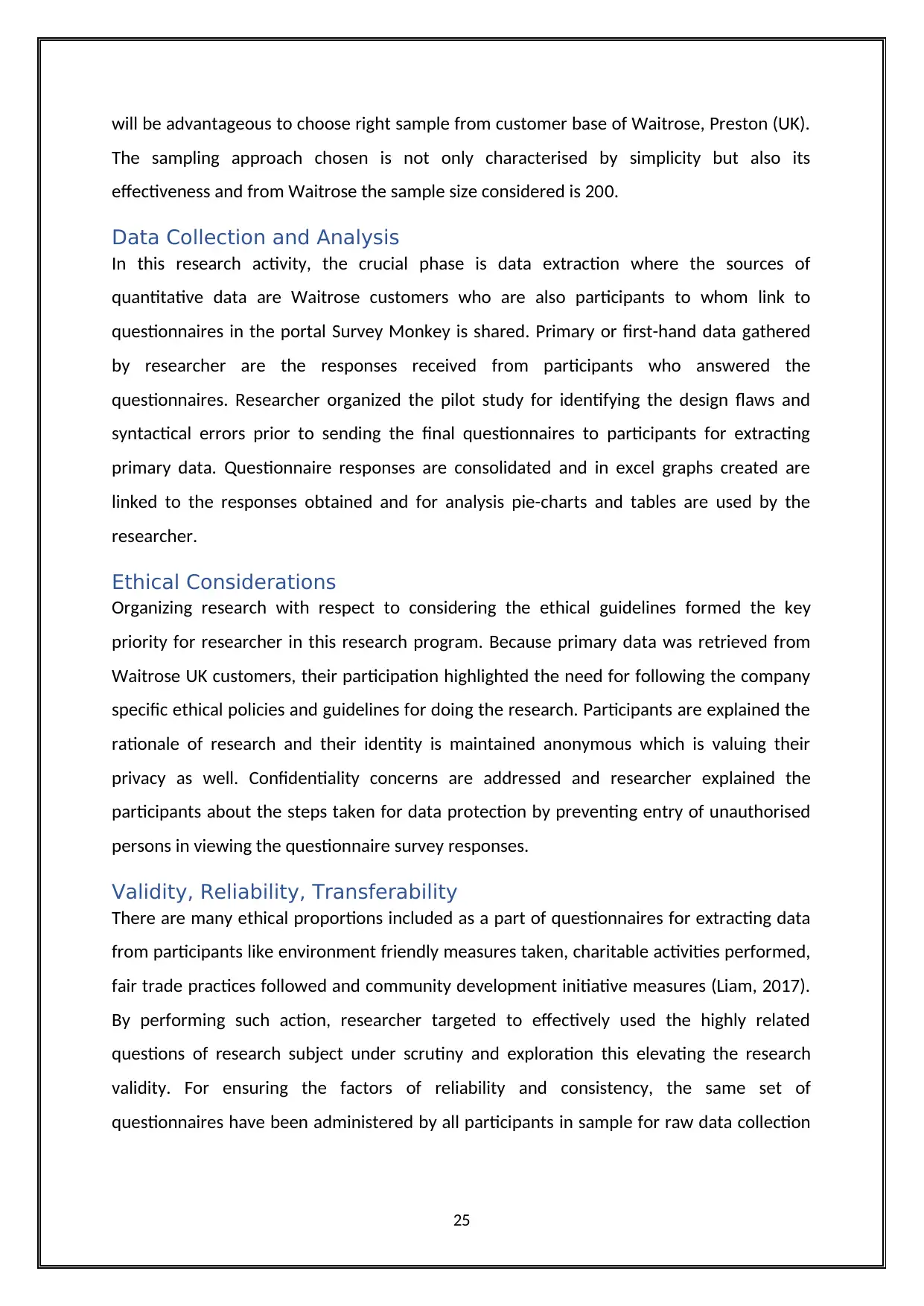
will be advantageous to choose right sample from customer base of Waitrose, Preston (UK).
The sampling approach chosen is not only characterised by simplicity but also its
effectiveness and from Waitrose the sample size considered is 200.
Data Collection and Analysis
In this research activity, the crucial phase is data extraction where the sources of
quantitative data are Waitrose customers who are also participants to whom link to
questionnaires in the portal Survey Monkey is shared. Primary or first-hand data gathered
by researcher are the responses received from participants who answered the
questionnaires. Researcher organized the pilot study for identifying the design flaws and
syntactical errors prior to sending the final questionnaires to participants for extracting
primary data. Questionnaire responses are consolidated and in excel graphs created are
linked to the responses obtained and for analysis pie-charts and tables are used by the
researcher.
Ethical Considerations
Organizing research with respect to considering the ethical guidelines formed the key
priority for researcher in this research program. Because primary data was retrieved from
Waitrose UK customers, their participation highlighted the need for following the company
specific ethical policies and guidelines for doing the research. Participants are explained the
rationale of research and their identity is maintained anonymous which is valuing their
privacy as well. Confidentiality concerns are addressed and researcher explained the
participants about the steps taken for data protection by preventing entry of unauthorised
persons in viewing the questionnaire survey responses.
Validity, Reliability, Transferability
There are many ethical proportions included as a part of questionnaires for extracting data
from participants like environment friendly measures taken, charitable activities performed,
fair trade practices followed and community development initiative measures (Liam, 2017).
By performing such action, researcher targeted to effectively used the highly related
questions of research subject under scrutiny and exploration this elevating the research
validity. For ensuring the factors of reliability and consistency, the same set of
questionnaires have been administered by all participants in sample for raw data collection
25
The sampling approach chosen is not only characterised by simplicity but also its
effectiveness and from Waitrose the sample size considered is 200.
Data Collection and Analysis
In this research activity, the crucial phase is data extraction where the sources of
quantitative data are Waitrose customers who are also participants to whom link to
questionnaires in the portal Survey Monkey is shared. Primary or first-hand data gathered
by researcher are the responses received from participants who answered the
questionnaires. Researcher organized the pilot study for identifying the design flaws and
syntactical errors prior to sending the final questionnaires to participants for extracting
primary data. Questionnaire responses are consolidated and in excel graphs created are
linked to the responses obtained and for analysis pie-charts and tables are used by the
researcher.
Ethical Considerations
Organizing research with respect to considering the ethical guidelines formed the key
priority for researcher in this research program. Because primary data was retrieved from
Waitrose UK customers, their participation highlighted the need for following the company
specific ethical policies and guidelines for doing the research. Participants are explained the
rationale of research and their identity is maintained anonymous which is valuing their
privacy as well. Confidentiality concerns are addressed and researcher explained the
participants about the steps taken for data protection by preventing entry of unauthorised
persons in viewing the questionnaire survey responses.
Validity, Reliability, Transferability
There are many ethical proportions included as a part of questionnaires for extracting data
from participants like environment friendly measures taken, charitable activities performed,
fair trade practices followed and community development initiative measures (Liam, 2017).
By performing such action, researcher targeted to effectively used the highly related
questions of research subject under scrutiny and exploration this elevating the research
validity. For ensuring the factors of reliability and consistency, the same set of
questionnaires have been administered by all participants in sample for raw data collection
25
Paraphrase This Document
Need a fresh take? Get an instant paraphrase of this document with our AI Paraphraser
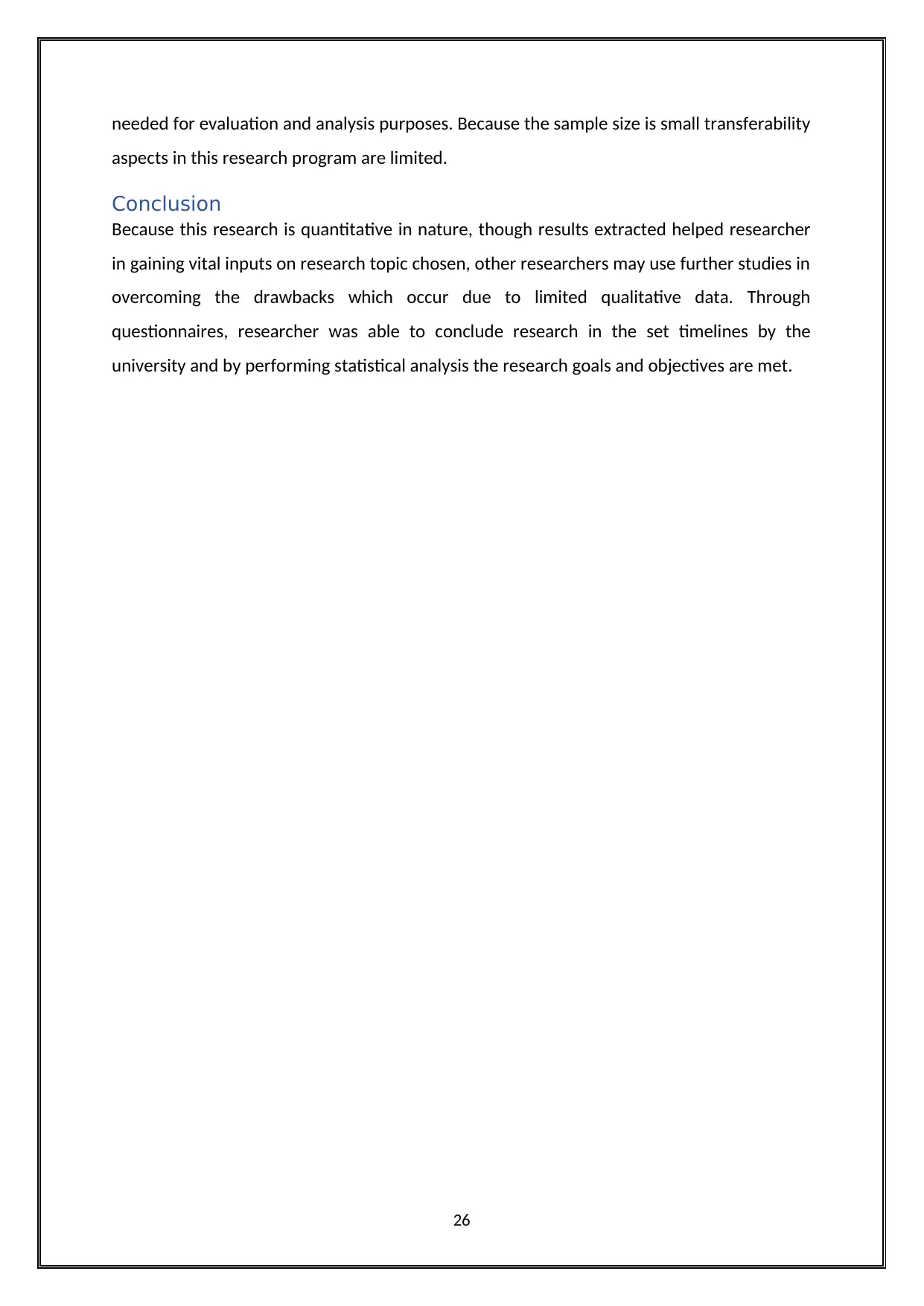
needed for evaluation and analysis purposes. Because the sample size is small transferability
aspects in this research program are limited.
Conclusion
Because this research is quantitative in nature, though results extracted helped researcher
in gaining vital inputs on research topic chosen, other researchers may use further studies in
overcoming the drawbacks which occur due to limited qualitative data. Through
questionnaires, researcher was able to conclude research in the set timelines by the
university and by performing statistical analysis the research goals and objectives are met.
26
aspects in this research program are limited.
Conclusion
Because this research is quantitative in nature, though results extracted helped researcher
in gaining vital inputs on research topic chosen, other researchers may use further studies in
overcoming the drawbacks which occur due to limited qualitative data. Through
questionnaires, researcher was able to conclude research in the set timelines by the
university and by performing statistical analysis the research goals and objectives are met.
26

CHAPTER FOUR – ANALYSIS AND FINDINGS
In this section, the data collected from the customers of Waitrose & Partners based in
Preston is graphically represented using pie-charts and tables and the research outcomes
are discussed.
The following are the responses obtained for each question included in the online
questionnaire.
1. Please Specify your Age
53%
30%
13% 5%
21-27
28-35
36-50
51 or above
21-27 21
28-35 12
36-50 5
51 or above 2
TOTAL 40
The pie chart mentioned above describes the age of the public participated in the survey. It
is clearly observed from the pie chart that the young are the majority of people who took
part in the survey with more interest. In detail, people whose age lies between 21 to 27
27
In this section, the data collected from the customers of Waitrose & Partners based in
Preston is graphically represented using pie-charts and tables and the research outcomes
are discussed.
The following are the responses obtained for each question included in the online
questionnaire.
1. Please Specify your Age
53%
30%
13% 5%
21-27
28-35
36-50
51 or above
21-27 21
28-35 12
36-50 5
51 or above 2
TOTAL 40
The pie chart mentioned above describes the age of the public participated in the survey. It
is clearly observed from the pie chart that the young are the majority of people who took
part in the survey with more interest. In detail, people whose age lies between 21 to 27
27
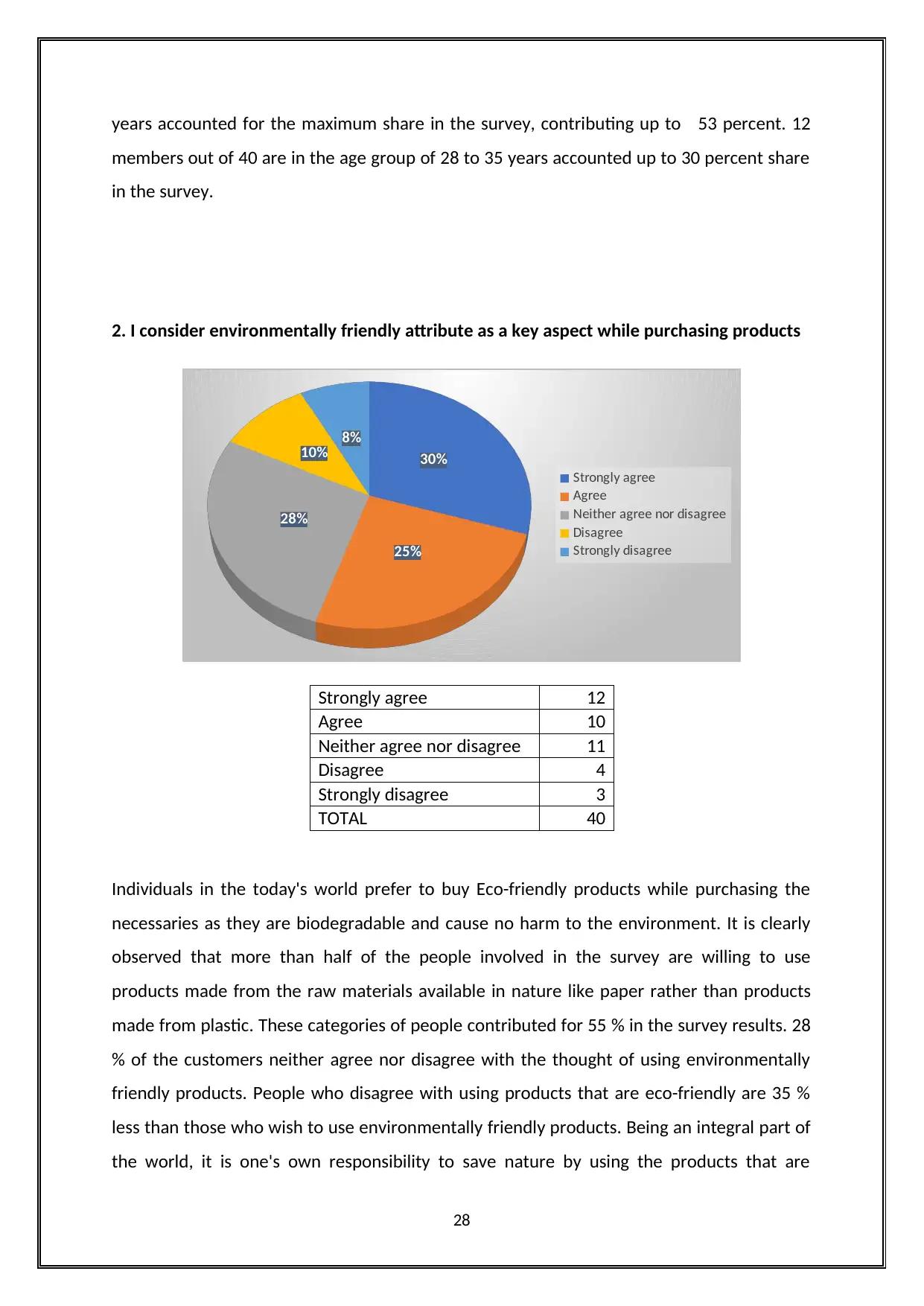
years accounted for the maximum share in the survey, contributing up to 53 percent. 12
members out of 40 are in the age group of 28 to 35 years accounted up to 30 percent share
in the survey.
2. I consider environmentally friendly attribute as a key aspect while purchasing products
30%
25%
28%
10% 8%
Strongly agree
Agree
Neither agree nor disagree
Disagree
Strongly disagree
Strongly agree 12
Agree 10
Neither agree nor disagree 11
Disagree 4
Strongly disagree 3
TOTAL 40
Individuals in the today's world prefer to buy Eco-friendly products while purchasing the
necessaries as they are biodegradable and cause no harm to the environment. It is clearly
observed that more than half of the people involved in the survey are willing to use
products made from the raw materials available in nature like paper rather than products
made from plastic. These categories of people contributed for 55 % in the survey results. 28
% of the customers neither agree nor disagree with the thought of using environmentally
friendly products. People who disagree with using products that are eco-friendly are 35 %
less than those who wish to use environmentally friendly products. Being an integral part of
the world, it is one's own responsibility to save nature by using the products that are
28
members out of 40 are in the age group of 28 to 35 years accounted up to 30 percent share
in the survey.
2. I consider environmentally friendly attribute as a key aspect while purchasing products
30%
25%
28%
10% 8%
Strongly agree
Agree
Neither agree nor disagree
Disagree
Strongly disagree
Strongly agree 12
Agree 10
Neither agree nor disagree 11
Disagree 4
Strongly disagree 3
TOTAL 40
Individuals in the today's world prefer to buy Eco-friendly products while purchasing the
necessaries as they are biodegradable and cause no harm to the environment. It is clearly
observed that more than half of the people involved in the survey are willing to use
products made from the raw materials available in nature like paper rather than products
made from plastic. These categories of people contributed for 55 % in the survey results. 28
% of the customers neither agree nor disagree with the thought of using environmentally
friendly products. People who disagree with using products that are eco-friendly are 35 %
less than those who wish to use environmentally friendly products. Being an integral part of
the world, it is one's own responsibility to save nature by using the products that are
28
Secure Best Marks with AI Grader
Need help grading? Try our AI Grader for instant feedback on your assignments.
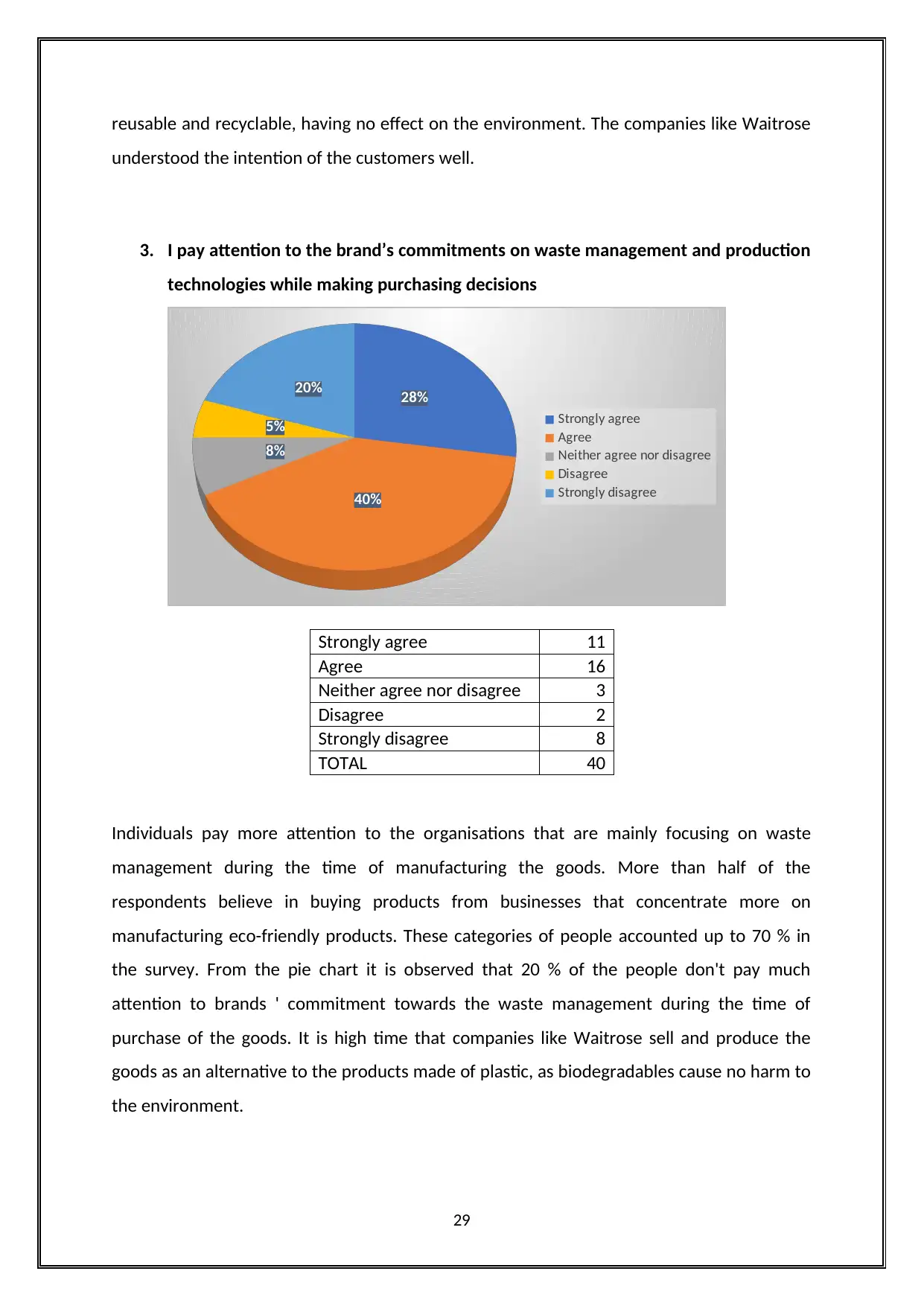
reusable and recyclable, having no effect on the environment. The companies like Waitrose
understood the intention of the customers well.
3. I pay attention to the brand’s commitments on waste management and production
technologies while making purchasing decisions
28%
40%
8%
5%
20%
Strongly agree
Agree
Neither agree nor disagree
Disagree
Strongly disagree
Strongly agree 11
Agree 16
Neither agree nor disagree 3
Disagree 2
Strongly disagree 8
TOTAL 40
Individuals pay more attention to the organisations that are mainly focusing on waste
management during the time of manufacturing the goods. More than half of the
respondents believe in buying products from businesses that concentrate more on
manufacturing eco-friendly products. These categories of people accounted up to 70 % in
the survey. From the pie chart it is observed that 20 % of the people don't pay much
attention to brands ' commitment towards the waste management during the time of
purchase of the goods. It is high time that companies like Waitrose sell and produce the
goods as an alternative to the products made of plastic, as biodegradables cause no harm to
the environment.
29
understood the intention of the customers well.
3. I pay attention to the brand’s commitments on waste management and production
technologies while making purchasing decisions
28%
40%
8%
5%
20%
Strongly agree
Agree
Neither agree nor disagree
Disagree
Strongly disagree
Strongly agree 11
Agree 16
Neither agree nor disagree 3
Disagree 2
Strongly disagree 8
TOTAL 40
Individuals pay more attention to the organisations that are mainly focusing on waste
management during the time of manufacturing the goods. More than half of the
respondents believe in buying products from businesses that concentrate more on
manufacturing eco-friendly products. These categories of people accounted up to 70 % in
the survey. From the pie chart it is observed that 20 % of the people don't pay much
attention to brands ' commitment towards the waste management during the time of
purchase of the goods. It is high time that companies like Waitrose sell and produce the
goods as an alternative to the products made of plastic, as biodegradables cause no harm to
the environment.
29

4. I consider reuse/recycling programs of retail supermarkets before buying from
them
30%
33%
20%
13% 5%
Strongly agree
Agree
Neither agree nor disagree
Disagree
Strongly disagree
Strongly agree 12
Agree 13
Neither agree nor disagree 8
Disagree 5
Strongly disagree 2
TOTAL 40
The pie chart indicates the consumers attention towards the grocery store and retail
supermarkets whose first priority is reuse and recycling of waste. Recycling of used products
results in reduction of usage of raw materials which are naturally available. Approximately
65 % of the consumers focus on the waste management programs by the stores before
buying products from them. 25 out of 40 who participated in the survey fall under this
category. 20 % of the consumers neither agree nor disagree with the tradition of the reusing
and recycling of the products by the supermarkets. Consumers who disagree with the idea
of recycle/recycle of the goods are 45 % less compared to customers who believe in waste
management during the time of purchase of necessaries.
30
them
30%
33%
20%
13% 5%
Strongly agree
Agree
Neither agree nor disagree
Disagree
Strongly disagree
Strongly agree 12
Agree 13
Neither agree nor disagree 8
Disagree 5
Strongly disagree 2
TOTAL 40
The pie chart indicates the consumers attention towards the grocery store and retail
supermarkets whose first priority is reuse and recycling of waste. Recycling of used products
results in reduction of usage of raw materials which are naturally available. Approximately
65 % of the consumers focus on the waste management programs by the stores before
buying products from them. 25 out of 40 who participated in the survey fall under this
category. 20 % of the consumers neither agree nor disagree with the tradition of the reusing
and recycling of the products by the supermarkets. Consumers who disagree with the idea
of recycle/recycle of the goods are 45 % less compared to customers who believe in waste
management during the time of purchase of necessaries.
30
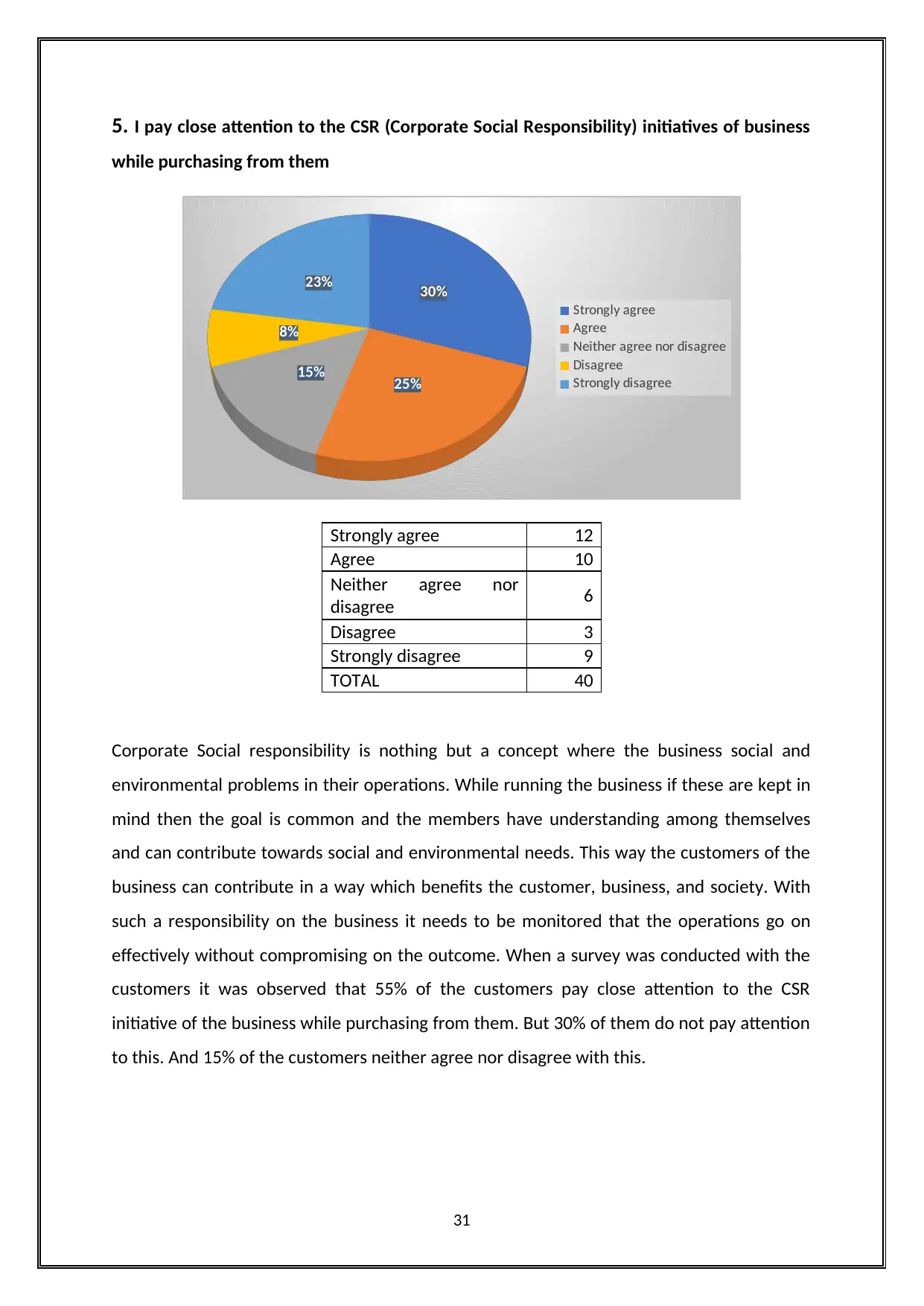
5. I pay close attention to the CSR (Corporate Social Responsibility) initiatives of business
while purchasing from them
30%
25%
15%
8%
23%
Strongly agree
Agree
Neither agree nor disagree
Disagree
Strongly disagree
Strongly agree 12
Agree 10
Neither agree nor
disagree 6
Disagree 3
Strongly disagree 9
TOTAL 40
Corporate Social responsibility is nothing but a concept where the business social and
environmental problems in their operations. While running the business if these are kept in
mind then the goal is common and the members have understanding among themselves
and can contribute towards social and environmental needs. This way the customers of the
business can contribute in a way which benefits the customer, business, and society. With
such a responsibility on the business it needs to be monitored that the operations go on
effectively without compromising on the outcome. When a survey was conducted with the
customers it was observed that 55% of the customers pay close attention to the CSR
initiative of the business while purchasing from them. But 30% of them do not pay attention
to this. And 15% of the customers neither agree nor disagree with this.
31
while purchasing from them
30%
25%
15%
8%
23%
Strongly agree
Agree
Neither agree nor disagree
Disagree
Strongly disagree
Strongly agree 12
Agree 10
Neither agree nor
disagree 6
Disagree 3
Strongly disagree 9
TOTAL 40
Corporate Social responsibility is nothing but a concept where the business social and
environmental problems in their operations. While running the business if these are kept in
mind then the goal is common and the members have understanding among themselves
and can contribute towards social and environmental needs. This way the customers of the
business can contribute in a way which benefits the customer, business, and society. With
such a responsibility on the business it needs to be monitored that the operations go on
effectively without compromising on the outcome. When a survey was conducted with the
customers it was observed that 55% of the customers pay close attention to the CSR
initiative of the business while purchasing from them. But 30% of them do not pay attention
to this. And 15% of the customers neither agree nor disagree with this.
31
Paraphrase This Document
Need a fresh take? Get an instant paraphrase of this document with our AI Paraphraser
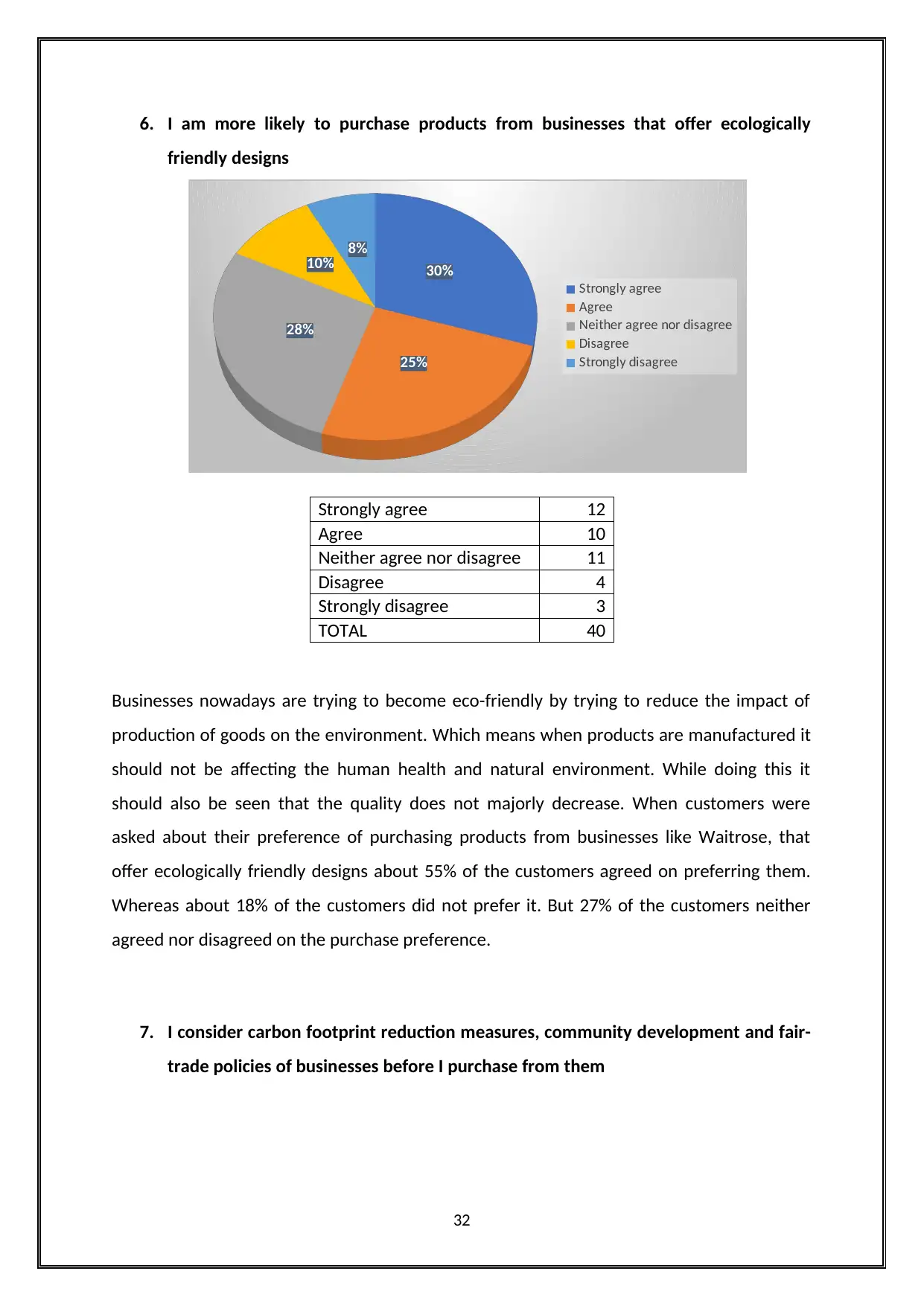
6. I am more likely to purchase products from businesses that offer ecologically
friendly designs
30%
25%
28%
10% 8%
Strongly agree
Agree
Neither agree nor disagree
Disagree
Strongly disagree
Strongly agree 12
Agree 10
Neither agree nor disagree 11
Disagree 4
Strongly disagree 3
TOTAL 40
Businesses nowadays are trying to become eco-friendly by trying to reduce the impact of
production of goods on the environment. Which means when products are manufactured it
should not be affecting the human health and natural environment. While doing this it
should also be seen that the quality does not majorly decrease. When customers were
asked about their preference of purchasing products from businesses like Waitrose, that
offer ecologically friendly designs about 55% of the customers agreed on preferring them.
Whereas about 18% of the customers did not prefer it. But 27% of the customers neither
agreed nor disagreed on the purchase preference.
7. I consider carbon footprint reduction measures, community development and fair-
trade policies of businesses before I purchase from them
32
friendly designs
30%
25%
28%
10% 8%
Strongly agree
Agree
Neither agree nor disagree
Disagree
Strongly disagree
Strongly agree 12
Agree 10
Neither agree nor disagree 11
Disagree 4
Strongly disagree 3
TOTAL 40
Businesses nowadays are trying to become eco-friendly by trying to reduce the impact of
production of goods on the environment. Which means when products are manufactured it
should not be affecting the human health and natural environment. While doing this it
should also be seen that the quality does not majorly decrease. When customers were
asked about their preference of purchasing products from businesses like Waitrose, that
offer ecologically friendly designs about 55% of the customers agreed on preferring them.
Whereas about 18% of the customers did not prefer it. But 27% of the customers neither
agreed nor disagreed on the purchase preference.
7. I consider carbon footprint reduction measures, community development and fair-
trade policies of businesses before I purchase from them
32
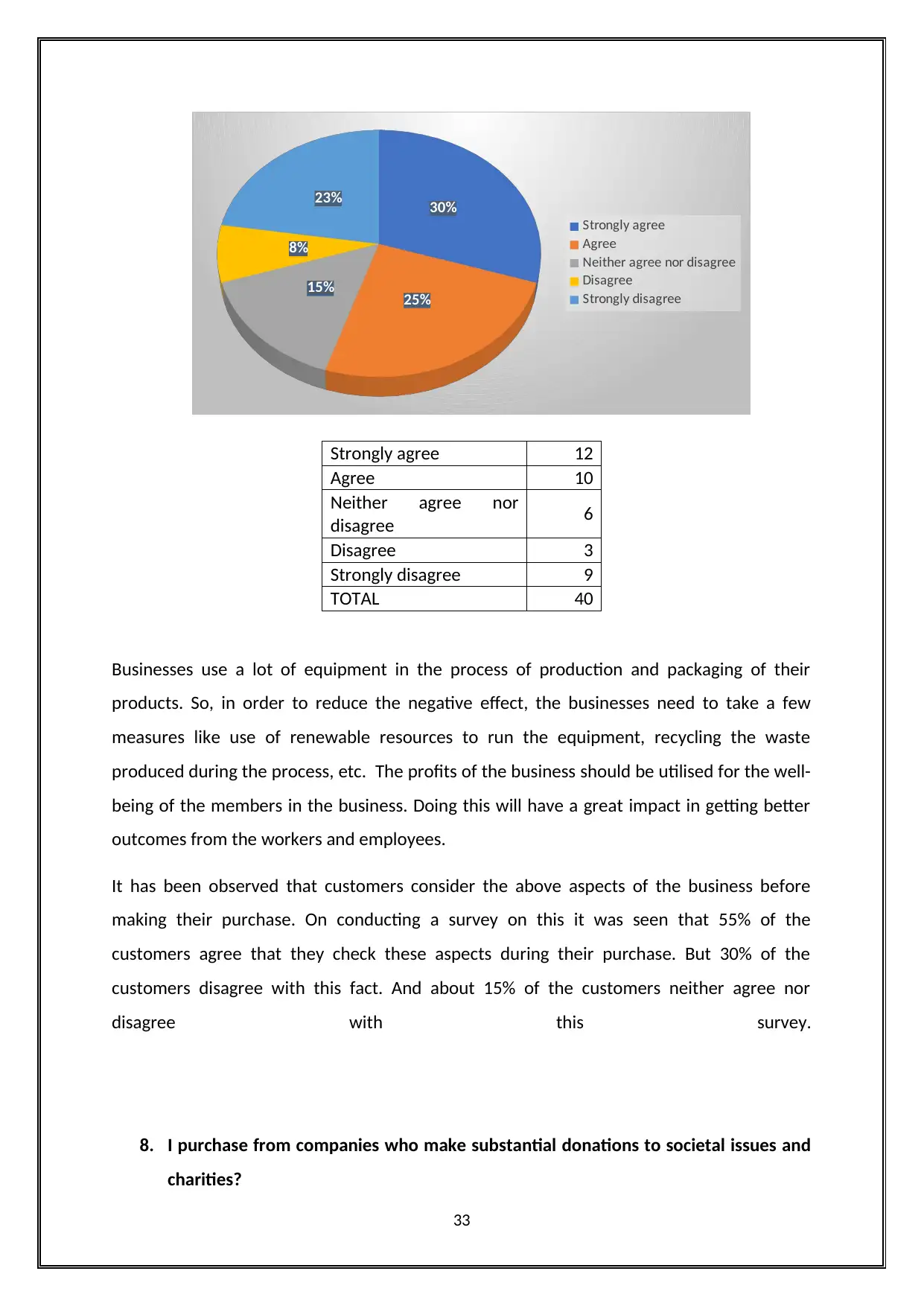
30%
25%
15%
8%
23%
Strongly agree
Agree
Neither agree nor disagree
Disagree
Strongly disagree
Strongly agree 12
Agree 10
Neither agree nor
disagree 6
Disagree 3
Strongly disagree 9
TOTAL 40
Businesses use a lot of equipment in the process of production and packaging of their
products. So, in order to reduce the negative effect, the businesses need to take a few
measures like use of renewable resources to run the equipment, recycling the waste
produced during the process, etc. The profits of the business should be utilised for the well-
being of the members in the business. Doing this will have a great impact in getting better
outcomes from the workers and employees.
It has been observed that customers consider the above aspects of the business before
making their purchase. On conducting a survey on this it was seen that 55% of the
customers agree that they check these aspects during their purchase. But 30% of the
customers disagree with this fact. And about 15% of the customers neither agree nor
disagree with this survey.
8. I purchase from companies who make substantial donations to societal issues and
charities?
33
25%
15%
8%
23%
Strongly agree
Agree
Neither agree nor disagree
Disagree
Strongly disagree
Strongly agree 12
Agree 10
Neither agree nor
disagree 6
Disagree 3
Strongly disagree 9
TOTAL 40
Businesses use a lot of equipment in the process of production and packaging of their
products. So, in order to reduce the negative effect, the businesses need to take a few
measures like use of renewable resources to run the equipment, recycling the waste
produced during the process, etc. The profits of the business should be utilised for the well-
being of the members in the business. Doing this will have a great impact in getting better
outcomes from the workers and employees.
It has been observed that customers consider the above aspects of the business before
making their purchase. On conducting a survey on this it was seen that 55% of the
customers agree that they check these aspects during their purchase. But 30% of the
customers disagree with this fact. And about 15% of the customers neither agree nor
disagree with this survey.
8. I purchase from companies who make substantial donations to societal issues and
charities?
33
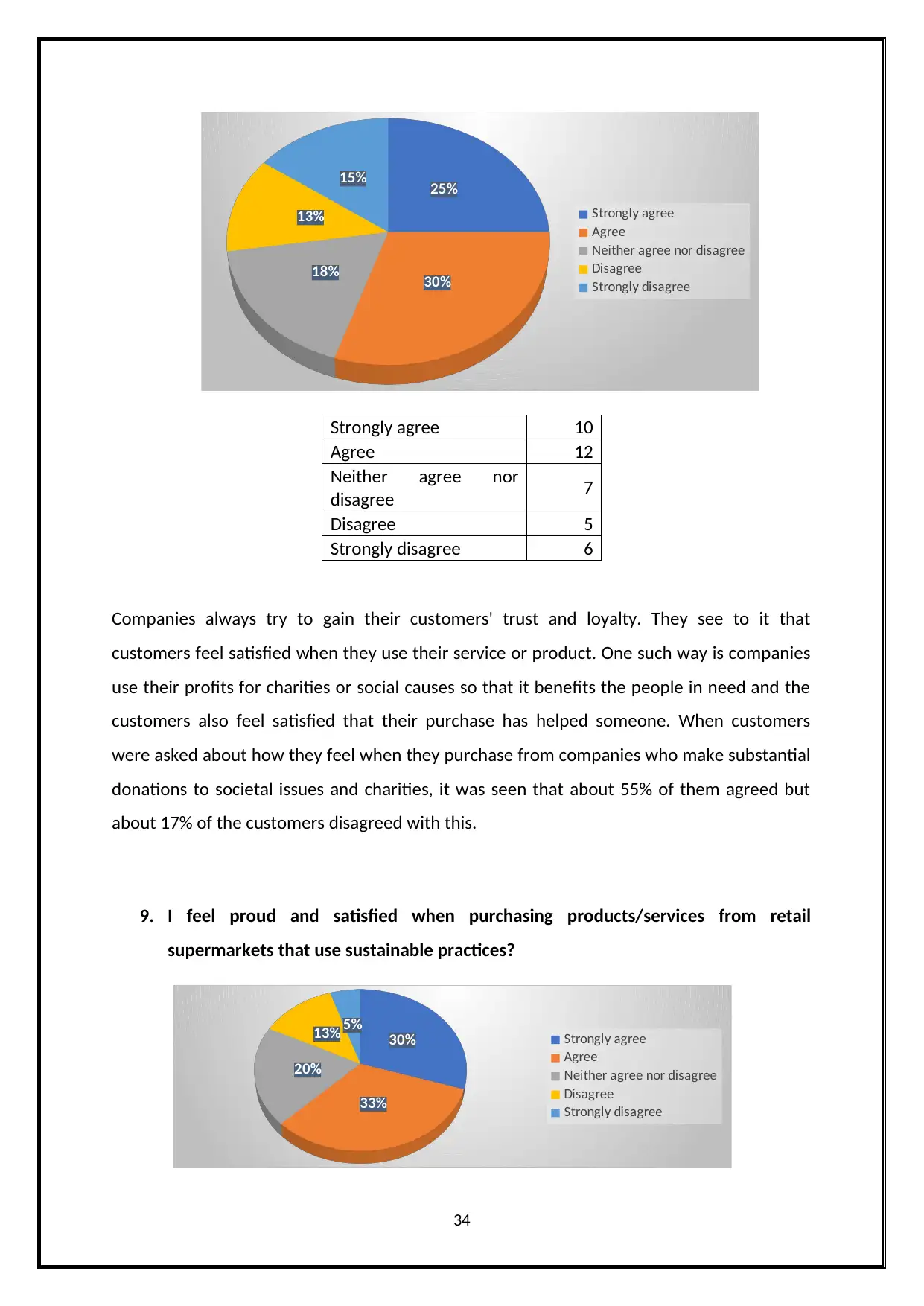
25%
30%
18%
13%
15%
Strongly agree
Agree
Neither agree nor disagree
Disagree
Strongly disagree
Strongly agree 10
Agree 12
Neither agree nor
disagree 7
Disagree 5
Strongly disagree 6
Companies always try to gain their customers' trust and loyalty. They see to it that
customers feel satisfied when they use their service or product. One such way is companies
use their profits for charities or social causes so that it benefits the people in need and the
customers also feel satisfied that their purchase has helped someone. When customers
were asked about how they feel when they purchase from companies who make substantial
donations to societal issues and charities, it was seen that about 55% of them agreed but
about 17% of the customers disagreed with this.
9. I feel proud and satisfied when purchasing products/services from retail
supermarkets that use sustainable practices?
30%
33%
20%
13% 5% Strongly agree
Agree
Neither agree nor disagree
Disagree
Strongly disagree
34
30%
18%
13%
15%
Strongly agree
Agree
Neither agree nor disagree
Disagree
Strongly disagree
Strongly agree 10
Agree 12
Neither agree nor
disagree 7
Disagree 5
Strongly disagree 6
Companies always try to gain their customers' trust and loyalty. They see to it that
customers feel satisfied when they use their service or product. One such way is companies
use their profits for charities or social causes so that it benefits the people in need and the
customers also feel satisfied that their purchase has helped someone. When customers
were asked about how they feel when they purchase from companies who make substantial
donations to societal issues and charities, it was seen that about 55% of them agreed but
about 17% of the customers disagreed with this.
9. I feel proud and satisfied when purchasing products/services from retail
supermarkets that use sustainable practices?
30%
33%
20%
13% 5% Strongly agree
Agree
Neither agree nor disagree
Disagree
Strongly disagree
34
Secure Best Marks with AI Grader
Need help grading? Try our AI Grader for instant feedback on your assignments.
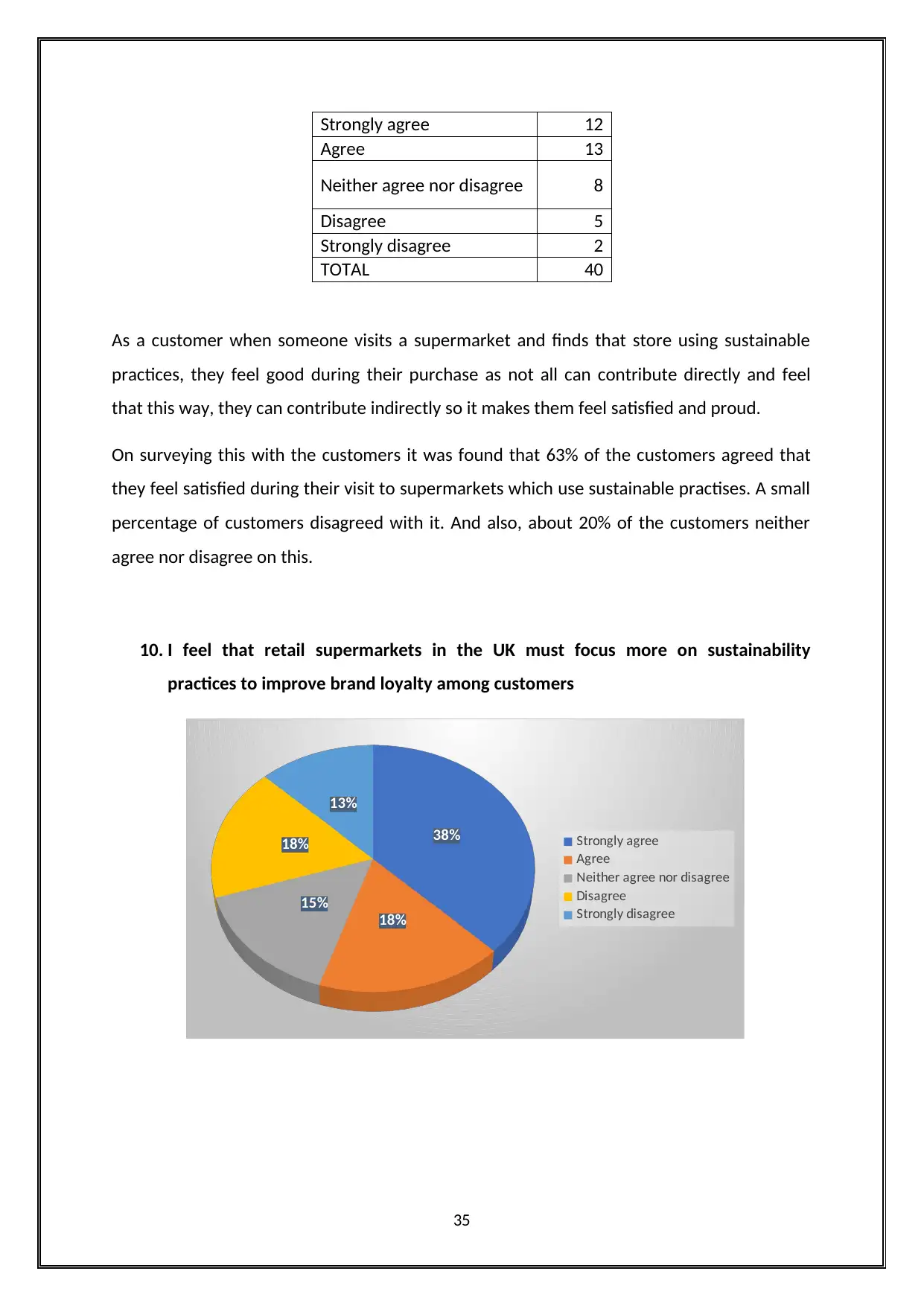
Strongly agree 12
Agree 13
Neither agree nor disagree 8
Disagree 5
Strongly disagree 2
TOTAL 40
As a customer when someone visits a supermarket and finds that store using sustainable
practices, they feel good during their purchase as not all can contribute directly and feel
that this way, they can contribute indirectly so it makes them feel satisfied and proud.
On surveying this with the customers it was found that 63% of the customers agreed that
they feel satisfied during their visit to supermarkets which use sustainable practises. A small
percentage of customers disagreed with it. And also, about 20% of the customers neither
agree nor disagree on this.
10. I feel that retail supermarkets in the UK must focus more on sustainability
practices to improve brand loyalty among customers
38%
18%
15%
18%
13%
Strongly agree
Agree
Neither agree nor disagree
Disagree
Strongly disagree
35
Agree 13
Neither agree nor disagree 8
Disagree 5
Strongly disagree 2
TOTAL 40
As a customer when someone visits a supermarket and finds that store using sustainable
practices, they feel good during their purchase as not all can contribute directly and feel
that this way, they can contribute indirectly so it makes them feel satisfied and proud.
On surveying this with the customers it was found that 63% of the customers agreed that
they feel satisfied during their visit to supermarkets which use sustainable practises. A small
percentage of customers disagreed with it. And also, about 20% of the customers neither
agree nor disagree on this.
10. I feel that retail supermarkets in the UK must focus more on sustainability
practices to improve brand loyalty among customers
38%
18%
15%
18%
13%
Strongly agree
Agree
Neither agree nor disagree
Disagree
Strongly disagree
35
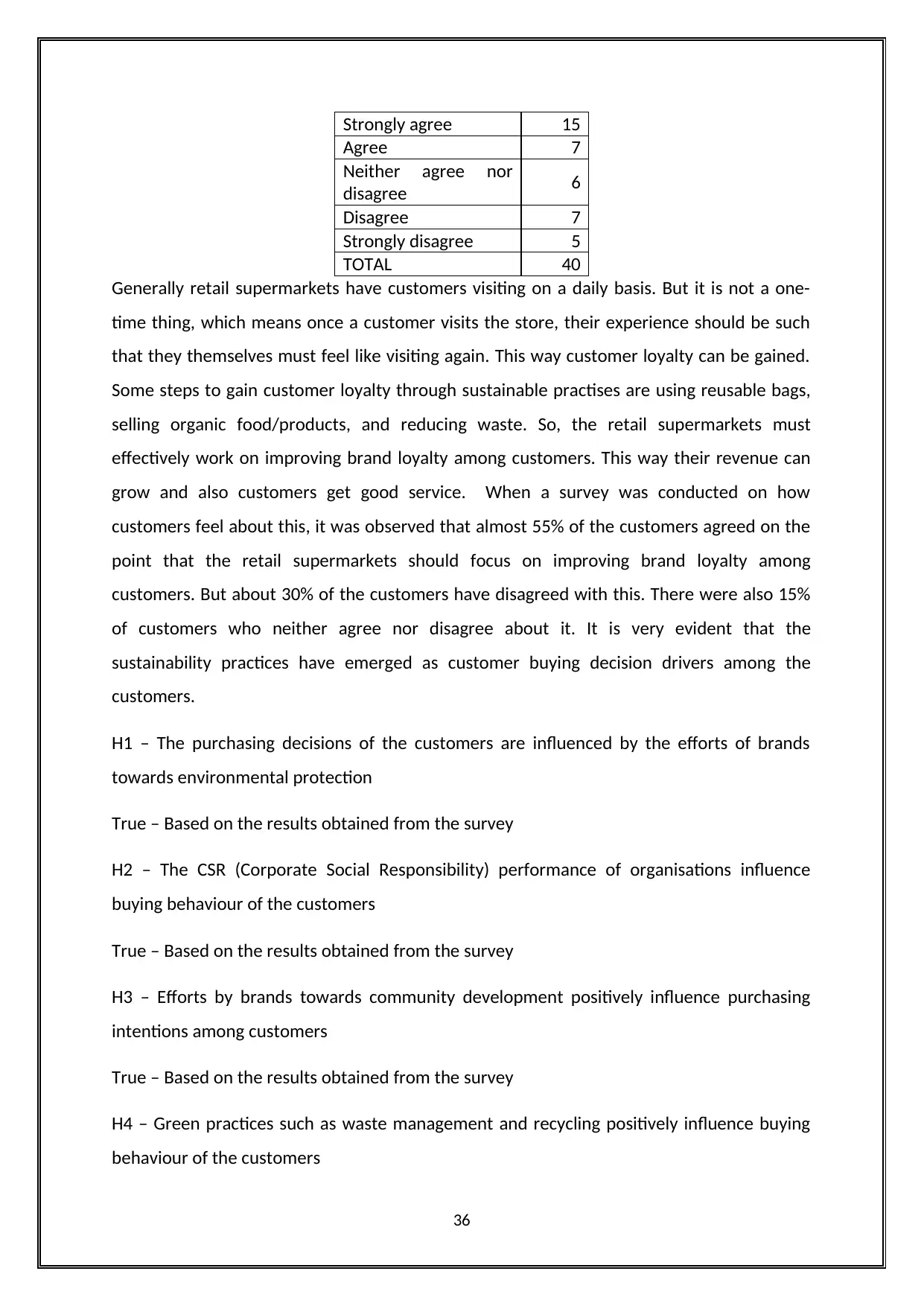
Strongly agree 15
Agree 7
Neither agree nor
disagree 6
Disagree 7
Strongly disagree 5
TOTAL 40
Generally retail supermarkets have customers visiting on a daily basis. But it is not a one-
time thing, which means once a customer visits the store, their experience should be such
that they themselves must feel like visiting again. This way customer loyalty can be gained.
Some steps to gain customer loyalty through sustainable practises are using reusable bags,
selling organic food/products, and reducing waste. So, the retail supermarkets must
effectively work on improving brand loyalty among customers. This way their revenue can
grow and also customers get good service. When a survey was conducted on how
customers feel about this, it was observed that almost 55% of the customers agreed on the
point that the retail supermarkets should focus on improving brand loyalty among
customers. But about 30% of the customers have disagreed with this. There were also 15%
of customers who neither agree nor disagree about it. It is very evident that the
sustainability practices have emerged as customer buying decision drivers among the
customers.
H1 – The purchasing decisions of the customers are influenced by the efforts of brands
towards environmental protection
True – Based on the results obtained from the survey
H2 – The CSR (Corporate Social Responsibility) performance of organisations influence
buying behaviour of the customers
True – Based on the results obtained from the survey
H3 – Efforts by brands towards community development positively influence purchasing
intentions among customers
True – Based on the results obtained from the survey
H4 – Green practices such as waste management and recycling positively influence buying
behaviour of the customers
36
Agree 7
Neither agree nor
disagree 6
Disagree 7
Strongly disagree 5
TOTAL 40
Generally retail supermarkets have customers visiting on a daily basis. But it is not a one-
time thing, which means once a customer visits the store, their experience should be such
that they themselves must feel like visiting again. This way customer loyalty can be gained.
Some steps to gain customer loyalty through sustainable practises are using reusable bags,
selling organic food/products, and reducing waste. So, the retail supermarkets must
effectively work on improving brand loyalty among customers. This way their revenue can
grow and also customers get good service. When a survey was conducted on how
customers feel about this, it was observed that almost 55% of the customers agreed on the
point that the retail supermarkets should focus on improving brand loyalty among
customers. But about 30% of the customers have disagreed with this. There were also 15%
of customers who neither agree nor disagree about it. It is very evident that the
sustainability practices have emerged as customer buying decision drivers among the
customers.
H1 – The purchasing decisions of the customers are influenced by the efforts of brands
towards environmental protection
True – Based on the results obtained from the survey
H2 – The CSR (Corporate Social Responsibility) performance of organisations influence
buying behaviour of the customers
True – Based on the results obtained from the survey
H3 – Efforts by brands towards community development positively influence purchasing
intentions among customers
True – Based on the results obtained from the survey
H4 – Green practices such as waste management and recycling positively influence buying
behaviour of the customers
36
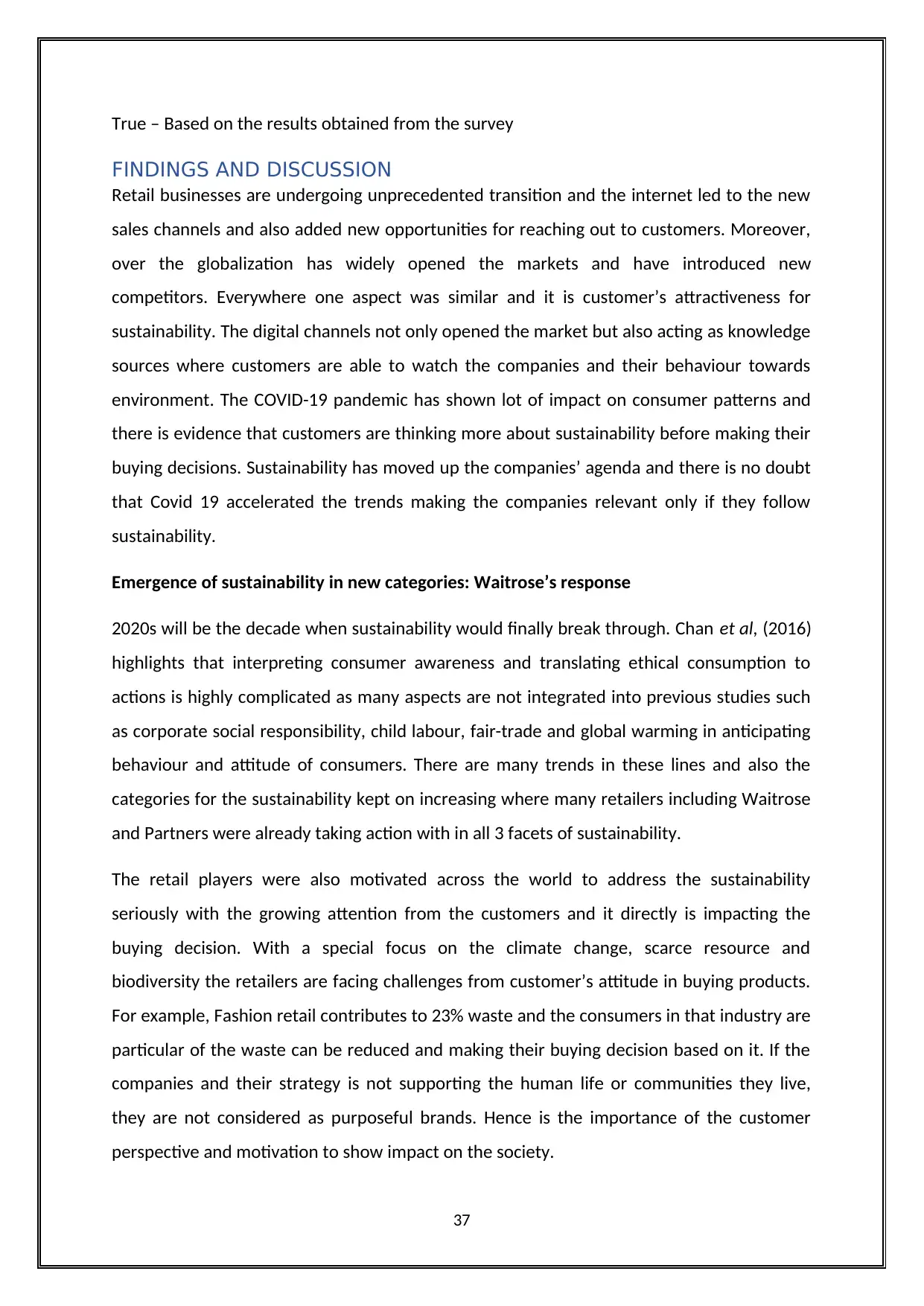
True – Based on the results obtained from the survey
FINDINGS AND DISCUSSION
Retail businesses are undergoing unprecedented transition and the internet led to the new
sales channels and also added new opportunities for reaching out to customers. Moreover,
over the globalization has widely opened the markets and have introduced new
competitors. Everywhere one aspect was similar and it is customer’s attractiveness for
sustainability. The digital channels not only opened the market but also acting as knowledge
sources where customers are able to watch the companies and their behaviour towards
environment. The COVID-19 pandemic has shown lot of impact on consumer patterns and
there is evidence that customers are thinking more about sustainability before making their
buying decisions. Sustainability has moved up the companies’ agenda and there is no doubt
that Covid 19 accelerated the trends making the companies relevant only if they follow
sustainability.
Emergence of sustainability in new categories: Waitrose’s response
2020s will be the decade when sustainability would finally break through. Chan et al, (2016)
highlights that interpreting consumer awareness and translating ethical consumption to
actions is highly complicated as many aspects are not integrated into previous studies such
as corporate social responsibility, child labour, fair-trade and global warming in anticipating
behaviour and attitude of consumers. There are many trends in these lines and also the
categories for the sustainability kept on increasing where many retailers including Waitrose
and Partners were already taking action with in all 3 facets of sustainability.
The retail players were also motivated across the world to address the sustainability
seriously with the growing attention from the customers and it directly is impacting the
buying decision. With a special focus on the climate change, scarce resource and
biodiversity the retailers are facing challenges from customer’s attitude in buying products.
For example, Fashion retail contributes to 23% waste and the consumers in that industry are
particular of the waste can be reduced and making their buying decision based on it. If the
companies and their strategy is not supporting the human life or communities they live,
they are not considered as purposeful brands. Hence is the importance of the customer
perspective and motivation to show impact on the society.
37
FINDINGS AND DISCUSSION
Retail businesses are undergoing unprecedented transition and the internet led to the new
sales channels and also added new opportunities for reaching out to customers. Moreover,
over the globalization has widely opened the markets and have introduced new
competitors. Everywhere one aspect was similar and it is customer’s attractiveness for
sustainability. The digital channels not only opened the market but also acting as knowledge
sources where customers are able to watch the companies and their behaviour towards
environment. The COVID-19 pandemic has shown lot of impact on consumer patterns and
there is evidence that customers are thinking more about sustainability before making their
buying decisions. Sustainability has moved up the companies’ agenda and there is no doubt
that Covid 19 accelerated the trends making the companies relevant only if they follow
sustainability.
Emergence of sustainability in new categories: Waitrose’s response
2020s will be the decade when sustainability would finally break through. Chan et al, (2016)
highlights that interpreting consumer awareness and translating ethical consumption to
actions is highly complicated as many aspects are not integrated into previous studies such
as corporate social responsibility, child labour, fair-trade and global warming in anticipating
behaviour and attitude of consumers. There are many trends in these lines and also the
categories for the sustainability kept on increasing where many retailers including Waitrose
and Partners were already taking action with in all 3 facets of sustainability.
The retail players were also motivated across the world to address the sustainability
seriously with the growing attention from the customers and it directly is impacting the
buying decision. With a special focus on the climate change, scarce resource and
biodiversity the retailers are facing challenges from customer’s attitude in buying products.
For example, Fashion retail contributes to 23% waste and the consumers in that industry are
particular of the waste can be reduced and making their buying decision based on it. If the
companies and their strategy is not supporting the human life or communities they live,
they are not considered as purposeful brands. Hence is the importance of the customer
perspective and motivation to show impact on the society.
37
Paraphrase This Document
Need a fresh take? Get an instant paraphrase of this document with our AI Paraphraser
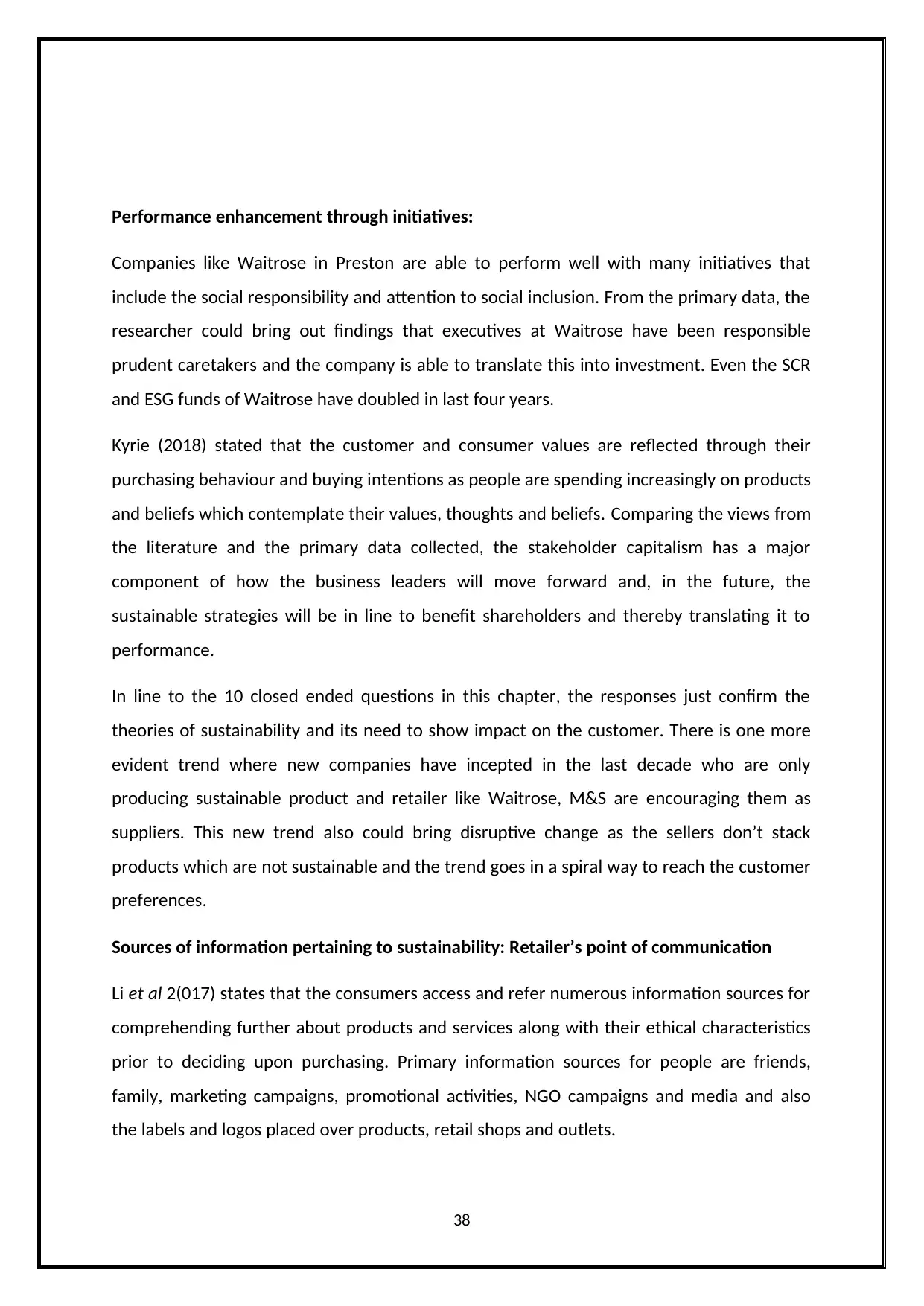
Performance enhancement through initiatives:
Companies like Waitrose in Preston are able to perform well with many initiatives that
include the social responsibility and attention to social inclusion. From the primary data, the
researcher could bring out findings that executives at Waitrose have been responsible
prudent caretakers and the company is able to translate this into investment. Even the SCR
and ESG funds of Waitrose have doubled in last four years.
Kyrie (2018) stated that the customer and consumer values are reflected through their
purchasing behaviour and buying intentions as people are spending increasingly on products
and beliefs which contemplate their values, thoughts and beliefs. Comparing the views from
the literature and the primary data collected, the stakeholder capitalism has a major
component of how the business leaders will move forward and, in the future, the
sustainable strategies will be in line to benefit shareholders and thereby translating it to
performance.
In line to the 10 closed ended questions in this chapter, the responses just confirm the
theories of sustainability and its need to show impact on the customer. There is one more
evident trend where new companies have incepted in the last decade who are only
producing sustainable product and retailer like Waitrose, M&S are encouraging them as
suppliers. This new trend also could bring disruptive change as the sellers don’t stack
products which are not sustainable and the trend goes in a spiral way to reach the customer
preferences.
Sources of information pertaining to sustainability: Retailer’s point of communication
Li et al 2(017) states that the consumers access and refer numerous information sources for
comprehending further about products and services along with their ethical characteristics
prior to deciding upon purchasing. Primary information sources for people are friends,
family, marketing campaigns, promotional activities, NGO campaigns and media and also
the labels and logos placed over products, retail shops and outlets.
38
Companies like Waitrose in Preston are able to perform well with many initiatives that
include the social responsibility and attention to social inclusion. From the primary data, the
researcher could bring out findings that executives at Waitrose have been responsible
prudent caretakers and the company is able to translate this into investment. Even the SCR
and ESG funds of Waitrose have doubled in last four years.
Kyrie (2018) stated that the customer and consumer values are reflected through their
purchasing behaviour and buying intentions as people are spending increasingly on products
and beliefs which contemplate their values, thoughts and beliefs. Comparing the views from
the literature and the primary data collected, the stakeholder capitalism has a major
component of how the business leaders will move forward and, in the future, the
sustainable strategies will be in line to benefit shareholders and thereby translating it to
performance.
In line to the 10 closed ended questions in this chapter, the responses just confirm the
theories of sustainability and its need to show impact on the customer. There is one more
evident trend where new companies have incepted in the last decade who are only
producing sustainable product and retailer like Waitrose, M&S are encouraging them as
suppliers. This new trend also could bring disruptive change as the sellers don’t stack
products which are not sustainable and the trend goes in a spiral way to reach the customer
preferences.
Sources of information pertaining to sustainability: Retailer’s point of communication
Li et al 2(017) states that the consumers access and refer numerous information sources for
comprehending further about products and services along with their ethical characteristics
prior to deciding upon purchasing. Primary information sources for people are friends,
family, marketing campaigns, promotional activities, NGO campaigns and media and also
the labels and logos placed over products, retail shops and outlets.
38
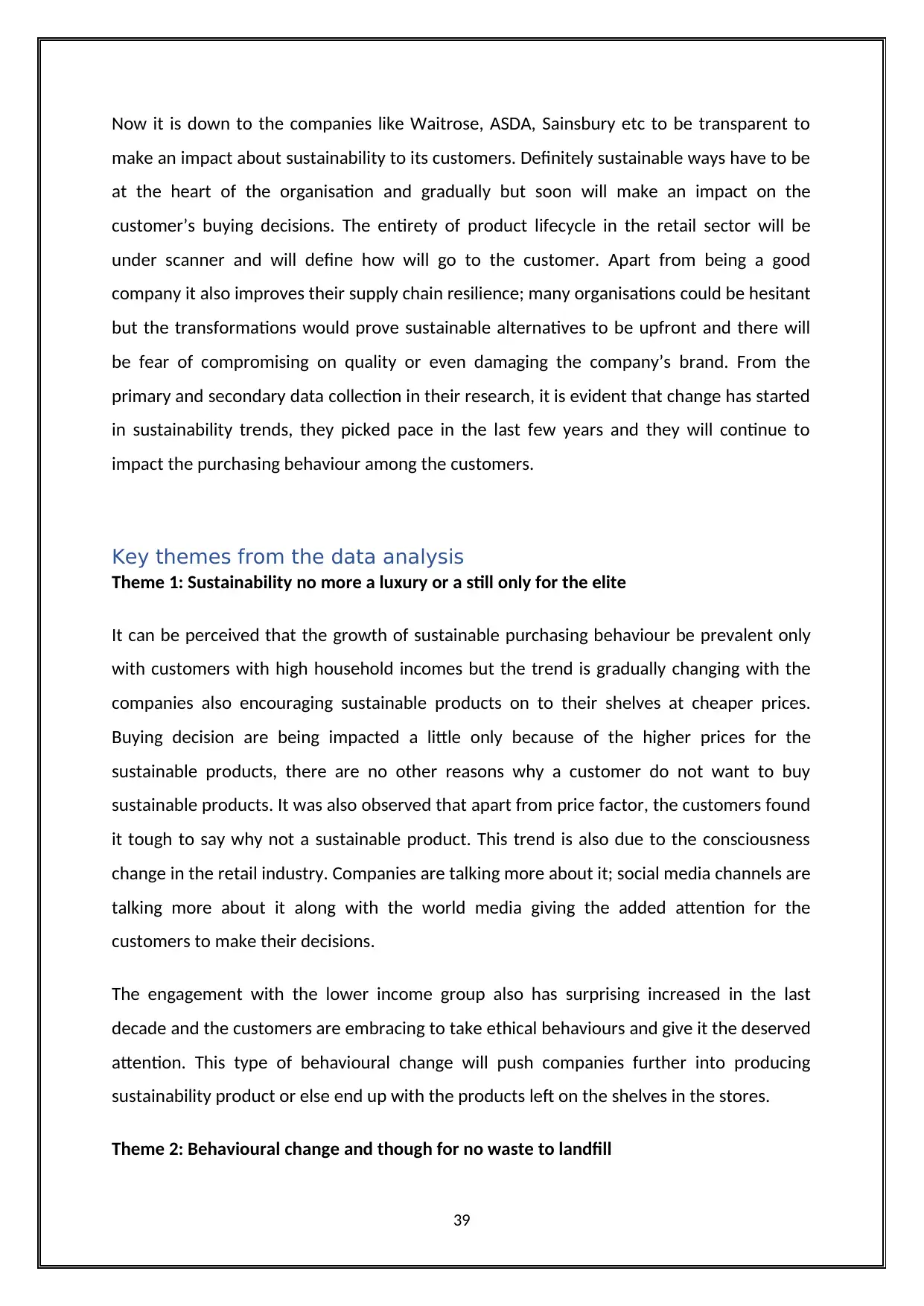
Now it is down to the companies like Waitrose, ASDA, Sainsbury etc to be transparent to
make an impact about sustainability to its customers. Definitely sustainable ways have to be
at the heart of the organisation and gradually but soon will make an impact on the
customer’s buying decisions. The entirety of product lifecycle in the retail sector will be
under scanner and will define how will go to the customer. Apart from being a good
company it also improves their supply chain resilience; many organisations could be hesitant
but the transformations would prove sustainable alternatives to be upfront and there will
be fear of compromising on quality or even damaging the company’s brand. From the
primary and secondary data collection in their research, it is evident that change has started
in sustainability trends, they picked pace in the last few years and they will continue to
impact the purchasing behaviour among the customers.
Key themes from the data analysis
Theme 1: Sustainability no more a luxury or a still only for the elite
It can be perceived that the growth of sustainable purchasing behaviour be prevalent only
with customers with high household incomes but the trend is gradually changing with the
companies also encouraging sustainable products on to their shelves at cheaper prices.
Buying decision are being impacted a little only because of the higher prices for the
sustainable products, there are no other reasons why a customer do not want to buy
sustainable products. It was also observed that apart from price factor, the customers found
it tough to say why not a sustainable product. This trend is also due to the consciousness
change in the retail industry. Companies are talking more about it; social media channels are
talking more about it along with the world media giving the added attention for the
customers to make their decisions.
The engagement with the lower income group also has surprising increased in the last
decade and the customers are embracing to take ethical behaviours and give it the deserved
attention. This type of behavioural change will push companies further into producing
sustainability product or else end up with the products left on the shelves in the stores.
Theme 2: Behavioural change and though for no waste to landfill
39
make an impact about sustainability to its customers. Definitely sustainable ways have to be
at the heart of the organisation and gradually but soon will make an impact on the
customer’s buying decisions. The entirety of product lifecycle in the retail sector will be
under scanner and will define how will go to the customer. Apart from being a good
company it also improves their supply chain resilience; many organisations could be hesitant
but the transformations would prove sustainable alternatives to be upfront and there will
be fear of compromising on quality or even damaging the company’s brand. From the
primary and secondary data collection in their research, it is evident that change has started
in sustainability trends, they picked pace in the last few years and they will continue to
impact the purchasing behaviour among the customers.
Key themes from the data analysis
Theme 1: Sustainability no more a luxury or a still only for the elite
It can be perceived that the growth of sustainable purchasing behaviour be prevalent only
with customers with high household incomes but the trend is gradually changing with the
companies also encouraging sustainable products on to their shelves at cheaper prices.
Buying decision are being impacted a little only because of the higher prices for the
sustainable products, there are no other reasons why a customer do not want to buy
sustainable products. It was also observed that apart from price factor, the customers found
it tough to say why not a sustainable product. This trend is also due to the consciousness
change in the retail industry. Companies are talking more about it; social media channels are
talking more about it along with the world media giving the added attention for the
customers to make their decisions.
The engagement with the lower income group also has surprising increased in the last
decade and the customers are embracing to take ethical behaviours and give it the deserved
attention. This type of behavioural change will push companies further into producing
sustainability product or else end up with the products left on the shelves in the stores.
Theme 2: Behavioural change and though for no waste to landfill
39
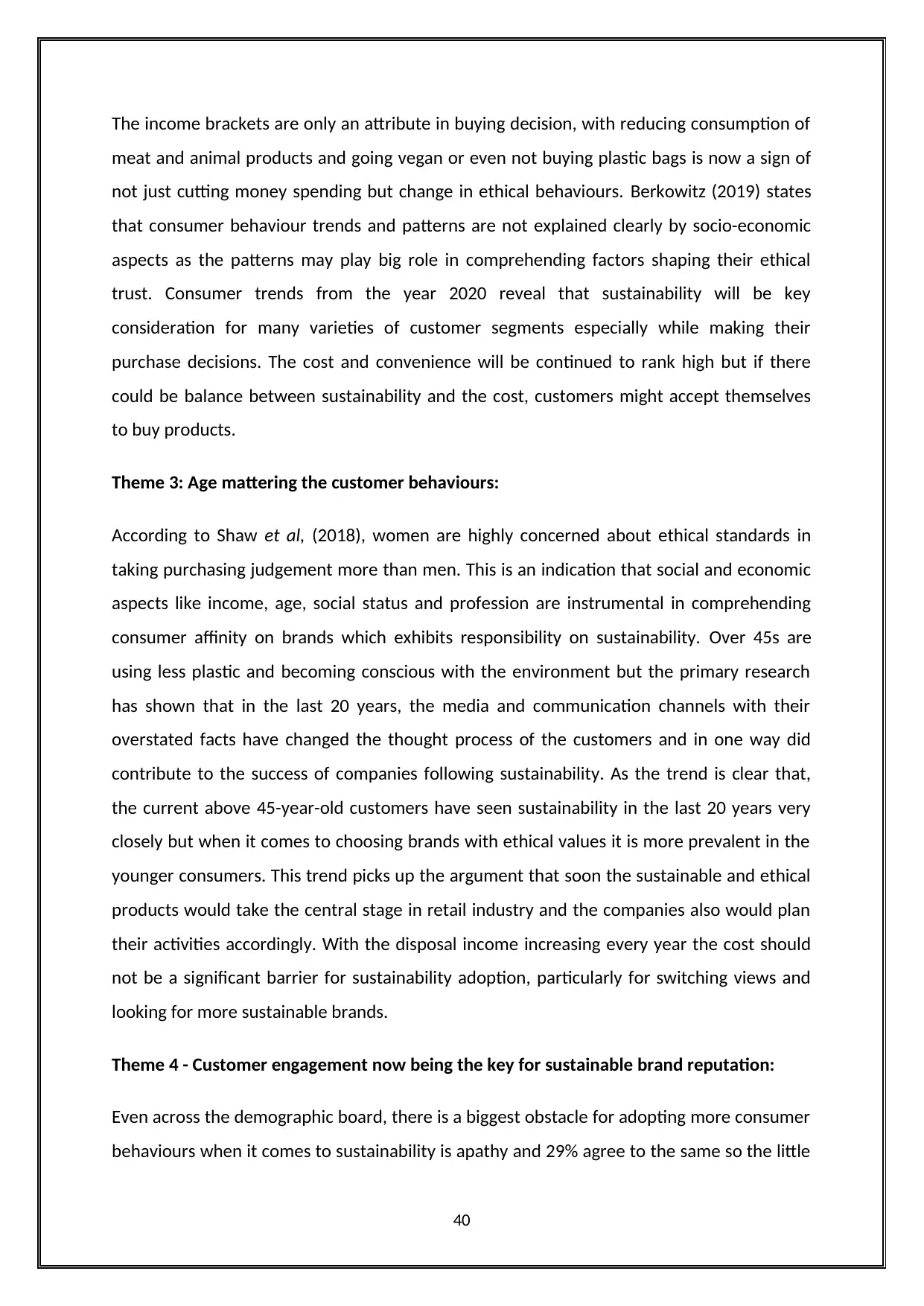
The income brackets are only an attribute in buying decision, with reducing consumption of
meat and animal products and going vegan or even not buying plastic bags is now a sign of
not just cutting money spending but change in ethical behaviours. Berkowitz (2019) states
that consumer behaviour trends and patterns are not explained clearly by socio-economic
aspects as the patterns may play big role in comprehending factors shaping their ethical
trust. Consumer trends from the year 2020 reveal that sustainability will be key
consideration for many varieties of customer segments especially while making their
purchase decisions. The cost and convenience will be continued to rank high but if there
could be balance between sustainability and the cost, customers might accept themselves
to buy products.
Theme 3: Age mattering the customer behaviours:
According to Shaw et al, (2018), women are highly concerned about ethical standards in
taking purchasing judgement more than men. This is an indication that social and economic
aspects like income, age, social status and profession are instrumental in comprehending
consumer affinity on brands which exhibits responsibility on sustainability. Over 45s are
using less plastic and becoming conscious with the environment but the primary research
has shown that in the last 20 years, the media and communication channels with their
overstated facts have changed the thought process of the customers and in one way did
contribute to the success of companies following sustainability. As the trend is clear that,
the current above 45-year-old customers have seen sustainability in the last 20 years very
closely but when it comes to choosing brands with ethical values it is more prevalent in the
younger consumers. This trend picks up the argument that soon the sustainable and ethical
products would take the central stage in retail industry and the companies also would plan
their activities accordingly. With the disposal income increasing every year the cost should
not be a significant barrier for sustainability adoption, particularly for switching views and
looking for more sustainable brands.
Theme 4 - Customer engagement now being the key for sustainable brand reputation:
Even across the demographic board, there is a biggest obstacle for adopting more consumer
behaviours when it comes to sustainability is apathy and 29% agree to the same so the little
40
meat and animal products and going vegan or even not buying plastic bags is now a sign of
not just cutting money spending but change in ethical behaviours. Berkowitz (2019) states
that consumer behaviour trends and patterns are not explained clearly by socio-economic
aspects as the patterns may play big role in comprehending factors shaping their ethical
trust. Consumer trends from the year 2020 reveal that sustainability will be key
consideration for many varieties of customer segments especially while making their
purchase decisions. The cost and convenience will be continued to rank high but if there
could be balance between sustainability and the cost, customers might accept themselves
to buy products.
Theme 3: Age mattering the customer behaviours:
According to Shaw et al, (2018), women are highly concerned about ethical standards in
taking purchasing judgement more than men. This is an indication that social and economic
aspects like income, age, social status and profession are instrumental in comprehending
consumer affinity on brands which exhibits responsibility on sustainability. Over 45s are
using less plastic and becoming conscious with the environment but the primary research
has shown that in the last 20 years, the media and communication channels with their
overstated facts have changed the thought process of the customers and in one way did
contribute to the success of companies following sustainability. As the trend is clear that,
the current above 45-year-old customers have seen sustainability in the last 20 years very
closely but when it comes to choosing brands with ethical values it is more prevalent in the
younger consumers. This trend picks up the argument that soon the sustainable and ethical
products would take the central stage in retail industry and the companies also would plan
their activities accordingly. With the disposal income increasing every year the cost should
not be a significant barrier for sustainability adoption, particularly for switching views and
looking for more sustainable brands.
Theme 4 - Customer engagement now being the key for sustainable brand reputation:
Even across the demographic board, there is a biggest obstacle for adopting more consumer
behaviours when it comes to sustainability is apathy and 29% agree to the same so the little
40
Secure Best Marks with AI Grader
Need help grading? Try our AI Grader for instant feedback on your assignments.
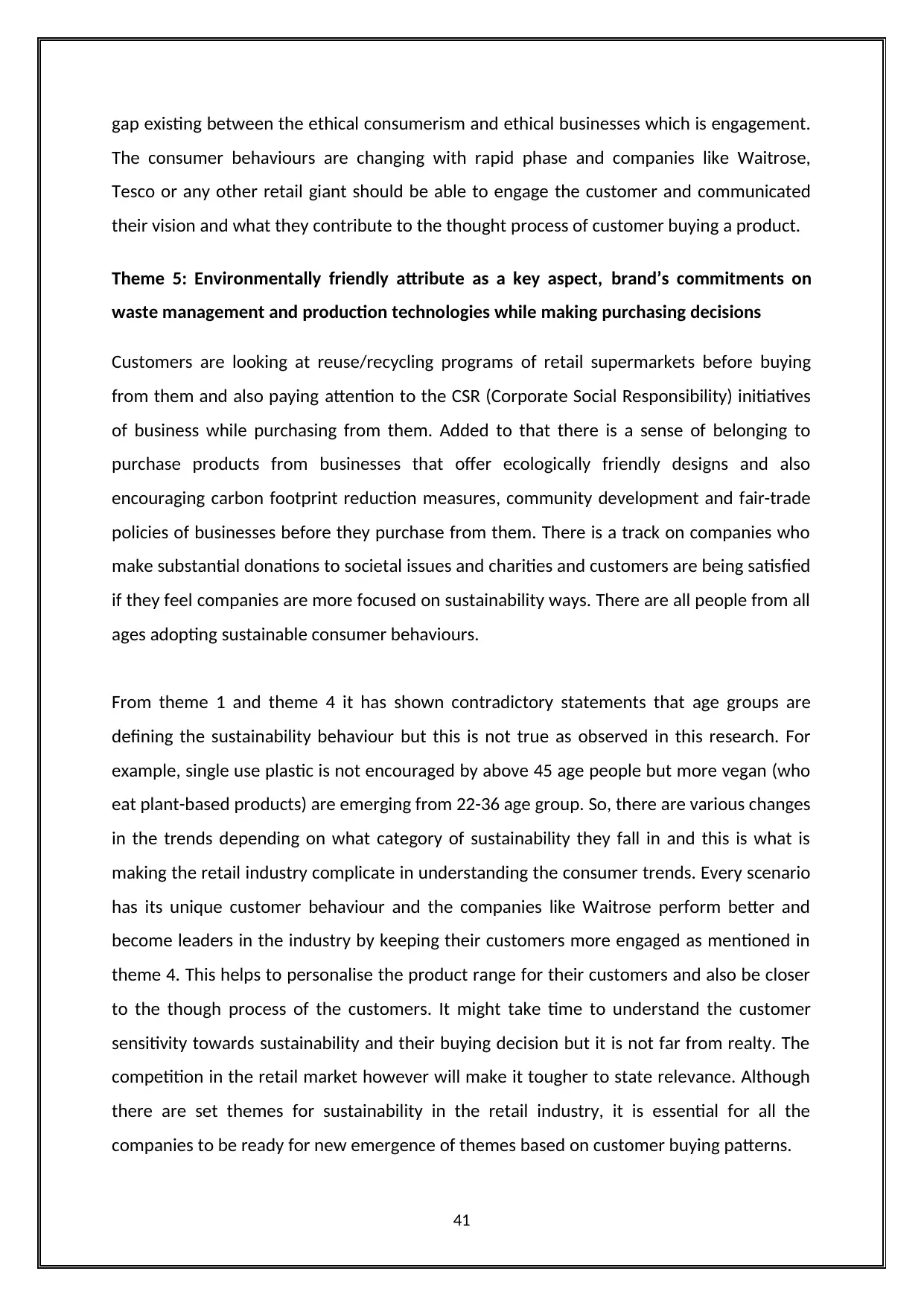
gap existing between the ethical consumerism and ethical businesses which is engagement.
The consumer behaviours are changing with rapid phase and companies like Waitrose,
Tesco or any other retail giant should be able to engage the customer and communicated
their vision and what they contribute to the thought process of customer buying a product.
Theme 5: Environmentally friendly attribute as a key aspect, brand’s commitments on
waste management and production technologies while making purchasing decisions
Customers are looking at reuse/recycling programs of retail supermarkets before buying
from them and also paying attention to the CSR (Corporate Social Responsibility) initiatives
of business while purchasing from them. Added to that there is a sense of belonging to
purchase products from businesses that offer ecologically friendly designs and also
encouraging carbon footprint reduction measures, community development and fair-trade
policies of businesses before they purchase from them. There is a track on companies who
make substantial donations to societal issues and charities and customers are being satisfied
if they feel companies are more focused on sustainability ways. There are all people from all
ages adopting sustainable consumer behaviours.
From theme 1 and theme 4 it has shown contradictory statements that age groups are
defining the sustainability behaviour but this is not true as observed in this research. For
example, single use plastic is not encouraged by above 45 age people but more vegan (who
eat plant-based products) are emerging from 22-36 age group. So, there are various changes
in the trends depending on what category of sustainability they fall in and this is what is
making the retail industry complicate in understanding the consumer trends. Every scenario
has its unique customer behaviour and the companies like Waitrose perform better and
become leaders in the industry by keeping their customers more engaged as mentioned in
theme 4. This helps to personalise the product range for their customers and also be closer
to the though process of the customers. It might take time to understand the customer
sensitivity towards sustainability and their buying decision but it is not far from realty. The
competition in the retail market however will make it tougher to state relevance. Although
there are set themes for sustainability in the retail industry, it is essential for all the
companies to be ready for new emergence of themes based on customer buying patterns.
41
The consumer behaviours are changing with rapid phase and companies like Waitrose,
Tesco or any other retail giant should be able to engage the customer and communicated
their vision and what they contribute to the thought process of customer buying a product.
Theme 5: Environmentally friendly attribute as a key aspect, brand’s commitments on
waste management and production technologies while making purchasing decisions
Customers are looking at reuse/recycling programs of retail supermarkets before buying
from them and also paying attention to the CSR (Corporate Social Responsibility) initiatives
of business while purchasing from them. Added to that there is a sense of belonging to
purchase products from businesses that offer ecologically friendly designs and also
encouraging carbon footprint reduction measures, community development and fair-trade
policies of businesses before they purchase from them. There is a track on companies who
make substantial donations to societal issues and charities and customers are being satisfied
if they feel companies are more focused on sustainability ways. There are all people from all
ages adopting sustainable consumer behaviours.
From theme 1 and theme 4 it has shown contradictory statements that age groups are
defining the sustainability behaviour but this is not true as observed in this research. For
example, single use plastic is not encouraged by above 45 age people but more vegan (who
eat plant-based products) are emerging from 22-36 age group. So, there are various changes
in the trends depending on what category of sustainability they fall in and this is what is
making the retail industry complicate in understanding the consumer trends. Every scenario
has its unique customer behaviour and the companies like Waitrose perform better and
become leaders in the industry by keeping their customers more engaged as mentioned in
theme 4. This helps to personalise the product range for their customers and also be closer
to the though process of the customers. It might take time to understand the customer
sensitivity towards sustainability and their buying decision but it is not far from realty. The
competition in the retail market however will make it tougher to state relevance. Although
there are set themes for sustainability in the retail industry, it is essential for all the
companies to be ready for new emergence of themes based on customer buying patterns.
41
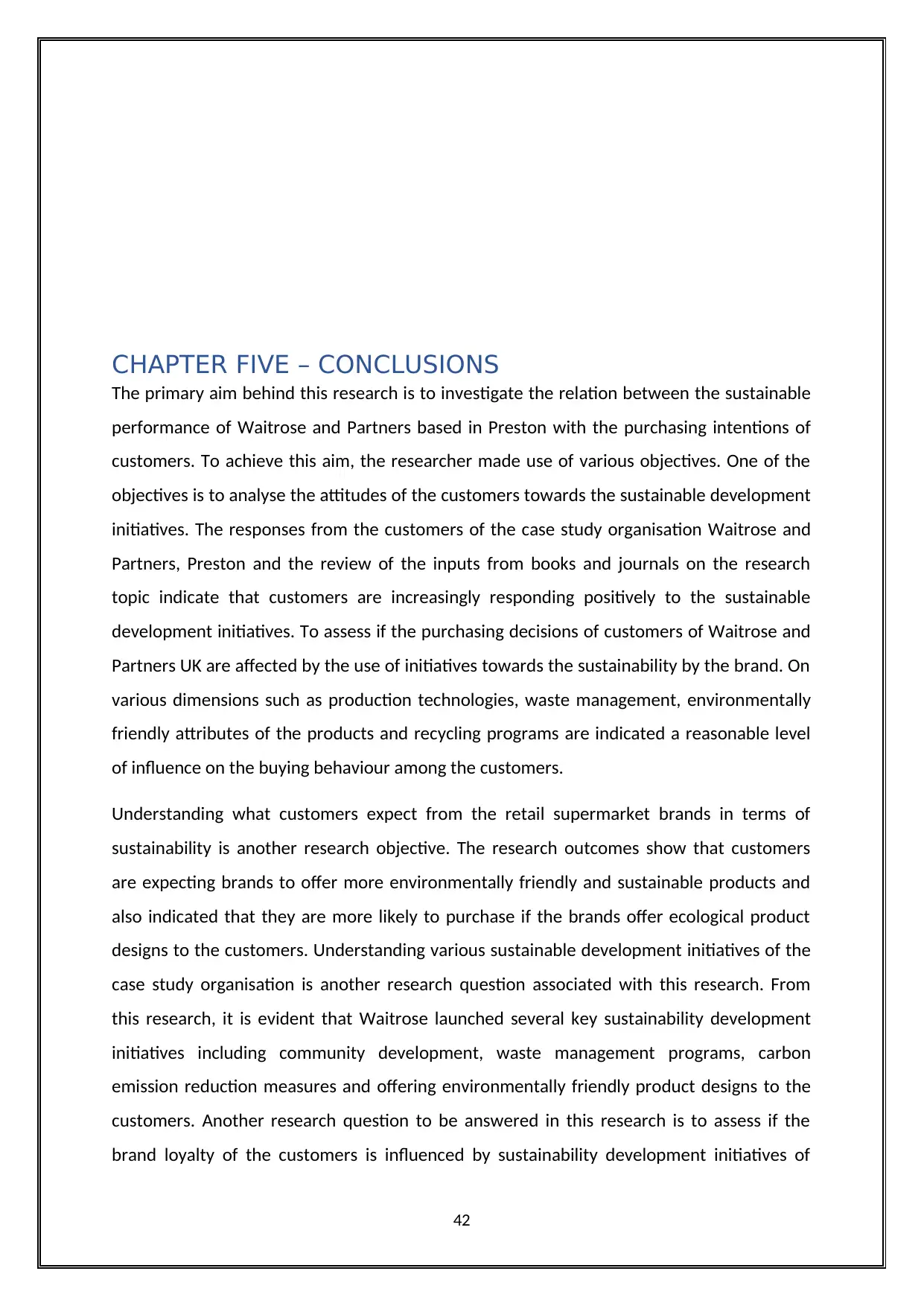
CHAPTER FIVE – CONCLUSIONS
The primary aim behind this research is to investigate the relation between the sustainable
performance of Waitrose and Partners based in Preston with the purchasing intentions of
customers. To achieve this aim, the researcher made use of various objectives. One of the
objectives is to analyse the attitudes of the customers towards the sustainable development
initiatives. The responses from the customers of the case study organisation Waitrose and
Partners, Preston and the review of the inputs from books and journals on the research
topic indicate that customers are increasingly responding positively to the sustainable
development initiatives. To assess if the purchasing decisions of customers of Waitrose and
Partners UK are affected by the use of initiatives towards the sustainability by the brand. On
various dimensions such as production technologies, waste management, environmentally
friendly attributes of the products and recycling programs are indicated a reasonable level
of influence on the buying behaviour among the customers.
Understanding what customers expect from the retail supermarket brands in terms of
sustainability is another research objective. The research outcomes show that customers
are expecting brands to offer more environmentally friendly and sustainable products and
also indicated that they are more likely to purchase if the brands offer ecological product
designs to the customers. Understanding various sustainable development initiatives of the
case study organisation is another research question associated with this research. From
this research, it is evident that Waitrose launched several key sustainability development
initiatives including community development, waste management programs, carbon
emission reduction measures and offering environmentally friendly product designs to the
customers. Another research question to be answered in this research is to assess if the
brand loyalty of the customers is influenced by sustainability development initiatives of
42
The primary aim behind this research is to investigate the relation between the sustainable
performance of Waitrose and Partners based in Preston with the purchasing intentions of
customers. To achieve this aim, the researcher made use of various objectives. One of the
objectives is to analyse the attitudes of the customers towards the sustainable development
initiatives. The responses from the customers of the case study organisation Waitrose and
Partners, Preston and the review of the inputs from books and journals on the research
topic indicate that customers are increasingly responding positively to the sustainable
development initiatives. To assess if the purchasing decisions of customers of Waitrose and
Partners UK are affected by the use of initiatives towards the sustainability by the brand. On
various dimensions such as production technologies, waste management, environmentally
friendly attributes of the products and recycling programs are indicated a reasonable level
of influence on the buying behaviour among the customers.
Understanding what customers expect from the retail supermarket brands in terms of
sustainability is another research objective. The research outcomes show that customers
are expecting brands to offer more environmentally friendly and sustainable products and
also indicated that they are more likely to purchase if the brands offer ecological product
designs to the customers. Understanding various sustainable development initiatives of the
case study organisation is another research question associated with this research. From
this research, it is evident that Waitrose launched several key sustainability development
initiatives including community development, waste management programs, carbon
emission reduction measures and offering environmentally friendly product designs to the
customers. Another research question to be answered in this research is to assess if the
brand loyalty of the customers is influenced by sustainability development initiatives of
42
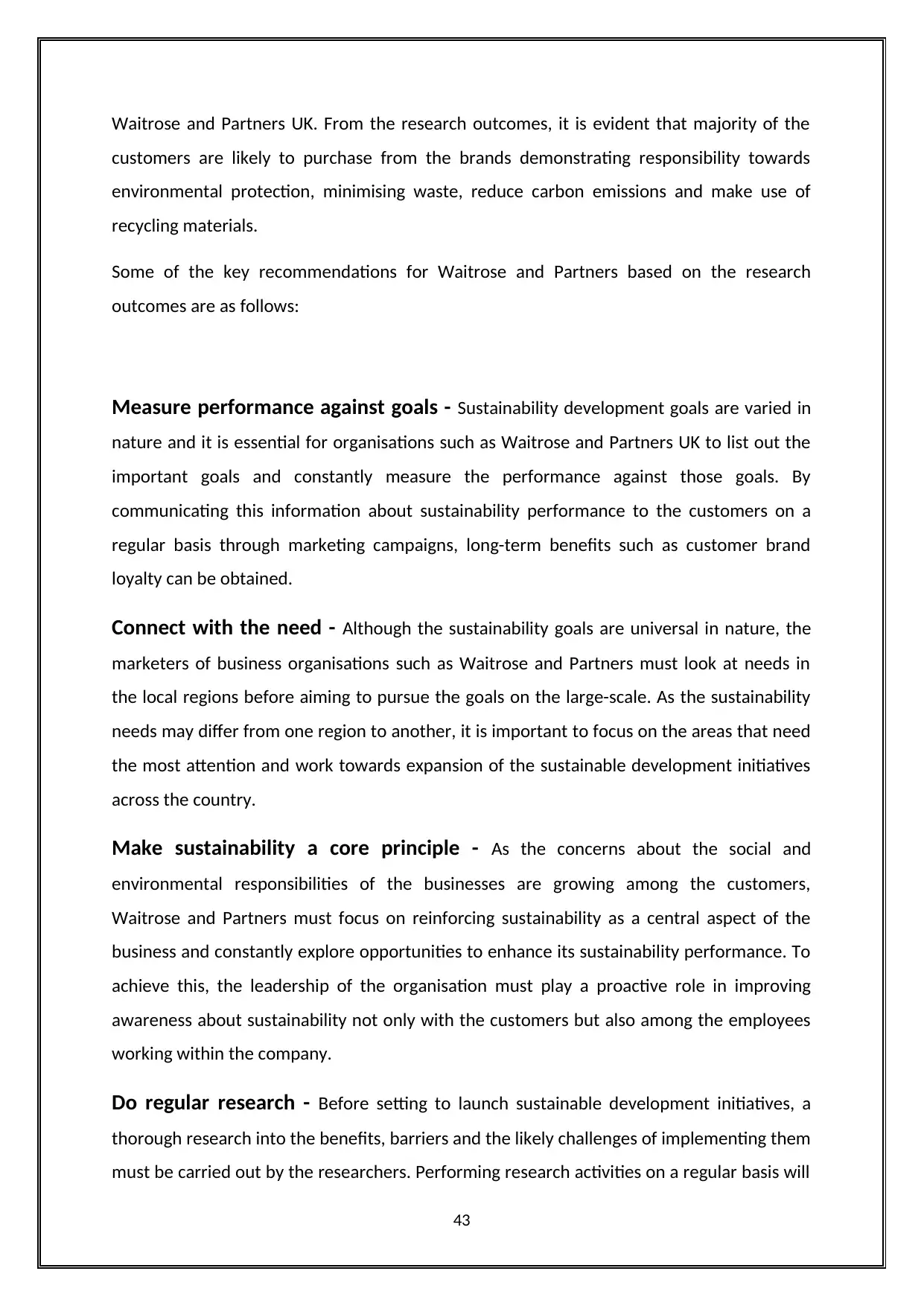
Waitrose and Partners UK. From the research outcomes, it is evident that majority of the
customers are likely to purchase from the brands demonstrating responsibility towards
environmental protection, minimising waste, reduce carbon emissions and make use of
recycling materials.
Some of the key recommendations for Waitrose and Partners based on the research
outcomes are as follows:
Measure performance against goals - Sustainability development goals are varied in
nature and it is essential for organisations such as Waitrose and Partners UK to list out the
important goals and constantly measure the performance against those goals. By
communicating this information about sustainability performance to the customers on a
regular basis through marketing campaigns, long-term benefits such as customer brand
loyalty can be obtained.
Connect with the need - Although the sustainability goals are universal in nature, the
marketers of business organisations such as Waitrose and Partners must look at needs in
the local regions before aiming to pursue the goals on the large-scale. As the sustainability
needs may differ from one region to another, it is important to focus on the areas that need
the most attention and work towards expansion of the sustainable development initiatives
across the country.
Make sustainability a core principle - As the concerns about the social and
environmental responsibilities of the businesses are growing among the customers,
Waitrose and Partners must focus on reinforcing sustainability as a central aspect of the
business and constantly explore opportunities to enhance its sustainability performance. To
achieve this, the leadership of the organisation must play a proactive role in improving
awareness about sustainability not only with the customers but also among the employees
working within the company.
Do regular research - Before setting to launch sustainable development initiatives, a
thorough research into the benefits, barriers and the likely challenges of implementing them
must be carried out by the researchers. Performing research activities on a regular basis will
43
customers are likely to purchase from the brands demonstrating responsibility towards
environmental protection, minimising waste, reduce carbon emissions and make use of
recycling materials.
Some of the key recommendations for Waitrose and Partners based on the research
outcomes are as follows:
Measure performance against goals - Sustainability development goals are varied in
nature and it is essential for organisations such as Waitrose and Partners UK to list out the
important goals and constantly measure the performance against those goals. By
communicating this information about sustainability performance to the customers on a
regular basis through marketing campaigns, long-term benefits such as customer brand
loyalty can be obtained.
Connect with the need - Although the sustainability goals are universal in nature, the
marketers of business organisations such as Waitrose and Partners must look at needs in
the local regions before aiming to pursue the goals on the large-scale. As the sustainability
needs may differ from one region to another, it is important to focus on the areas that need
the most attention and work towards expansion of the sustainable development initiatives
across the country.
Make sustainability a core principle - As the concerns about the social and
environmental responsibilities of the businesses are growing among the customers,
Waitrose and Partners must focus on reinforcing sustainability as a central aspect of the
business and constantly explore opportunities to enhance its sustainability performance. To
achieve this, the leadership of the organisation must play a proactive role in improving
awareness about sustainability not only with the customers but also among the employees
working within the company.
Do regular research - Before setting to launch sustainable development initiatives, a
thorough research into the benefits, barriers and the likely challenges of implementing them
must be carried out by the researchers. Performing research activities on a regular basis will
43
Paraphrase This Document
Need a fresh take? Get an instant paraphrase of this document with our AI Paraphraser
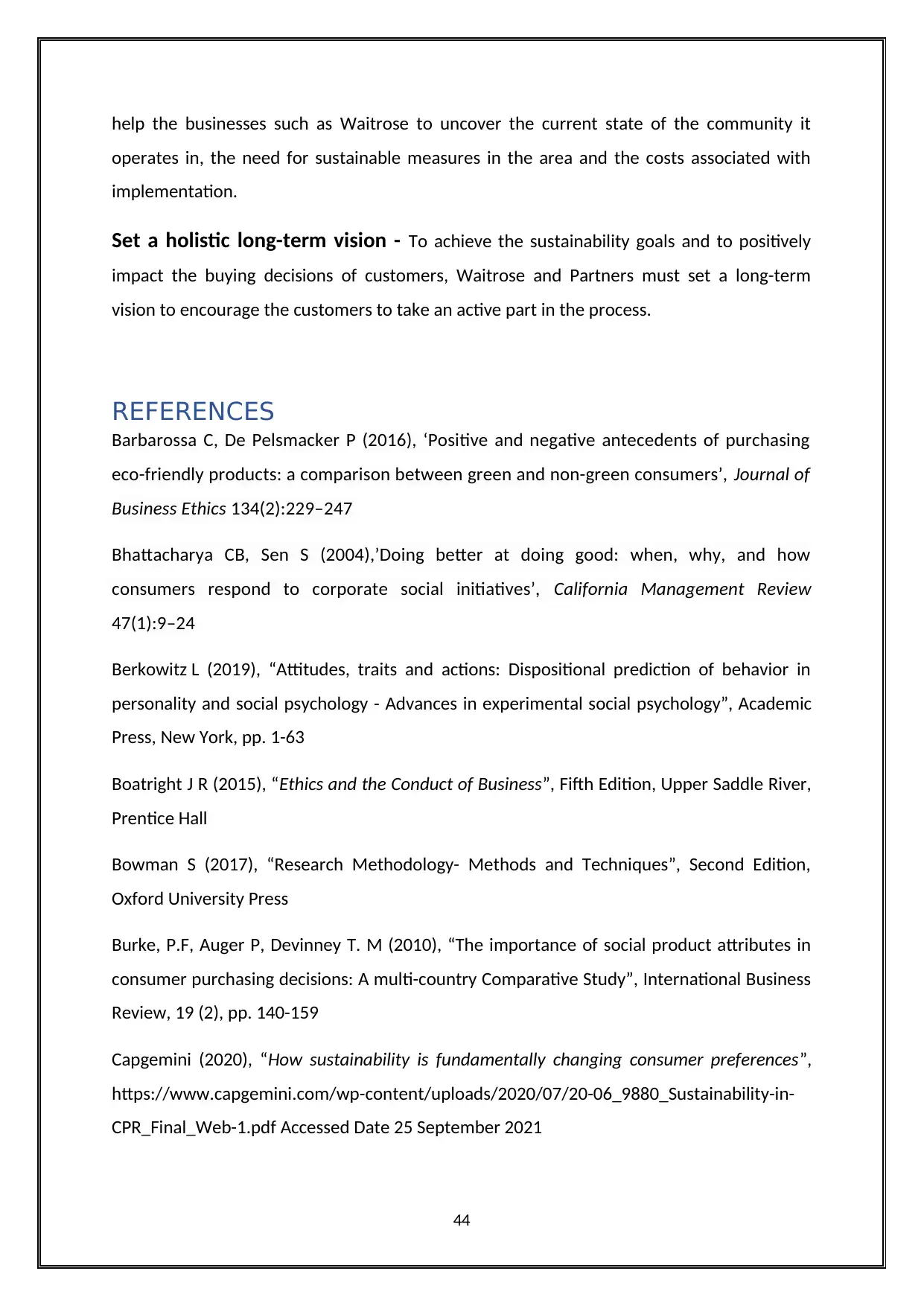
help the businesses such as Waitrose to uncover the current state of the community it
operates in, the need for sustainable measures in the area and the costs associated with
implementation.
Set a holistic long-term vision - To achieve the sustainability goals and to positively
impact the buying decisions of customers, Waitrose and Partners must set a long-term
vision to encourage the customers to take an active part in the process.
REFERENCES
Barbarossa C, De Pelsmacker P (2016), ‘Positive and negative antecedents of purchasing
eco-friendly products: a comparison between green and non-green consumers’, Journal of
Business Ethics 134(2):229–247
Bhattacharya CB, Sen S (2004),’Doing better at doing good: when, why, and how
consumers respond to corporate social initiatives’, California Management Review
47(1):9–24
Berkowitz L (2019), “Attitudes, traits and actions: Dispositional prediction of behavior in
personality and social psychology - Advances in experimental social psychology”, Academic
Press, New York, pp. 1-63
Boatright J R (2015), “Ethics and the Conduct of Business”, Fifth Edition, Upper Saddle River,
Prentice Hall
Bowman S (2017), “Research Methodology- Methods and Techniques”, Second Edition,
Oxford University Press
Burke, P.F, Auger P, Devinney T. M (2010), “The importance of social product attributes in
consumer purchasing decisions: A multi-country Comparative Study”, International Business
Review, 19 (2), pp. 140-159
Capgemini (2020), “How sustainability is fundamentally changing consumer preferences”,
https://www.capgemini.com/wp-content/uploads/2020/07/20-06_9880_Sustainability-in-
CPR_Final_Web-1.pdf Accessed Date 25 September 2021
44
operates in, the need for sustainable measures in the area and the costs associated with
implementation.
Set a holistic long-term vision - To achieve the sustainability goals and to positively
impact the buying decisions of customers, Waitrose and Partners must set a long-term
vision to encourage the customers to take an active part in the process.
REFERENCES
Barbarossa C, De Pelsmacker P (2016), ‘Positive and negative antecedents of purchasing
eco-friendly products: a comparison between green and non-green consumers’, Journal of
Business Ethics 134(2):229–247
Bhattacharya CB, Sen S (2004),’Doing better at doing good: when, why, and how
consumers respond to corporate social initiatives’, California Management Review
47(1):9–24
Berkowitz L (2019), “Attitudes, traits and actions: Dispositional prediction of behavior in
personality and social psychology - Advances in experimental social psychology”, Academic
Press, New York, pp. 1-63
Boatright J R (2015), “Ethics and the Conduct of Business”, Fifth Edition, Upper Saddle River,
Prentice Hall
Bowman S (2017), “Research Methodology- Methods and Techniques”, Second Edition,
Oxford University Press
Burke, P.F, Auger P, Devinney T. M (2010), “The importance of social product attributes in
consumer purchasing decisions: A multi-country Comparative Study”, International Business
Review, 19 (2), pp. 140-159
Capgemini (2020), “How sustainability is fundamentally changing consumer preferences”,
https://www.capgemini.com/wp-content/uploads/2020/07/20-06_9880_Sustainability-in-
CPR_Final_Web-1.pdf Accessed Date 25 September 2021
44
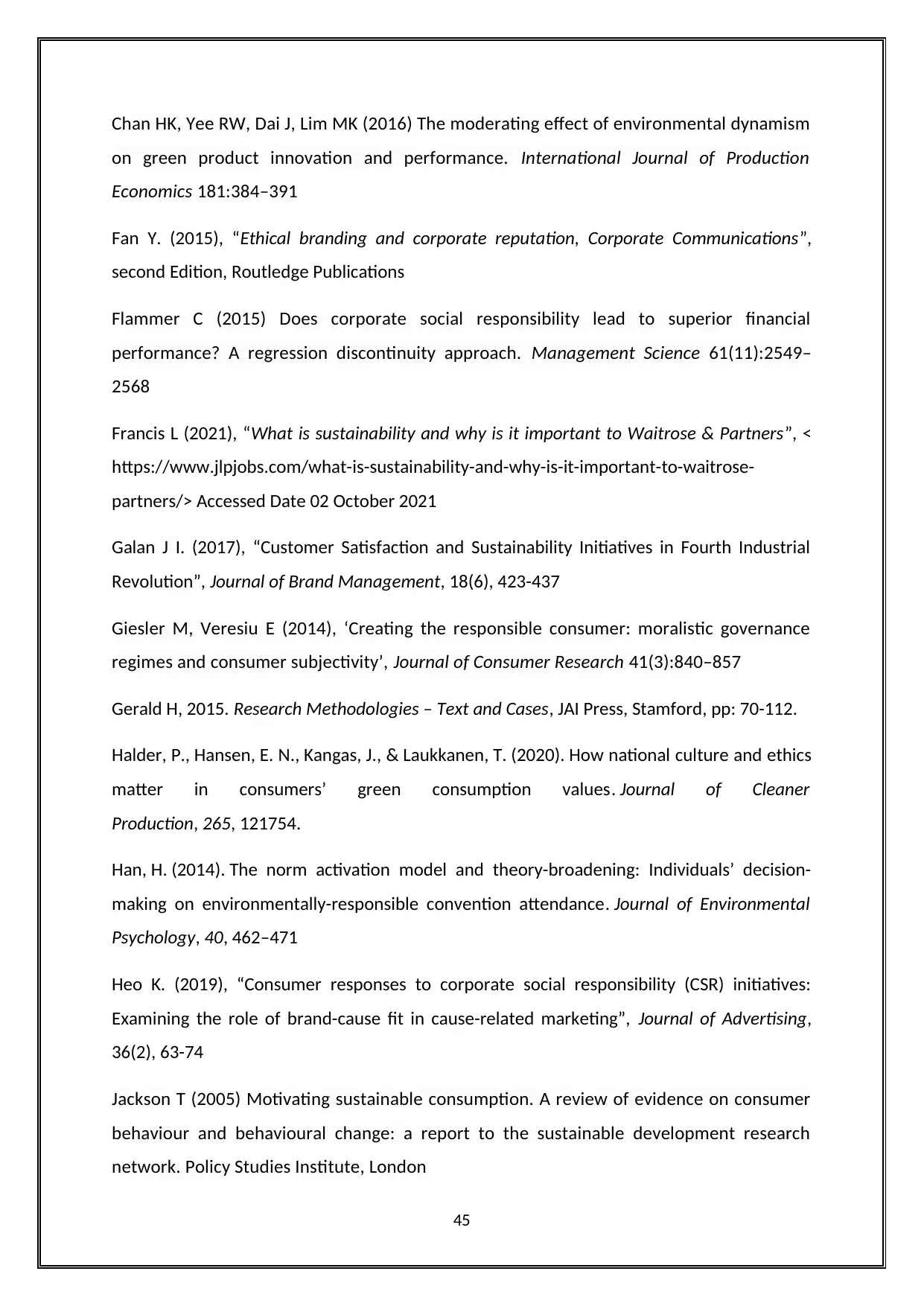
Chan HK, Yee RW, Dai J, Lim MK (2016) The moderating effect of environmental dynamism
on green product innovation and performance. International Journal of Production
Economics 181:384–391
Fan Y. (2015), “Ethical branding and corporate reputation, Corporate Communications”,
second Edition, Routledge Publications
Flammer C (2015) Does corporate social responsibility lead to superior financial
performance? A regression discontinuity approach. Management Science 61(11):2549–
2568
Francis L (2021), “What is sustainability and why is it important to Waitrose & Partners”, <
https://www.jlpjobs.com/what-is-sustainability-and-why-is-it-important-to-waitrose-
partners/> Accessed Date 02 October 2021
Galan J I. (2017), “Customer Satisfaction and Sustainability Initiatives in Fourth Industrial
Revolution”, Journal of Brand Management, 18(6), 423-437
Giesler M, Veresiu E (2014), ‘Creating the responsible consumer: moralistic governance
regimes and consumer subjectivity’, Journal of Consumer Research 41(3):840–857
Gerald H, 2015. Research Methodologies – Text and Cases, JAI Press, Stamford, pp: 70-112.
Halder, P., Hansen, E. N., Kangas, J., & Laukkanen, T. (2020). How national culture and ethics
matter in consumers’ green consumption values. Journal of Cleaner
Production, 265, 121754.
Han, H. (2014). The norm activation model and theory-broadening: Individuals’ decision-
making on environmentally-responsible convention attendance. Journal of Environmental
Psychology, 40, 462–471
Heo K. (2019), “Consumer responses to corporate social responsibility (CSR) initiatives:
Examining the role of brand-cause fit in cause-related marketing”, Journal of Advertising,
36(2), 63-74
Jackson T (2005) Motivating sustainable consumption. A review of evidence on consumer
behaviour and behavioural change: a report to the sustainable development research
network. Policy Studies Institute, London
45
on green product innovation and performance. International Journal of Production
Economics 181:384–391
Fan Y. (2015), “Ethical branding and corporate reputation, Corporate Communications”,
second Edition, Routledge Publications
Flammer C (2015) Does corporate social responsibility lead to superior financial
performance? A regression discontinuity approach. Management Science 61(11):2549–
2568
Francis L (2021), “What is sustainability and why is it important to Waitrose & Partners”, <
https://www.jlpjobs.com/what-is-sustainability-and-why-is-it-important-to-waitrose-
partners/> Accessed Date 02 October 2021
Galan J I. (2017), “Customer Satisfaction and Sustainability Initiatives in Fourth Industrial
Revolution”, Journal of Brand Management, 18(6), 423-437
Giesler M, Veresiu E (2014), ‘Creating the responsible consumer: moralistic governance
regimes and consumer subjectivity’, Journal of Consumer Research 41(3):840–857
Gerald H, 2015. Research Methodologies – Text and Cases, JAI Press, Stamford, pp: 70-112.
Halder, P., Hansen, E. N., Kangas, J., & Laukkanen, T. (2020). How national culture and ethics
matter in consumers’ green consumption values. Journal of Cleaner
Production, 265, 121754.
Han, H. (2014). The norm activation model and theory-broadening: Individuals’ decision-
making on environmentally-responsible convention attendance. Journal of Environmental
Psychology, 40, 462–471
Heo K. (2019), “Consumer responses to corporate social responsibility (CSR) initiatives:
Examining the role of brand-cause fit in cause-related marketing”, Journal of Advertising,
36(2), 63-74
Jackson T (2005) Motivating sustainable consumption. A review of evidence on consumer
behaviour and behavioural change: a report to the sustainable development research
network. Policy Studies Institute, London
45

Joshi, Y., & Rahman, Z. (2015). Factors affecting green purchase behaviour and future
research directions. International Strategic Management Review, 3(1-2), 128–143
Katja H. (2019), "Reputation Building: beyond our control? Inferences in consumers' ethical
perception formation", Journal of Consumer Behaviour, 9: 275-292
Klockner, C. A. (2013). A comprehensive model of the psychology of environmental behavior
– A meta-analysis. Global Environmental Change, 23(5), 1028–1038.
Kim S, Gal D (2014) From compensatory consumption to adaptive consumption: the role of
self-acceptance in resolving self-deficits. Journal Consumer Research 41(2):526–542
Kinnear T, Taylor J & Ahmed S (2016), “Ecologically concerned consumers: Who are they?”.,
Journal of Marketing, 112 (8), 20-24
Leary, R. B., Vann, R. J., D., Murphy, P. E., & Sherry, J. F., Jr. (2014). Changing the
marketplace one behavior at a time: Perceived marketplace influence and sustainable
consumption. Journal of Business Research, 67(9), 1953–1958
Leonidou, L. C., Leonidou, C. N., & Kvasova, O. (2010). Antecedents and Outcomes of
Consumer Environmentally Friendly Attitudes and Behaviour. Journal of Marketing
Management, 26(13/14), 1319-1344.
Li Q, Long R, Chen H (2017) Empirical study of the willingness of consumers to purchase
low-carbon products by considering carbon labels: a case study. Journal of Cleaner
Production 161:1237–1250
Mason R O, Mason F M & Culnan M J (2016), “Information and Responsibility: The Ethical
Challenge”, Sage Publications
McDonagh, P., & Prothero, A. (2014). Sustainability Marketing Research: Past, Present and
Future. Journal of Marketing Management, 30(11-12), 1186-1219.
Nguyen, T. N., Lobo, A., & Greenland, S. (2016). Pro-environmental Purchase Behaviour: The
Role of Consumers' Biospheric Values. Journal of Retailing and Consumer Services, 33, 98-
108.
Rensburg G V (2018), “Fundamentals of Research Methodology”, Fourth Edition, Cengage
Learning
46
research directions. International Strategic Management Review, 3(1-2), 128–143
Katja H. (2019), "Reputation Building: beyond our control? Inferences in consumers' ethical
perception formation", Journal of Consumer Behaviour, 9: 275-292
Klockner, C. A. (2013). A comprehensive model of the psychology of environmental behavior
– A meta-analysis. Global Environmental Change, 23(5), 1028–1038.
Kim S, Gal D (2014) From compensatory consumption to adaptive consumption: the role of
self-acceptance in resolving self-deficits. Journal Consumer Research 41(2):526–542
Kinnear T, Taylor J & Ahmed S (2016), “Ecologically concerned consumers: Who are they?”.,
Journal of Marketing, 112 (8), 20-24
Leary, R. B., Vann, R. J., D., Murphy, P. E., & Sherry, J. F., Jr. (2014). Changing the
marketplace one behavior at a time: Perceived marketplace influence and sustainable
consumption. Journal of Business Research, 67(9), 1953–1958
Leonidou, L. C., Leonidou, C. N., & Kvasova, O. (2010). Antecedents and Outcomes of
Consumer Environmentally Friendly Attitudes and Behaviour. Journal of Marketing
Management, 26(13/14), 1319-1344.
Li Q, Long R, Chen H (2017) Empirical study of the willingness of consumers to purchase
low-carbon products by considering carbon labels: a case study. Journal of Cleaner
Production 161:1237–1250
Mason R O, Mason F M & Culnan M J (2016), “Information and Responsibility: The Ethical
Challenge”, Sage Publications
McDonagh, P., & Prothero, A. (2014). Sustainability Marketing Research: Past, Present and
Future. Journal of Marketing Management, 30(11-12), 1186-1219.
Nguyen, T. N., Lobo, A., & Greenland, S. (2016). Pro-environmental Purchase Behaviour: The
Role of Consumers' Biospheric Values. Journal of Retailing and Consumer Services, 33, 98-
108.
Rensburg G V (2018), “Fundamentals of Research Methodology”, Fourth Edition, Cengage
Learning
46
Secure Best Marks with AI Grader
Need help grading? Try our AI Grader for instant feedback on your assignments.
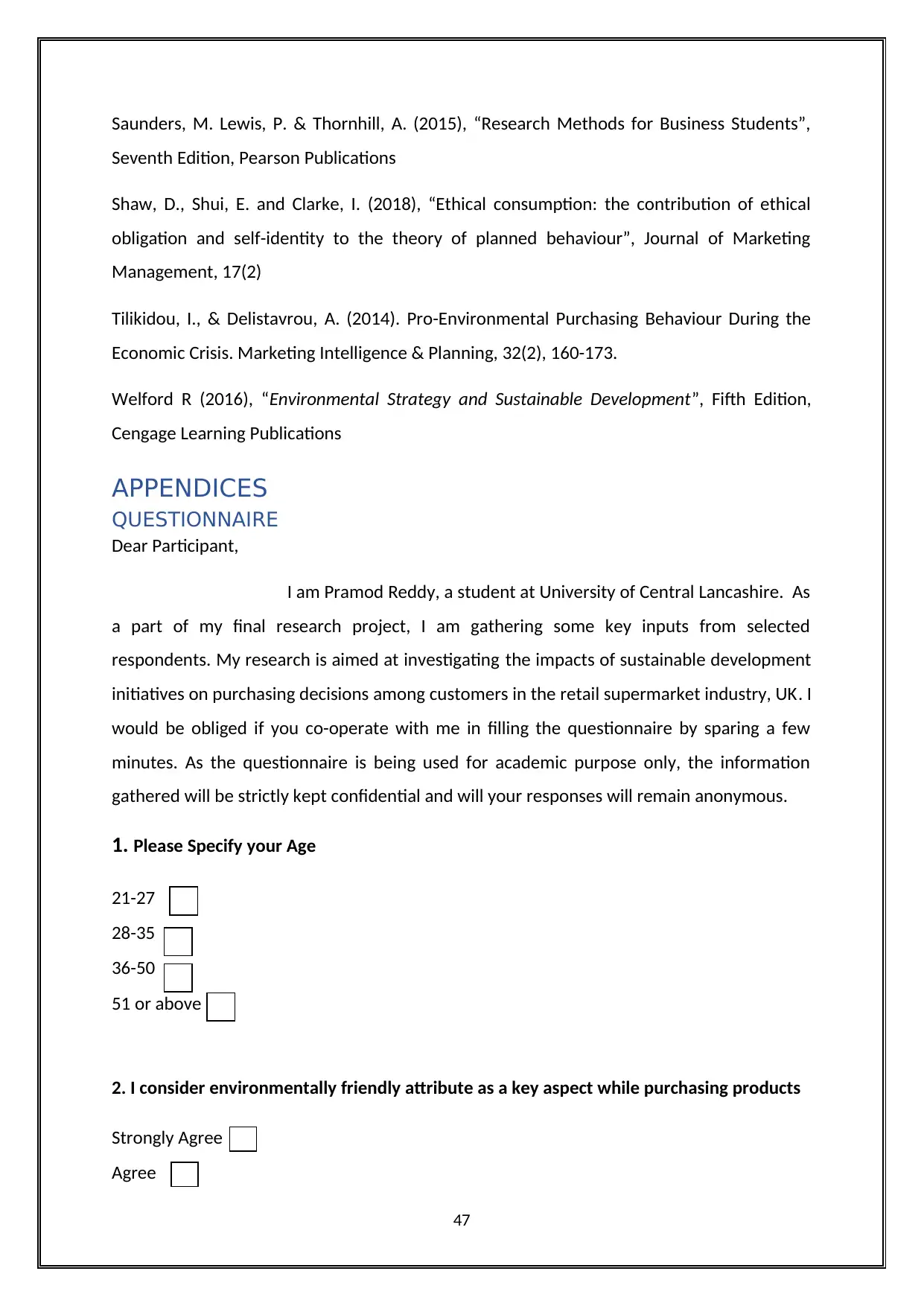
Saunders, M. Lewis, P. & Thornhill, A. (2015), “Research Methods for Business Students”,
Seventh Edition, Pearson Publications
Shaw, D., Shui, E. and Clarke, I. (2018), “Ethical consumption: the contribution of ethical
obligation and self-identity to the theory of planned behaviour”, Journal of Marketing
Management, 17(2)
Tilikidou, I., & Delistavrou, A. (2014). Pro-Environmental Purchasing Behaviour During the
Economic Crisis. Marketing Intelligence & Planning, 32(2), 160-173.
Welford R (2016), “Environmental Strategy and Sustainable Development”, Fifth Edition,
Cengage Learning Publications
APPENDICES
QUESTIONNAIRE
Dear Participant,
I am Pramod Reddy, a student at University of Central Lancashire. As
a part of my final research project, I am gathering some key inputs from selected
respondents. My research is aimed at investigating the impacts of sustainable development
initiatives on purchasing decisions among customers in the retail supermarket industry, UK. I
would be obliged if you co-operate with me in filling the questionnaire by sparing a few
minutes. As the questionnaire is being used for academic purpose only, the information
gathered will be strictly kept confidential and will your responses will remain anonymous.
1. Please Specify your Age
21-27
28-35
36-50
51 or above
2. I consider environmentally friendly attribute as a key aspect while purchasing products
Strongly Agree
Agree
47
Seventh Edition, Pearson Publications
Shaw, D., Shui, E. and Clarke, I. (2018), “Ethical consumption: the contribution of ethical
obligation and self-identity to the theory of planned behaviour”, Journal of Marketing
Management, 17(2)
Tilikidou, I., & Delistavrou, A. (2014). Pro-Environmental Purchasing Behaviour During the
Economic Crisis. Marketing Intelligence & Planning, 32(2), 160-173.
Welford R (2016), “Environmental Strategy and Sustainable Development”, Fifth Edition,
Cengage Learning Publications
APPENDICES
QUESTIONNAIRE
Dear Participant,
I am Pramod Reddy, a student at University of Central Lancashire. As
a part of my final research project, I am gathering some key inputs from selected
respondents. My research is aimed at investigating the impacts of sustainable development
initiatives on purchasing decisions among customers in the retail supermarket industry, UK. I
would be obliged if you co-operate with me in filling the questionnaire by sparing a few
minutes. As the questionnaire is being used for academic purpose only, the information
gathered will be strictly kept confidential and will your responses will remain anonymous.
1. Please Specify your Age
21-27
28-35
36-50
51 or above
2. I consider environmentally friendly attribute as a key aspect while purchasing products
Strongly Agree
Agree
47
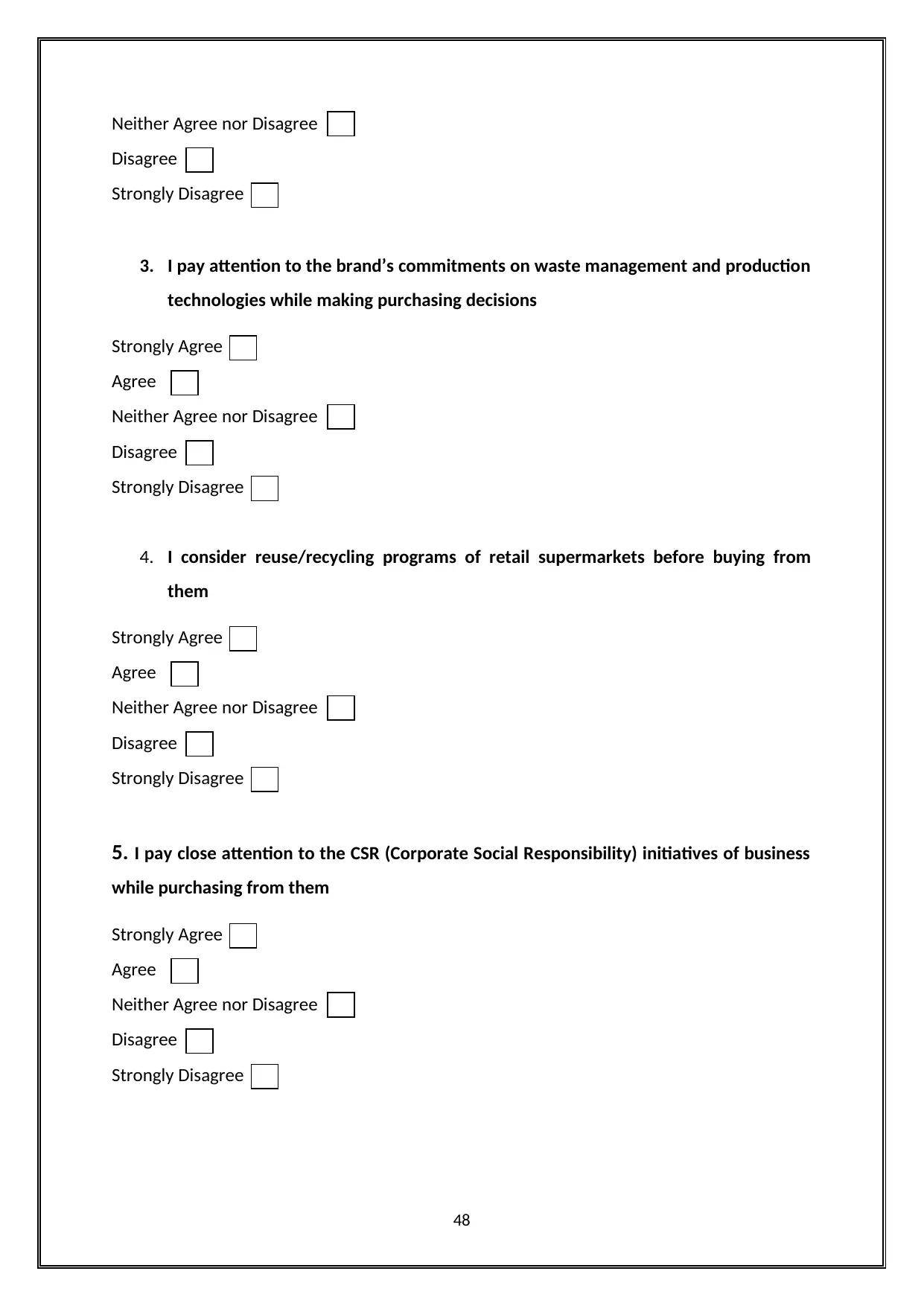
Neither Agree nor Disagree
Disagree
Strongly Disagree
3. I pay attention to the brand’s commitments on waste management and production
technologies while making purchasing decisions
Strongly Agree
Agree
Neither Agree nor Disagree
Disagree
Strongly Disagree
4. I consider reuse/recycling programs of retail supermarkets before buying from
them
Strongly Agree
Agree
Neither Agree nor Disagree
Disagree
Strongly Disagree
5. I pay close attention to the CSR (Corporate Social Responsibility) initiatives of business
while purchasing from them
Strongly Agree
Agree
Neither Agree nor Disagree
Disagree
Strongly Disagree
48
Disagree
Strongly Disagree
3. I pay attention to the brand’s commitments on waste management and production
technologies while making purchasing decisions
Strongly Agree
Agree
Neither Agree nor Disagree
Disagree
Strongly Disagree
4. I consider reuse/recycling programs of retail supermarkets before buying from
them
Strongly Agree
Agree
Neither Agree nor Disagree
Disagree
Strongly Disagree
5. I pay close attention to the CSR (Corporate Social Responsibility) initiatives of business
while purchasing from them
Strongly Agree
Agree
Neither Agree nor Disagree
Disagree
Strongly Disagree
48
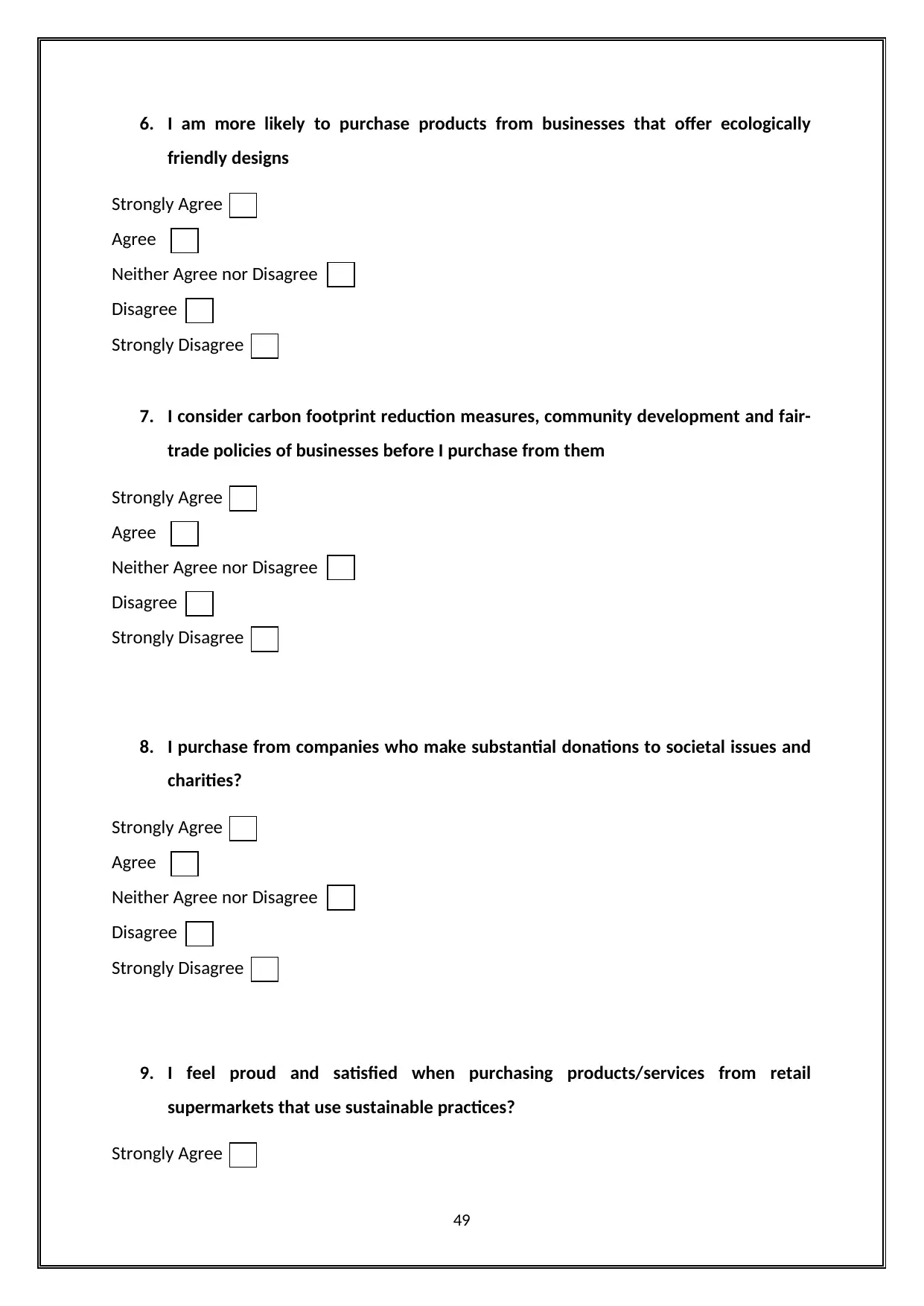
6. I am more likely to purchase products from businesses that offer ecologically
friendly designs
Strongly Agree
Agree
Neither Agree nor Disagree
Disagree
Strongly Disagree
7. I consider carbon footprint reduction measures, community development and fair-
trade policies of businesses before I purchase from them
Strongly Agree
Agree
Neither Agree nor Disagree
Disagree
Strongly Disagree
8. I purchase from companies who make substantial donations to societal issues and
charities?
Strongly Agree
Agree
Neither Agree nor Disagree
Disagree
Strongly Disagree
9. I feel proud and satisfied when purchasing products/services from retail
supermarkets that use sustainable practices?
Strongly Agree
49
friendly designs
Strongly Agree
Agree
Neither Agree nor Disagree
Disagree
Strongly Disagree
7. I consider carbon footprint reduction measures, community development and fair-
trade policies of businesses before I purchase from them
Strongly Agree
Agree
Neither Agree nor Disagree
Disagree
Strongly Disagree
8. I purchase from companies who make substantial donations to societal issues and
charities?
Strongly Agree
Agree
Neither Agree nor Disagree
Disagree
Strongly Disagree
9. I feel proud and satisfied when purchasing products/services from retail
supermarkets that use sustainable practices?
Strongly Agree
49
Paraphrase This Document
Need a fresh take? Get an instant paraphrase of this document with our AI Paraphraser
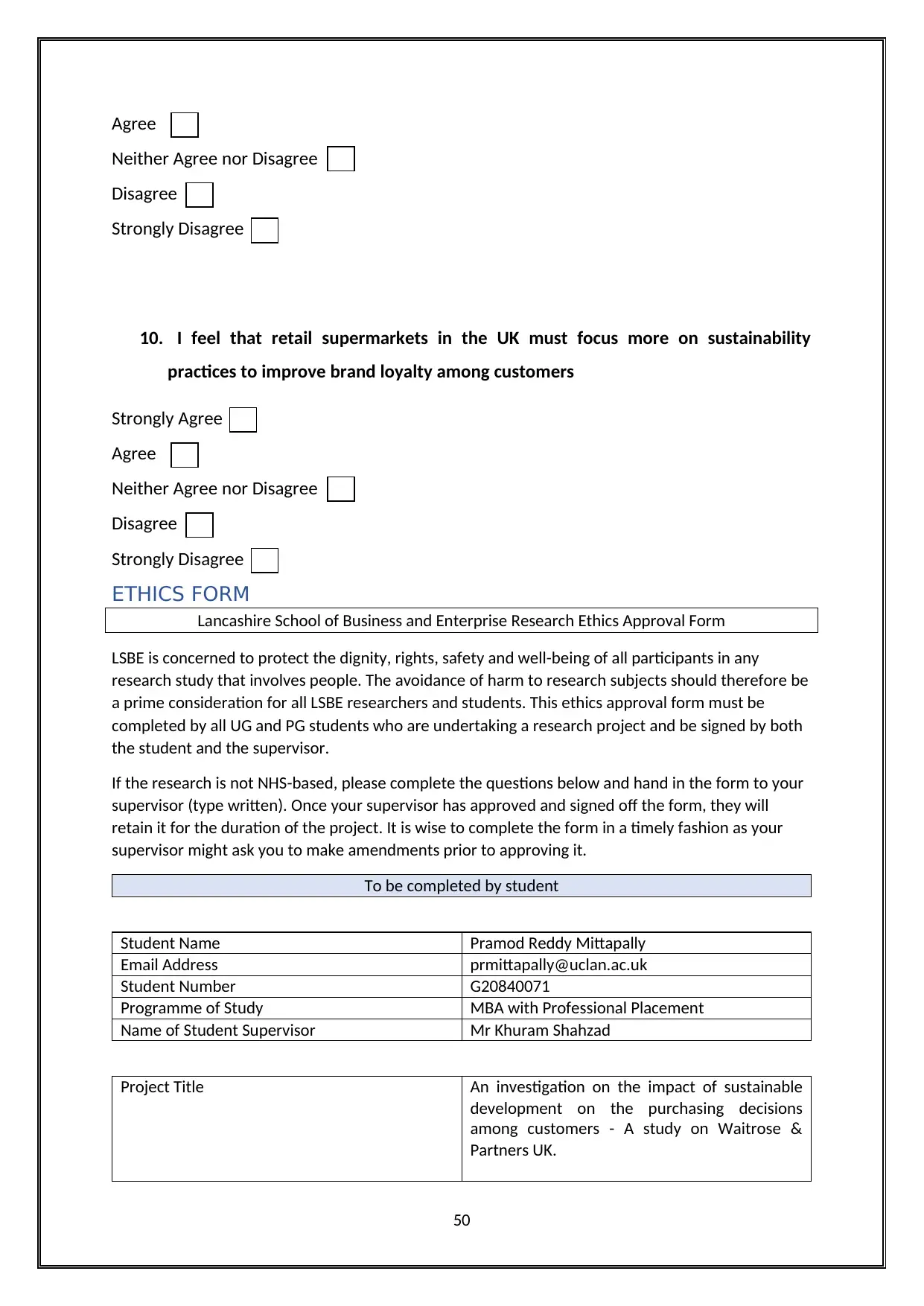
Agree
Neither Agree nor Disagree
Disagree
Strongly Disagree
10. I feel that retail supermarkets in the UK must focus more on sustainability
practices to improve brand loyalty among customers
Strongly Agree
Agree
Neither Agree nor Disagree
Disagree
Strongly Disagree
ETHICS FORM
Lancashire School of Business and Enterprise Research Ethics Approval Form
LSBE is concerned to protect the dignity, rights, safety and well-being of all participants in any
research study that involves people. The avoidance of harm to research subjects should therefore be
a prime consideration for all LSBE researchers and students. This ethics approval form must be
completed by all UG and PG students who are undertaking a research project and be signed by both
the student and the supervisor.
If the research is not NHS-based, please complete the questions below and hand in the form to your
supervisor (type written). Once your supervisor has approved and signed off the form, they will
retain it for the duration of the project. It is wise to complete the form in a timely fashion as your
supervisor might ask you to make amendments prior to approving it.
To be completed by student
Student Name Pramod Reddy Mittapally
Email Address prmittapally@uclan.ac.uk
Student Number G20840071
Programme of Study MBA with Professional Placement
Name of Student Supervisor Mr Khuram Shahzad
Project Title An investigation on the impact of sustainable
development on the purchasing decisions
among customers - A study on Waitrose &
Partners UK.
50
Neither Agree nor Disagree
Disagree
Strongly Disagree
10. I feel that retail supermarkets in the UK must focus more on sustainability
practices to improve brand loyalty among customers
Strongly Agree
Agree
Neither Agree nor Disagree
Disagree
Strongly Disagree
ETHICS FORM
Lancashire School of Business and Enterprise Research Ethics Approval Form
LSBE is concerned to protect the dignity, rights, safety and well-being of all participants in any
research study that involves people. The avoidance of harm to research subjects should therefore be
a prime consideration for all LSBE researchers and students. This ethics approval form must be
completed by all UG and PG students who are undertaking a research project and be signed by both
the student and the supervisor.
If the research is not NHS-based, please complete the questions below and hand in the form to your
supervisor (type written). Once your supervisor has approved and signed off the form, they will
retain it for the duration of the project. It is wise to complete the form in a timely fashion as your
supervisor might ask you to make amendments prior to approving it.
To be completed by student
Student Name Pramod Reddy Mittapally
Email Address prmittapally@uclan.ac.uk
Student Number G20840071
Programme of Study MBA with Professional Placement
Name of Student Supervisor Mr Khuram Shahzad
Project Title An investigation on the impact of sustainable
development on the purchasing decisions
among customers - A study on Waitrose &
Partners UK.
50
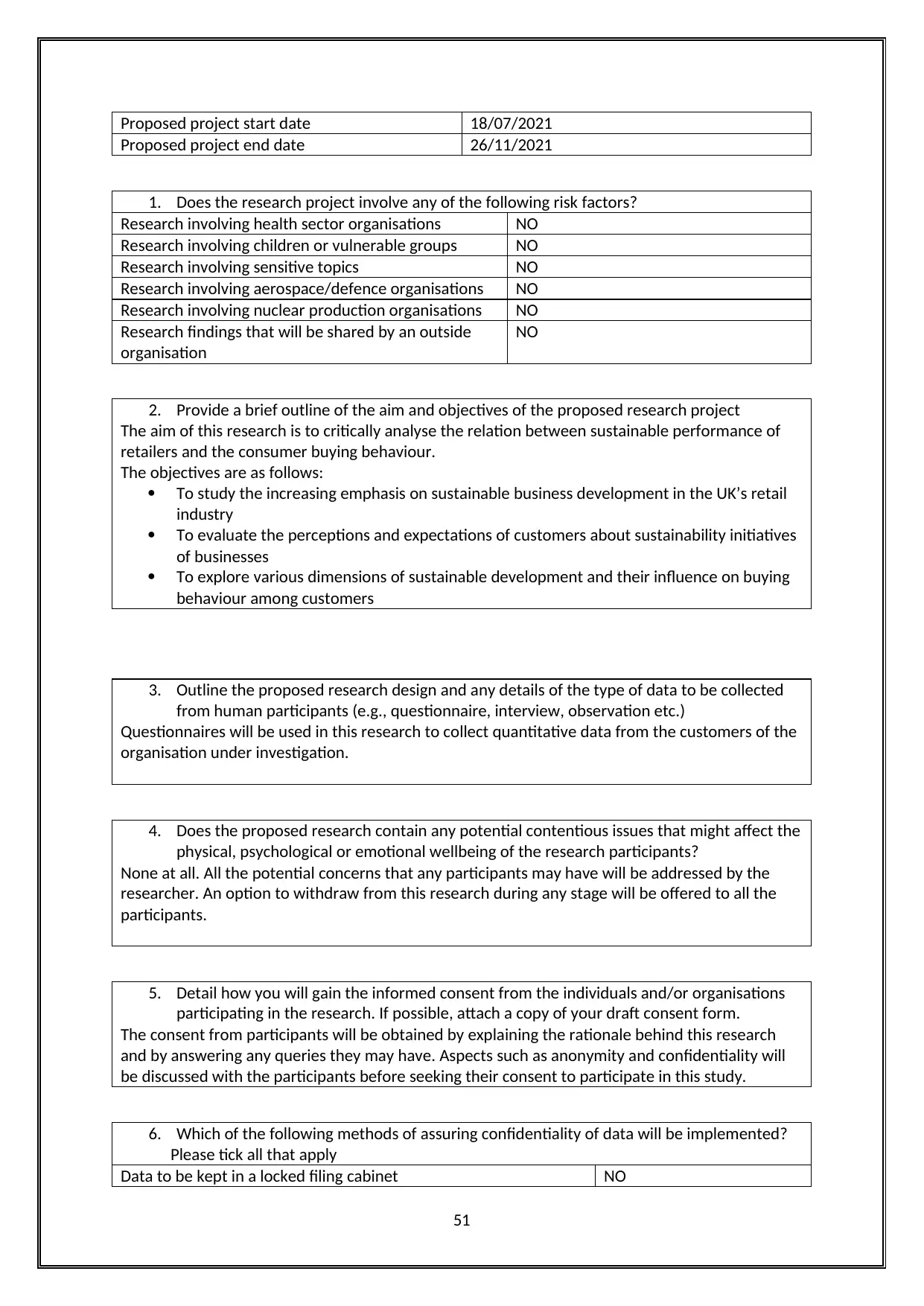
Proposed project start date 18/07/2021
Proposed project end date 26/11/2021
1. Does the research project involve any of the following risk factors?
Research involving health sector organisations NO
Research involving children or vulnerable groups NO
Research involving sensitive topics NO
Research involving aerospace/defence organisations NO
Research involving nuclear production organisations NO
Research findings that will be shared by an outside
organisation
NO
2. Provide a brief outline of the aim and objectives of the proposed research project
The aim of this research is to critically analyse the relation between sustainable performance of
retailers and the consumer buying behaviour.
The objectives are as follows:
To study the increasing emphasis on sustainable business development in the UK’s retail
industry
To evaluate the perceptions and expectations of customers about sustainability initiatives
of businesses
To explore various dimensions of sustainable development and their influence on buying
behaviour among customers
3. Outline the proposed research design and any details of the type of data to be collected
from human participants (e.g., questionnaire, interview, observation etc.)
Questionnaires will be used in this research to collect quantitative data from the customers of the
organisation under investigation.
4. Does the proposed research contain any potential contentious issues that might affect the
physical, psychological or emotional wellbeing of the research participants?
None at all. All the potential concerns that any participants may have will be addressed by the
researcher. An option to withdraw from this research during any stage will be offered to all the
participants.
5. Detail how you will gain the informed consent from the individuals and/or organisations
participating in the research. If possible, attach a copy of your draft consent form.
The consent from participants will be obtained by explaining the rationale behind this research
and by answering any queries they may have. Aspects such as anonymity and confidentiality will
be discussed with the participants before seeking their consent to participate in this study.
6. Which of the following methods of assuring confidentiality of data will be implemented?
Please tick all that apply
Data to be kept in a locked filing cabinet NO
51
Proposed project end date 26/11/2021
1. Does the research project involve any of the following risk factors?
Research involving health sector organisations NO
Research involving children or vulnerable groups NO
Research involving sensitive topics NO
Research involving aerospace/defence organisations NO
Research involving nuclear production organisations NO
Research findings that will be shared by an outside
organisation
NO
2. Provide a brief outline of the aim and objectives of the proposed research project
The aim of this research is to critically analyse the relation between sustainable performance of
retailers and the consumer buying behaviour.
The objectives are as follows:
To study the increasing emphasis on sustainable business development in the UK’s retail
industry
To evaluate the perceptions and expectations of customers about sustainability initiatives
of businesses
To explore various dimensions of sustainable development and their influence on buying
behaviour among customers
3. Outline the proposed research design and any details of the type of data to be collected
from human participants (e.g., questionnaire, interview, observation etc.)
Questionnaires will be used in this research to collect quantitative data from the customers of the
organisation under investigation.
4. Does the proposed research contain any potential contentious issues that might affect the
physical, psychological or emotional wellbeing of the research participants?
None at all. All the potential concerns that any participants may have will be addressed by the
researcher. An option to withdraw from this research during any stage will be offered to all the
participants.
5. Detail how you will gain the informed consent from the individuals and/or organisations
participating in the research. If possible, attach a copy of your draft consent form.
The consent from participants will be obtained by explaining the rationale behind this research
and by answering any queries they may have. Aspects such as anonymity and confidentiality will
be discussed with the participants before seeking their consent to participate in this study.
6. Which of the following methods of assuring confidentiality of data will be implemented?
Please tick all that apply
Data to be kept in a locked filing cabinet NO
51

Access to computer files to be available by password only
Storage on an encrypted device (e.g., laptop, hard drive, USB)
Storage at other site NO
If stored at another site, please give details
Student Signature Date
Pramod Reddy Mittapally
23-08-2021
Please load this form to Turnitin via Blackboard, pass a copy to your Supervisor and include a copy
when you submit your work in the Appendices
To be completed by supervisor
For the attention of UG and PG Research Supervisors
If you are satisfied that this ethics application can be approved – then sign in the box below and
retain the form for the duration of the research. If there are any ethical issues which you are
uncomfortable with, and in your opinion require additional scrutiny then forward this to:
dmharrison@uclan.ac.uk
Supervisor Signature Date
K.Shahzad 24 August 2021
If you are unable to sign this application form, please briefly state your reasons/concerns which
must be addressed by the student before resubmission.
52
Storage on an encrypted device (e.g., laptop, hard drive, USB)
Storage at other site NO
If stored at another site, please give details
Student Signature Date
Pramod Reddy Mittapally
23-08-2021
Please load this form to Turnitin via Blackboard, pass a copy to your Supervisor and include a copy
when you submit your work in the Appendices
To be completed by supervisor
For the attention of UG and PG Research Supervisors
If you are satisfied that this ethics application can be approved – then sign in the box below and
retain the form for the duration of the research. If there are any ethical issues which you are
uncomfortable with, and in your opinion require additional scrutiny then forward this to:
dmharrison@uclan.ac.uk
Supervisor Signature Date
K.Shahzad 24 August 2021
If you are unable to sign this application form, please briefly state your reasons/concerns which
must be addressed by the student before resubmission.
52
Secure Best Marks with AI Grader
Need help grading? Try our AI Grader for instant feedback on your assignments.
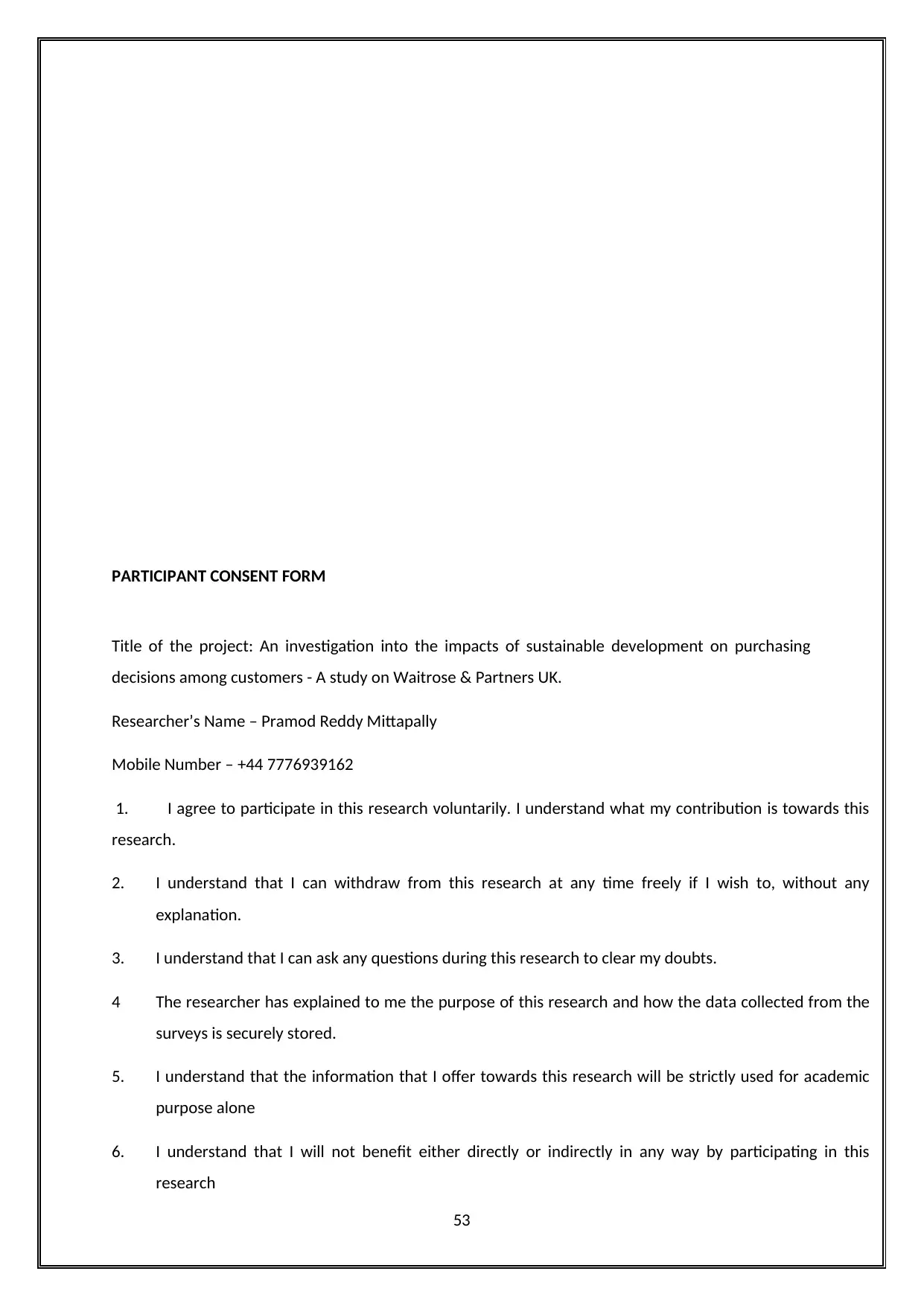
PARTICIPANT CONSENT FORM
Title of the project: An investigation into the impacts of sustainable development on purchasing
decisions among customers - A study on Waitrose & Partners UK.
Researcher’s Name – Pramod Reddy Mittapally
Mobile Number – +44 7776939162
1. I agree to participate in this research voluntarily. I understand what my contribution is towards this
research.
2. I understand that I can withdraw from this research at any time freely if I wish to, without any
explanation.
3. I understand that I can ask any questions during this research to clear my doubts.
4 The researcher has explained to me the purpose of this research and how the data collected from the
surveys is securely stored.
5. I understand that the information that I offer towards this research will be strictly used for academic
purpose alone
6. I understand that I will not benefit either directly or indirectly in any way by participating in this
research
53
Title of the project: An investigation into the impacts of sustainable development on purchasing
decisions among customers - A study on Waitrose & Partners UK.
Researcher’s Name – Pramod Reddy Mittapally
Mobile Number – +44 7776939162
1. I agree to participate in this research voluntarily. I understand what my contribution is towards this
research.
2. I understand that I can withdraw from this research at any time freely if I wish to, without any
explanation.
3. I understand that I can ask any questions during this research to clear my doubts.
4 The researcher has explained to me the purpose of this research and how the data collected from the
surveys is securely stored.
5. I understand that the information that I offer towards this research will be strictly used for academic
purpose alone
6. I understand that I will not benefit either directly or indirectly in any way by participating in this
research
53

Name of participant -
Signature –
54
Signature –
54
1 out of 54
Related Documents
Your All-in-One AI-Powered Toolkit for Academic Success.
+13062052269
info@desklib.com
Available 24*7 on WhatsApp / Email
![[object Object]](/_next/static/media/star-bottom.7253800d.svg)
Unlock your academic potential
© 2024 | Zucol Services PVT LTD | All rights reserved.





